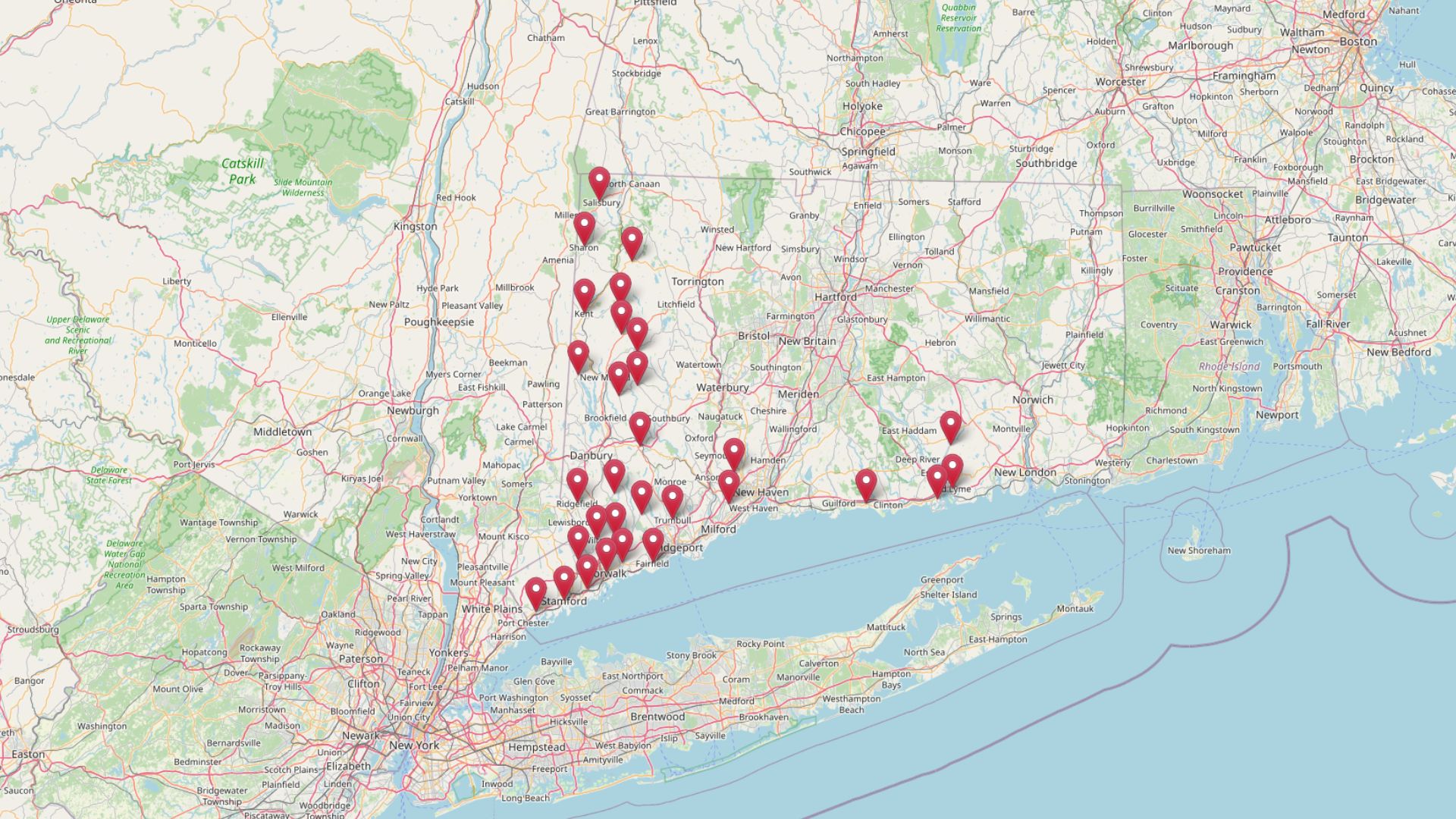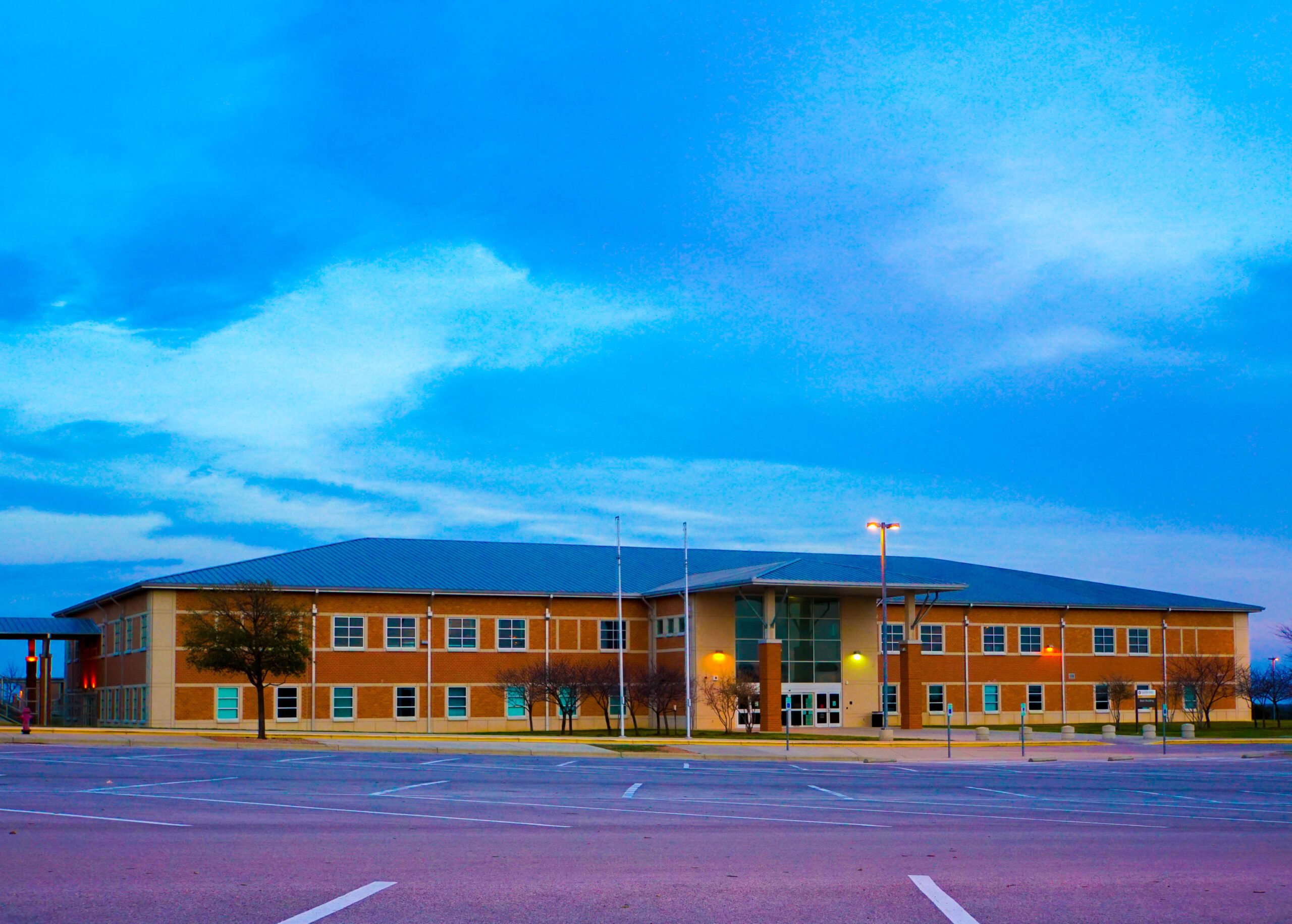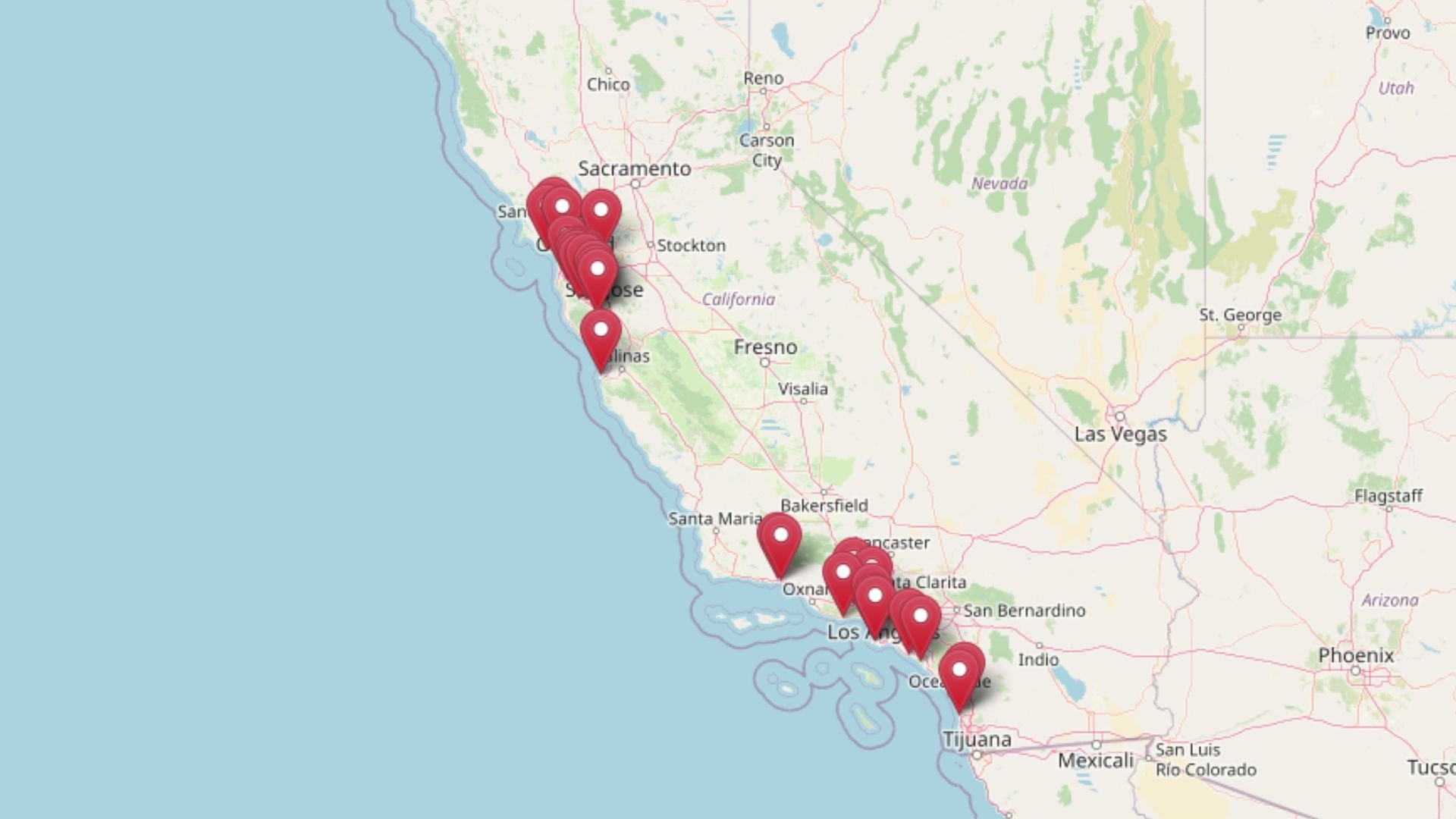
Using the latest Zillow Home Value Index data from 2025, we’ve ranked the 30 most expensive towns in California based on current home prices. These communities represent the pinnacle of American luxury real estate, where median home values stretch from nearly $3 million to over $7 million. Each location tells a story of sustained growth, premium positioning, and exceptional desirability among buyers willing to pay top dollar for California’s finest addresses.
From Silicon Valley tech hubs to coastal enclaves and exclusive gated communities, these towns have experienced remarkable appreciation since 2010. Whether you’re tracking market trends, considering investment opportunities, or simply curious about where California’s housing prices have reached their peak, this comprehensive analysis reveals the forces driving these extraordinary valuations.
30. Palos Verdes Estates – 95% Home Price Increase Since 2010
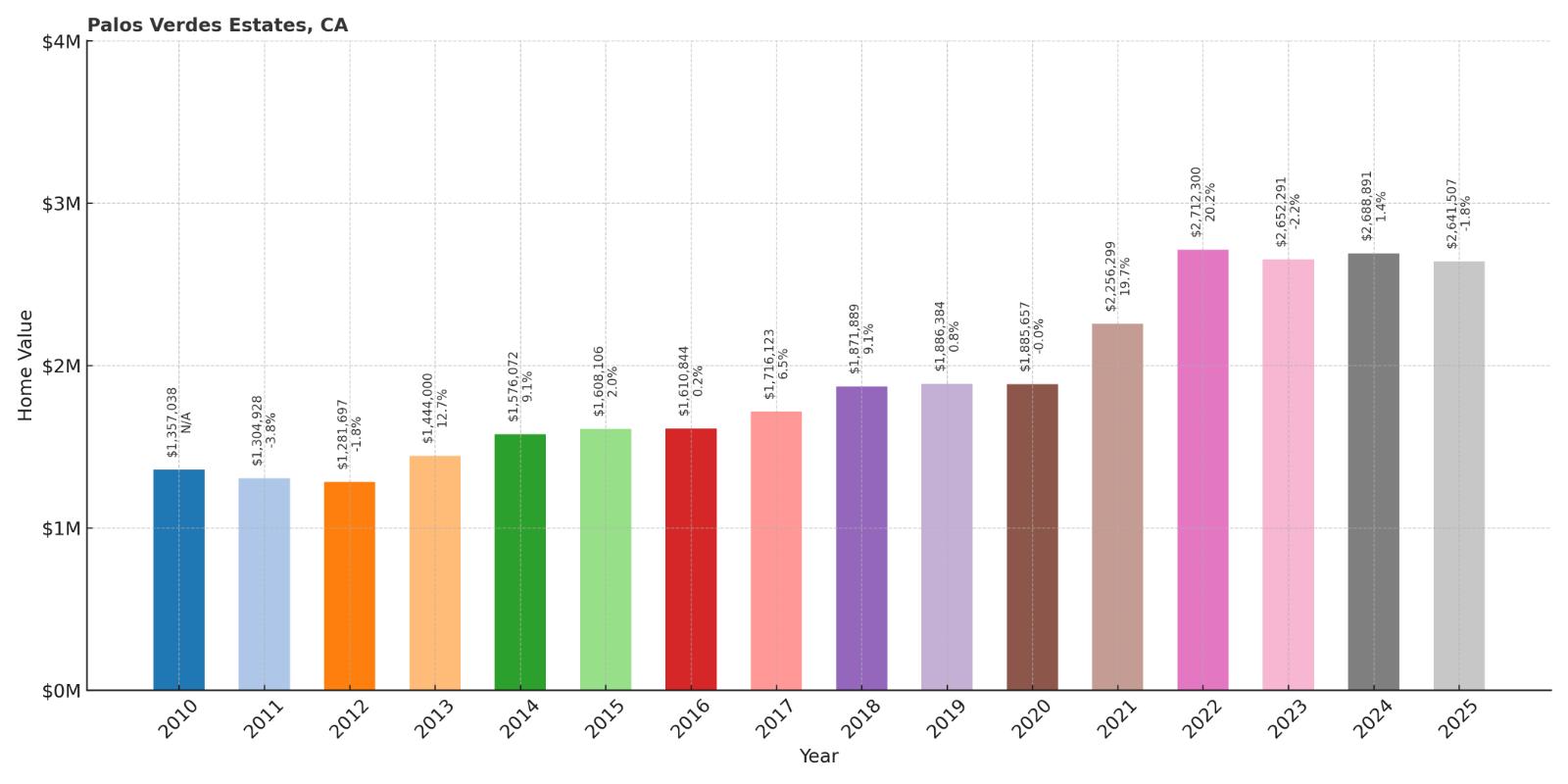
- 2010: $1,357,038
- 2011: $1,304,928
- 2012: $1,281,697
- 2013: $1,444,000
- 2014: $1,576,072
- 2015: $1,608,106
- 2016: $1,610,844
- 2017: $1,716,123
- 2018: $1,871,889
- 2019: $1,886,384
- 2020: $1,885,657
- 2021: $2,256,299
- 2022: $2,712,300
- 2023: $2,652,291
- 2024: $2,688,891
- 2025: $2,641,507
Palos Verdes Estates has shown steady appreciation over the past 15 years, nearly doubling in value since 2010. The community experienced its most dramatic growth during the 2021-2022 period when prices surged over 40%, reaching current median values around $2.64 million. Despite some recent moderation, the town maintains its position as one of Los Angeles County’s premier luxury destinations.
Why Palos Verdes Estates?
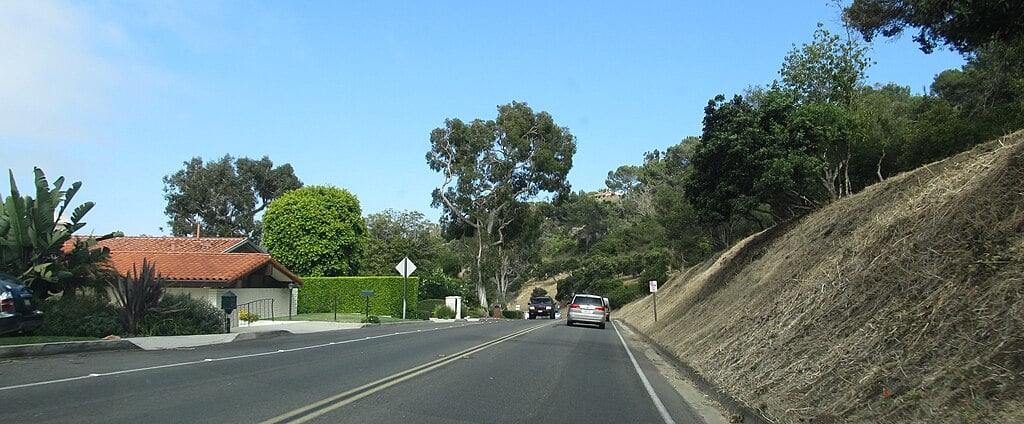
Why are people willing to pay so much to live here? What’s special about it?
Palos Verdes Estates offers an exceptional combination of coastal proximity, architectural distinction, and suburban tranquility that’s rare in Los Angeles County. Families are drawn to the excellent schools, abundant green space, and strong sense of community, while professionals appreciate easy access to both downtown LA and the South Bay. The area features larger lots with custom homes and newer developments that maintain privacy while offering modern amenities.
Unlike denser parts of LA, Palos Verdes Estates has preserved its semi-rural character through careful planning and building restrictions. The community’s commitment to maintaining open space and limiting commercial development helps protect property values while creating a unique residential environment.
How Palos Verdes Estates Rose to Prominence
Palos Verdes Estates was planned in the 1920s as an exclusive residential community on the Palos Verdes Peninsula, designed by the Olmsted Brothers landscape architecture firm. The community was envisioned as a “city beautiful” development that would preserve the natural beauty of the coastal bluffs while creating an upscale residential environment. Early development focused on large estates with Spanish and Mediterranean architectural styles that became the community’s signature look.
The post-World War II suburban boom brought steady growth to the area, as aerospace and defense industry professionals sought quality housing within commuting distance of major employers. The community’s incorporation in 1939 allowed residents to maintain strict building codes and zoning requirements that preserved the area’s character while property values appreciated consistently over the decades.
3 Interesting Tidbits
1. Architectural Controls – The city maintains one of California’s strictest architectural review processes, requiring all new construction and major renovations to conform to Mediterranean Revival and Spanish Colonial styles.
2. Trump National Golf Club – The prestigious Trump National Golf Club Los Angeles sits on the bluffs overlooking the Pacific Ocean, adding to the community’s luxury appeal and property values.
3. Malaga Cove Plaza – The historic shopping center, designed in the 1920s, remains the community’s social and commercial hub, featuring the original Mediterranean architecture and serving as a National Historic Landmark.
29. Emerald Lake Hills – 124% Home Price Increase Since 2010
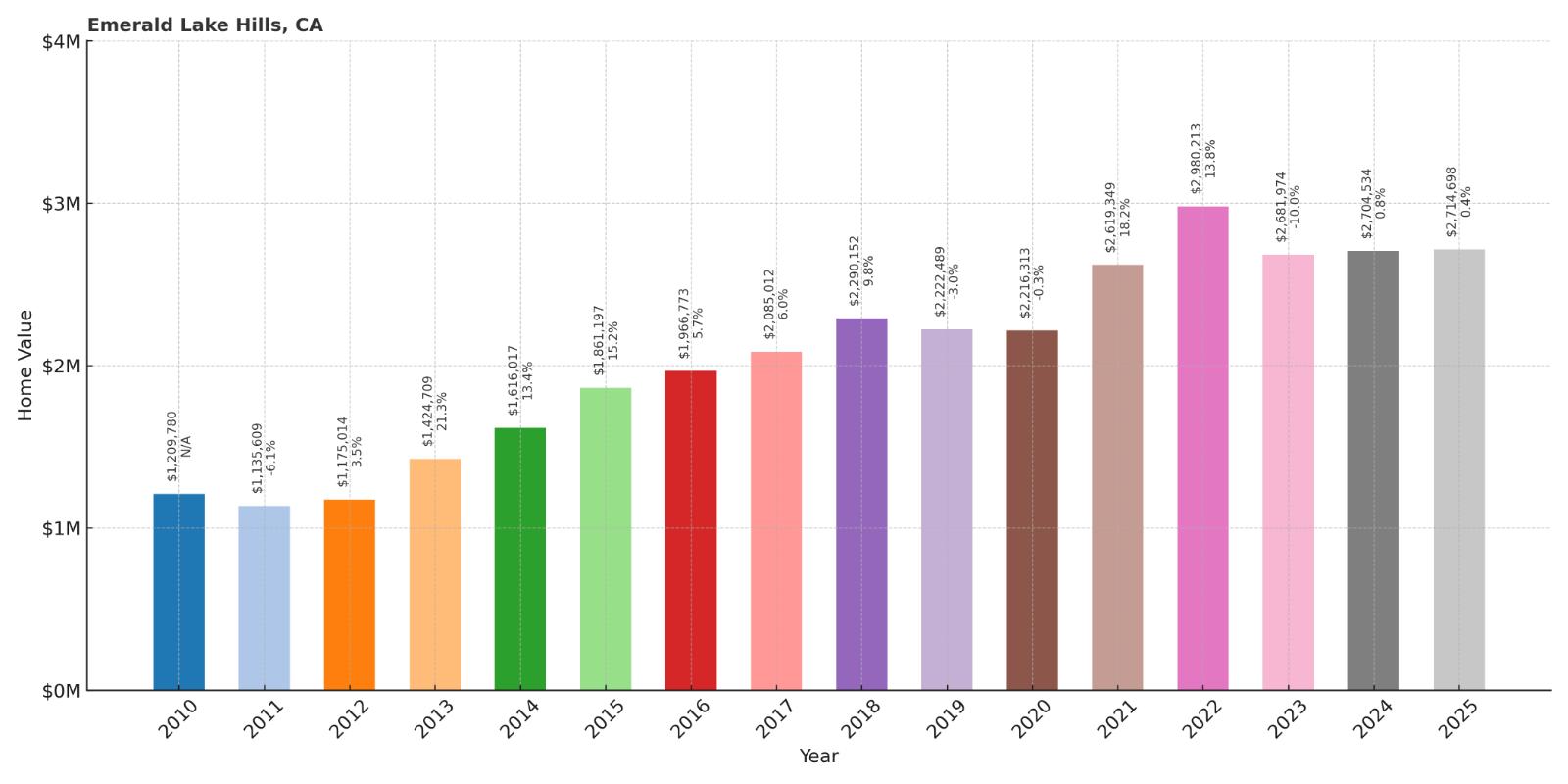
- 2010: $1,209,780
- 2011: $1,135,609
- 2012: $1,175,014
- 2013: $1,424,709
- 2014: $1,616,017
- 2015: $1,861,197
- 2016: $1,966,773
- 2017: $2,085,012
- 2018: $2,290,152
- 2019: $2,222,489
- 2020: $2,216,313
- 2021: $2,619,349
- 2022: $2,980,213
- 2023: $2,681,974
- 2024: $2,704,534
- 2025: $2,714,698
Emerald Lake Hills has more than doubled in value since 2010, with particularly strong growth during the 2015-2016 period and again in 2021-2022. Current median home values around $2.71 million reflect the community’s desirability among San Francisco Bay Area professionals. The market has shown resilience with modest recent gains following the pandemic-era surge.
Why Emerald Lake Hills?
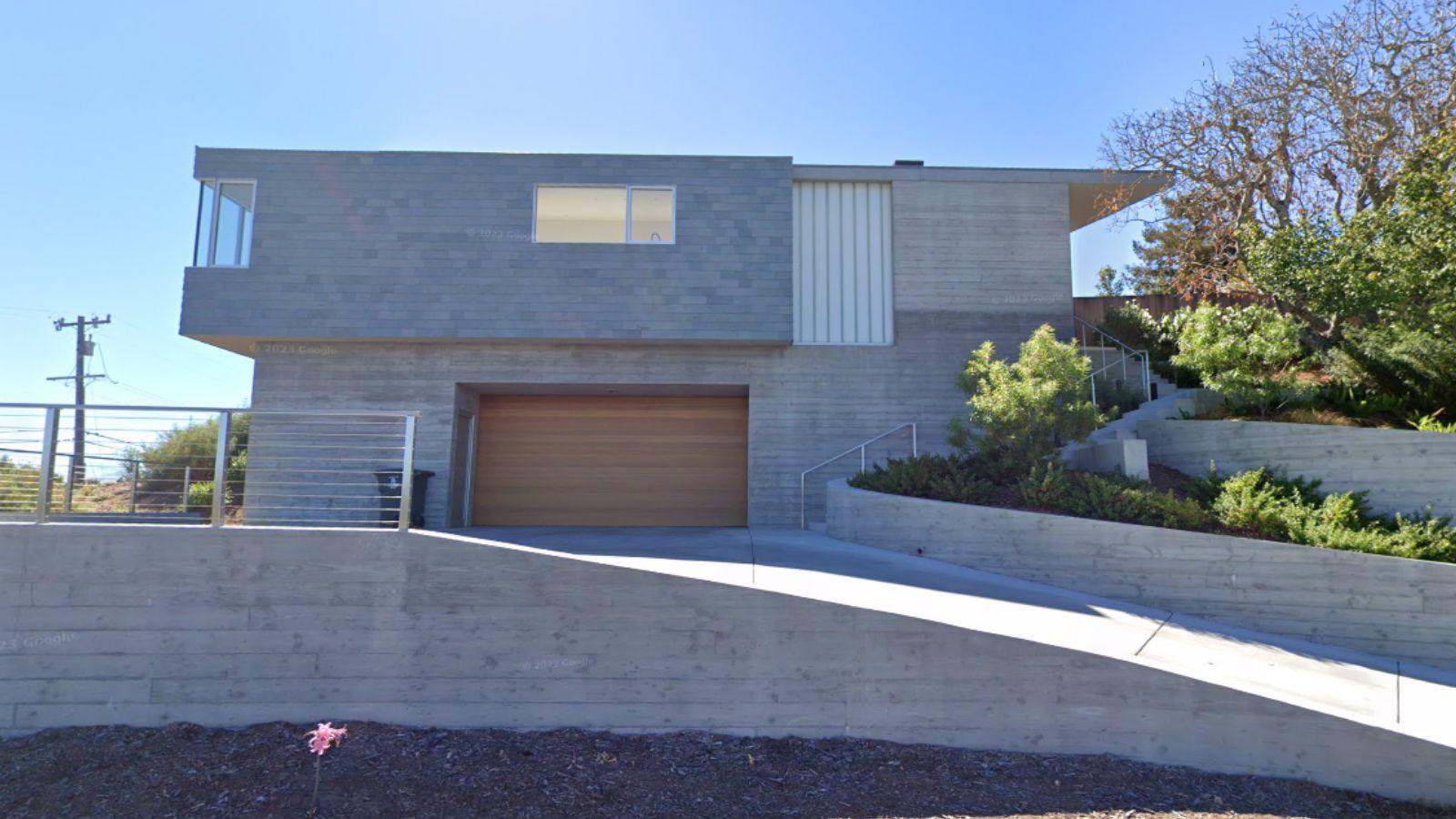
Why are people willing to pay so much to live here? What’s special about it?
Emerald Lake Hills provides a rare suburban oasis in San Mateo County, offering families large lots, mature landscaping, and excellent schools within easy commuting distance of both San Francisco and Silicon Valley. The community features winding roads, custom homes, and natural beauty that creates a resort-like atmosphere. Residents value the privacy and tranquility while maintaining access to major employment centers.
The area’s semi-rural character sets it apart from denser Bay Area suburbs, with many properties featuring horse facilities, gardens, and expansive views. Strong community involvement and neighborhood associations help maintain property values while preserving the area’s unique character.
How Emerald Lake Hills Rose to Prominence
Emerald Lake Hills developed as a premium residential area in the mid-20th century, taking advantage of its hillside location and natural lake to create an exclusive community. The area’s development was carefully planned to preserve natural features while providing large lots suitable for custom homes. Early residents included business executives and professionals who wanted estate-style living within commuting distance of San Francisco.
The community’s growth accelerated during the 1980s and 1990s as Silicon Valley’s tech boom created substantial wealth among nearby professionals. The combination of natural beauty, large lots, and proximity to major employment centers made it increasingly attractive to high-net-worth individuals seeking suburban luxury with easy highway access.
3 Interesting Tidbits
1. Natural Lake – The community centers around a private lake that serves as both a natural amenity and the focal point for many of the area’s most expensive properties.
2. Equestrian Heritage – Many properties still maintain horse facilities and trails, reflecting the area’s history as a rural retreat for wealthy San Francisco families.
3. Architectural Diversity – Unlike many planned communities, Emerald Lake Hills features diverse architectural styles from mid-century modern to contemporary estates, creating visual interest while maintaining cohesive landscaping.
28. Tiburon – 107% Home Price Increase Since 2010
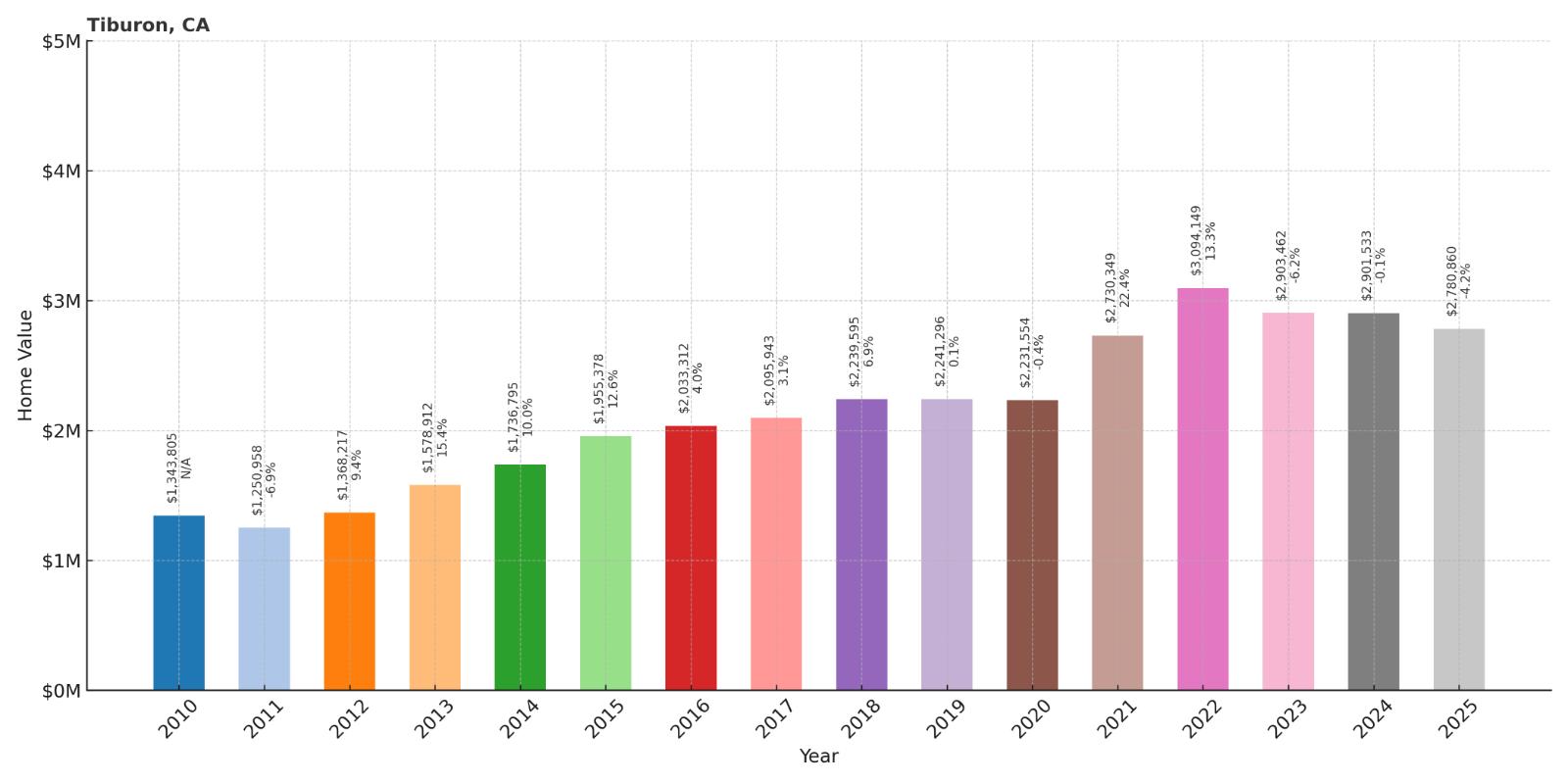
- 2010: $1,343,805
- 2011: $1,250,958
- 2012: $1,368,217
- 2013: $1,578,912
- 2014: $1,736,795
- 2015: $1,955,378
- 2016: $2,033,312
- 2017: $2,095,943
- 2018: $2,239,595
- 2019: $2,241,296
- 2020: $2,231,554
- 2021: $2,730,349
- 2022: $3,094,149
- 2023: $2,903,462
- 2024: $2,901,533
- 2025: $2,780,860
Tiburon has seen home values more than double since 2010, with explosive growth during 2021-2022 when prices jumped over 35% in two years. Current median values around $2.78 million reflect some recent cooling but remain well above historical levels. The waterfront peninsula location continues to command premium pricing despite broader market adjustments.
Why Tiburon?
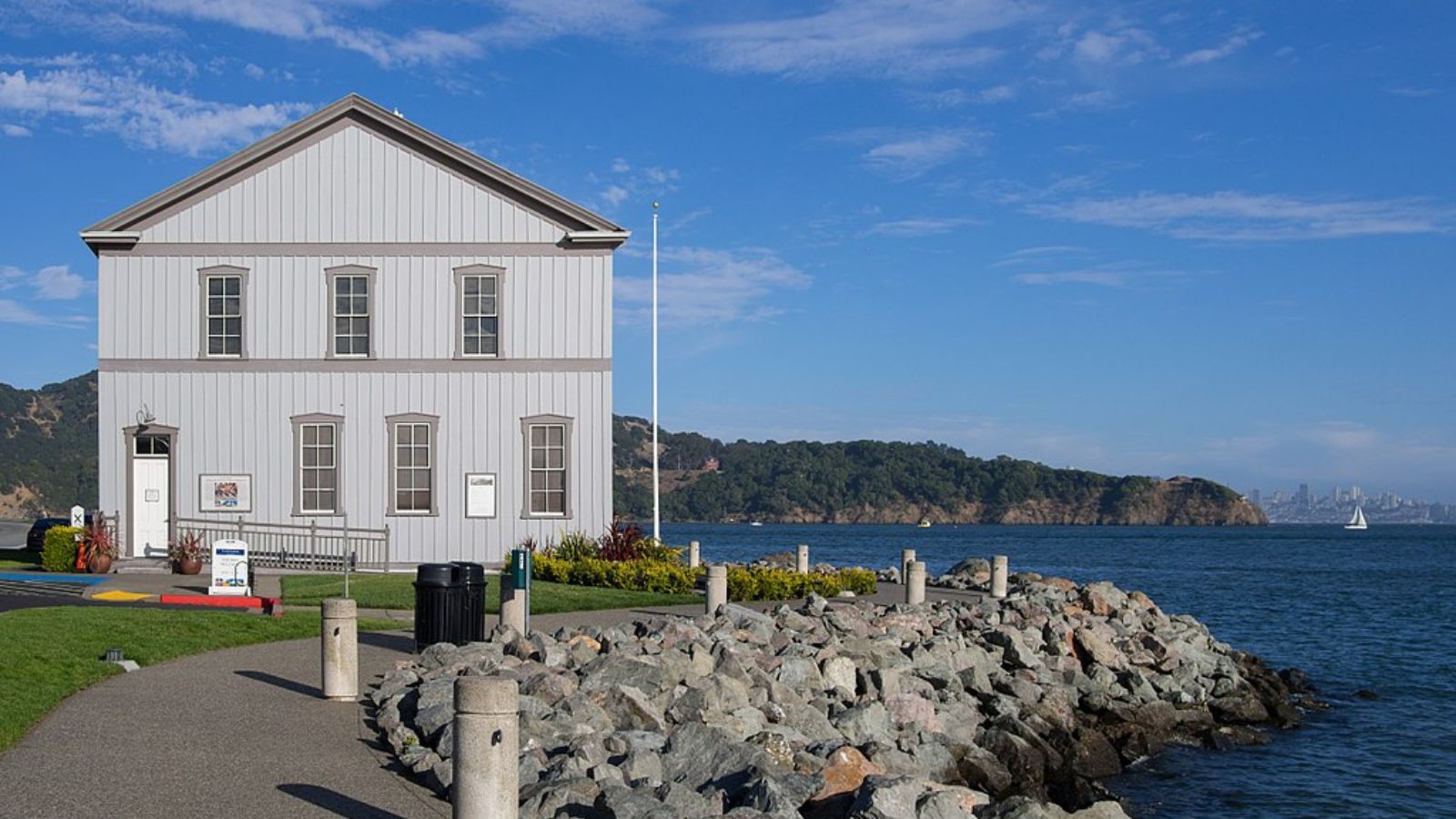
Why are people willing to pay so much to live here? What’s special about it?
Tiburon offers unparalleled waterfront living with sweeping views of San Francisco Bay and the city skyline, combined with easy ferry access to downtown San Francisco. Families appreciate the excellent schools, safe neighborhoods, and Mediterranean-style architecture that creates a resort-like atmosphere. The yacht-filled harbor and upscale dining options add to the community’s sophisticated appeal.
The peninsula location provides both natural beauty and exclusivity, with limited developable waterfront land ensuring property scarcity. Residents enjoy outdoor recreation opportunities including hiking, sailing, and cycling, while maintaining convenient access to urban employment centers.
How Tiburon Rose to Prominence
Tiburon began as a railroad terminus in the 1880s, serving as the connection point between San Francisco ferries and the Northwestern Pacific Railroad. The community’s waterfront location made it an attractive summer retreat for wealthy San Francisco families, who built Victorian mansions along the bay. Early development focused on the natural harbor and panoramic views that remain the area’s primary attractions.
The opening of the Golden Gate Bridge in 1937 and later the Richmond-San Rafael Bridge transformed Tiburon from a ferry-dependent community to an accessible waterfront suburb. Post-war development brought modern homes and condominiums while preserving the area’s nautical character and natural beauty that continues to attract affluent professionals and retirees.
3 Interesting Tidbits
1. Angel Island Views – Many properties offer unobstructed views of Angel Island State Park, providing residents with protected open space and recreational opportunities just offshore.
2. Historic Downtown – The preserved downtown waterfront features converted railroad buildings now housing upscale restaurants and boutiques, maintaining the community’s maritime heritage.
3. Ferry Commuting – Regular ferry service to San Francisco makes Tiburon one of the few Bay Area communities where residents can commute to work by water, avoiding bridge traffic entirely.
27. Del Monte Forest – 107% Home Price Increase Since 2010
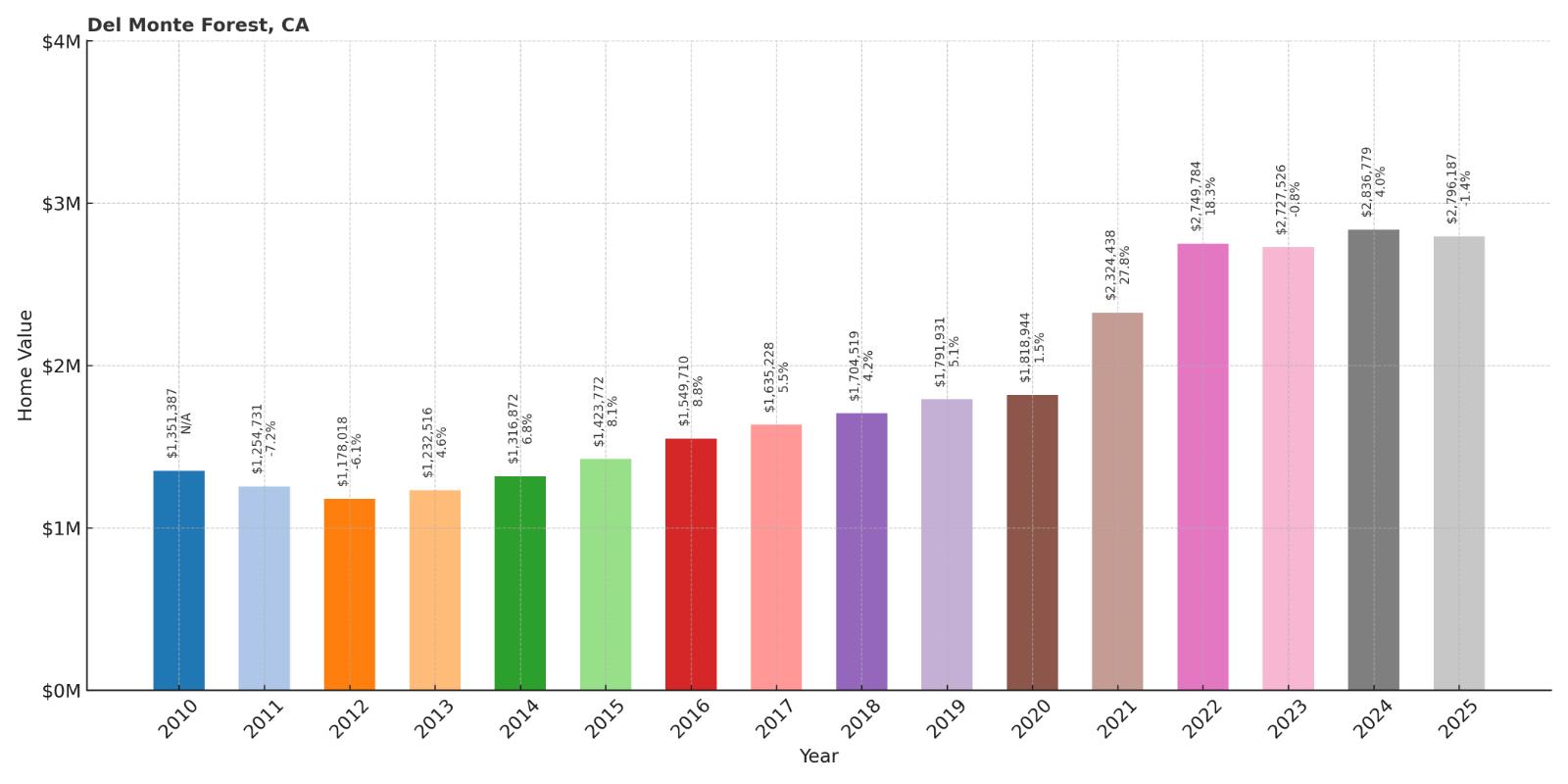
- 2010: $1,351,387
- 2011: $1,254,731
- 2012: $1,178,018
- 2013: $1,232,516
- 2014: $1,316,872
- 2015: $1,423,772
- 2016: $1,549,710
- 2017: $1,635,228
- 2018: $1,704,519
- 2019: $1,791,931
- 2020: $1,818,944
- 2021: $2,324,438
- 2022: $2,749,784
- 2023: $2,727,526
- 2024: $2,836,779
- 2025: $2,796,187
Del Monte Forest has shown steady appreciation over 15 years, more than doubling from its 2010 baseline. The community experienced its strongest growth during 2021-2022, with prices surging over 50% in two years. Current median values around $2.80 million reflect the premium commanded by this exclusive Monterey Peninsula enclave.
Why Del Monte Forest?
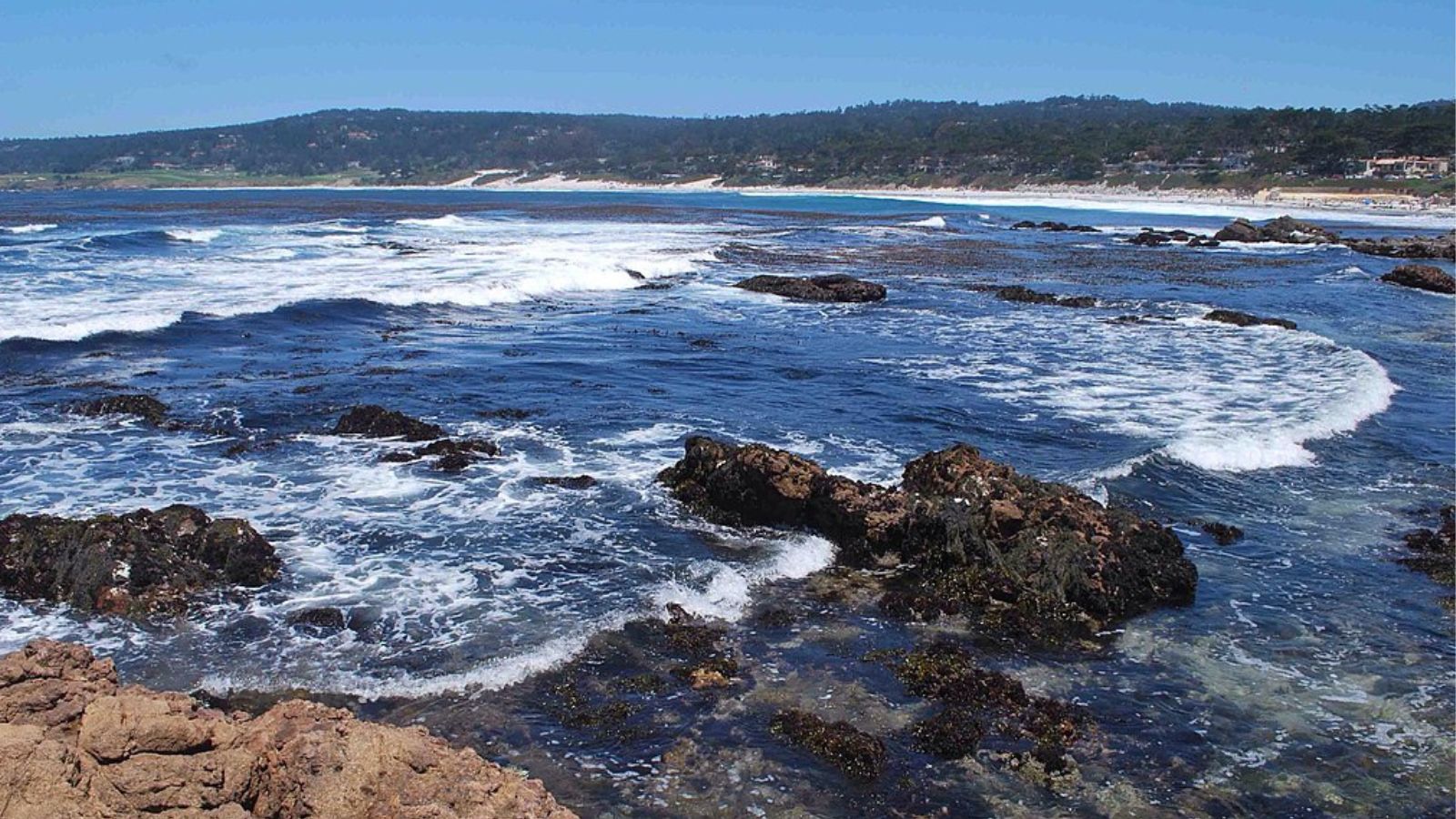
Why are people willing to pay so much to live here? What’s special about it?
Del Monte Forest offers exclusive access to world-renowned Pebble Beach Golf Links and other championship courses, combined with stunning coastal scenery and luxury amenities. Residents enjoy privacy within a gated community that features the famous 17-Mile Drive, upscale lodging, and fine dining. The natural beauty of Monterey Peninsula, including dramatic coastline and Monterey cypress forests, creates an unmatched residential environment.
The community attracts affluent retirees, golf enthusiasts, and second-home buyers seeking a luxury retreat with resort-style amenities. Limited development opportunities and strict architectural controls maintain exclusivity while preserving the area’s natural character.
How Del Monte Forest Rose to Prominence
Del Monte Forest was developed in the early 1900s by the Del Monte Properties Company as an exclusive resort community on the Monterey Peninsula. The creation of Pebble Beach Golf Links in 1919 established the area as a premier destination for wealthy visitors seeking luxury accommodations and world-class golf. Early development focused on grand hotels and vacation homes for California’s elite.
The community’s reputation grew throughout the 20th century as Pebble Beach hosted major golf tournaments and attracted celebrity residents. The combination of natural beauty, exclusive amenities, and limited development opportunities created sustained demand among affluent buyers seeking both primary residences and luxury retreats.
3 Interesting Tidbits
1. Pebble Beach Golf – Home to Pebble Beach Golf Links, regularly ranked among the world’s greatest golf courses and host to multiple U.S. Open tournaments.
2. Seal Point Club – The exclusive private club offers members access to one of California’s most scenic golf courses and social facilities overlooking Carmel Bay.
3. Lone Cypress – The iconic tree along 17-Mile Drive has become one of California’s most photographed landmarks and a symbol of Monterey Peninsula’s natural beauty.
26. Summerland – 113% Home Price Increase Since 2010

- 2010: $1,331,630
- 2011: $1,119,300
- 2012: $1,069,567
- 2013: $1,222,927
- 2014: $1,375,815
- 2015: $1,510,389
- 2016: $1,658,792
- 2017: $1,690,856
- 2018: $1,701,511
- 2019: $1,704,451
- 2020: $1,644,636
- 2021: $2,247,947
- 2022: $2,880,465
- 2023: $2,760,908
- 2024: $2,850,491
- 2025: $2,833,148
Summerland has more than doubled in value since 2010, with particularly dramatic growth during 2021-2022 when prices jumped over 60% in two years. Current median values around $2.83 million reflect the premium placed on beachfront living during and after the pandemic. The small coastal community continues to attract affluent buyers despite recent market moderation.
Why Summerland?

Why are people willing to pay so much to live here? What’s special about it?
Summerland provides direct beach access with a charming small-town atmosphere just minutes from Santa Barbara’s urban amenities. The community features beachfront properties, historic cottages, and newer luxury homes that maximize ocean views and coastal lifestyle benefits. Residents value the walkable downtown area with local shops and restaurants, combined with easy access to outdoor recreation.
The limited housing inventory in this small coastal enclave creates scarcity that drives premium pricing. Environmental restrictions and coastal development regulations ensure that new construction remains limited, preserving the community’s character while supporting property values.
How Summerland Rose to Prominence
Summerland was founded in the 1880s as a seaside resort community along Santa Barbara County’s coast, initially developed around a hotel and mineral springs that attracted visitors seeking health benefits from the ocean air. The community grew slowly as a summer retreat destination for wealthy families from Los Angeles and inland California cities. Early development featured Victorian cottages and beachfront hotels that established the area’s resort character.
The community’s transformation into a year-round residential enclave accelerated after World War II as California’s population growth increased demand for coastal property. Limited developable land and environmental restrictions helped maintain the area’s small-town character while property values appreciated consistently over subsequent decades.
3 Interesting Tidbits
1. Oil Platform Views – The historic offshore oil platforms visible from Summerland Beach are remnants of early 20th-century petroleum development that helped fund early community growth.
2. Lookout Park – The clifftop park offers panoramic ocean views and serves as a community gathering place with regular concerts and events throughout the year.
3. Beach Access – Direct public beach access through the community provides residents and visitors with uncrowded shoreline for swimming, surfing, and beach activities.
25. Laguna Beach – 128% Home Price Increase Since 2010
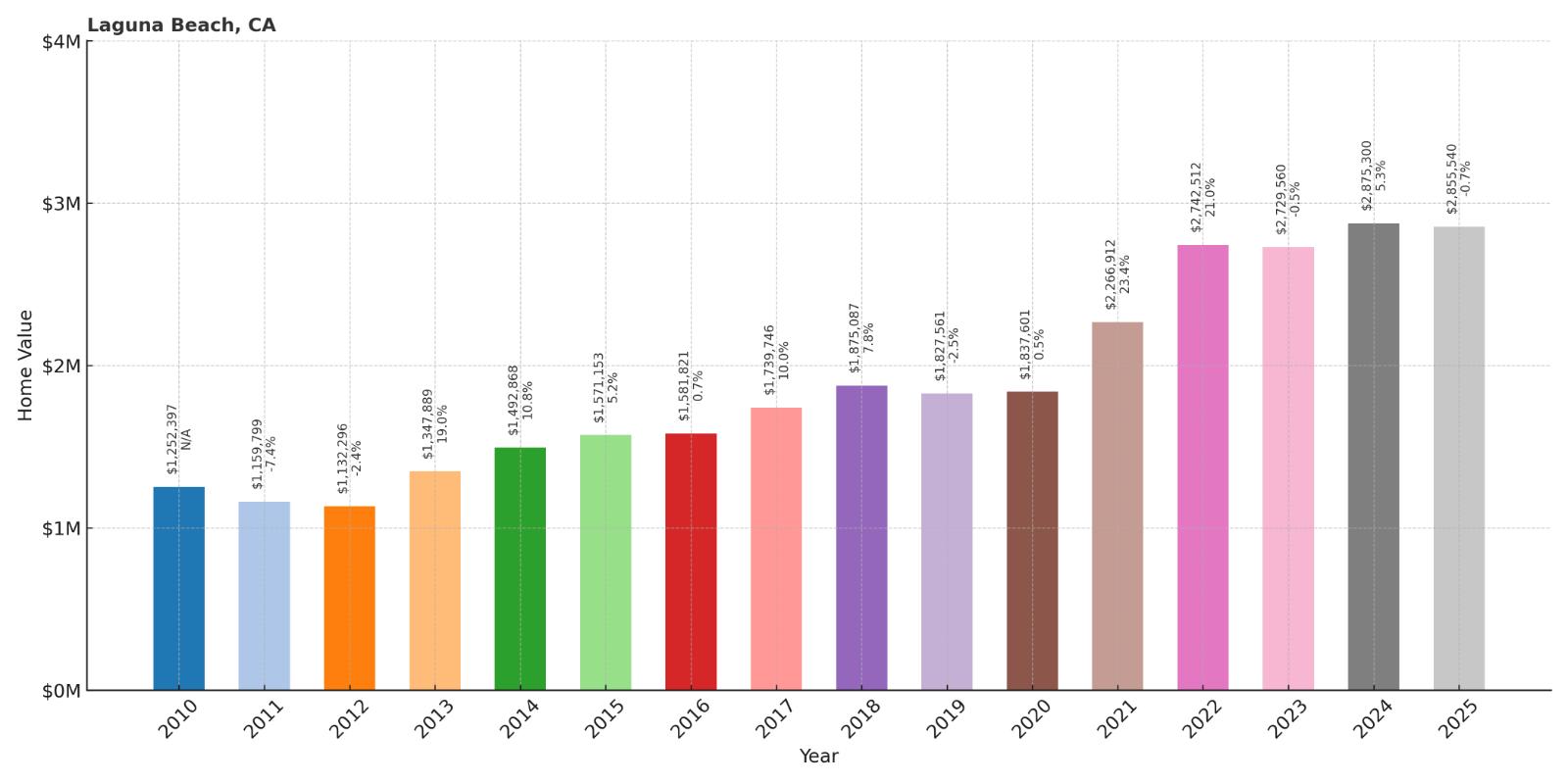
- 2010: $1,252,397
- 2011: $1,159,799
- 2012: $1,132,296
- 2013: $1,347,889
- 2014: $1,492,868
- 2015: $1,571,153
- 2016: $1,581,821
- 2017: $1,739,746
- 2018: $1,875,087
- 2019: $1,827,561
- 2020: $1,837,601
- 2021: $2,266,912
- 2022: $2,742,512
- 2023: $2,729,560
- 2024: $2,875,300
- 2025: $2,855,540
Laguna Beach has seen home values more than double since 2010, with explosive growth during 2021-2022 when prices surged nearly 45% over two years. Current median values around $2.86 million reflect the premium placed on artistic coastal communities during and after the pandemic. The market has shown some recent volatility but remains well above historical levels.
Why Laguna Beach?
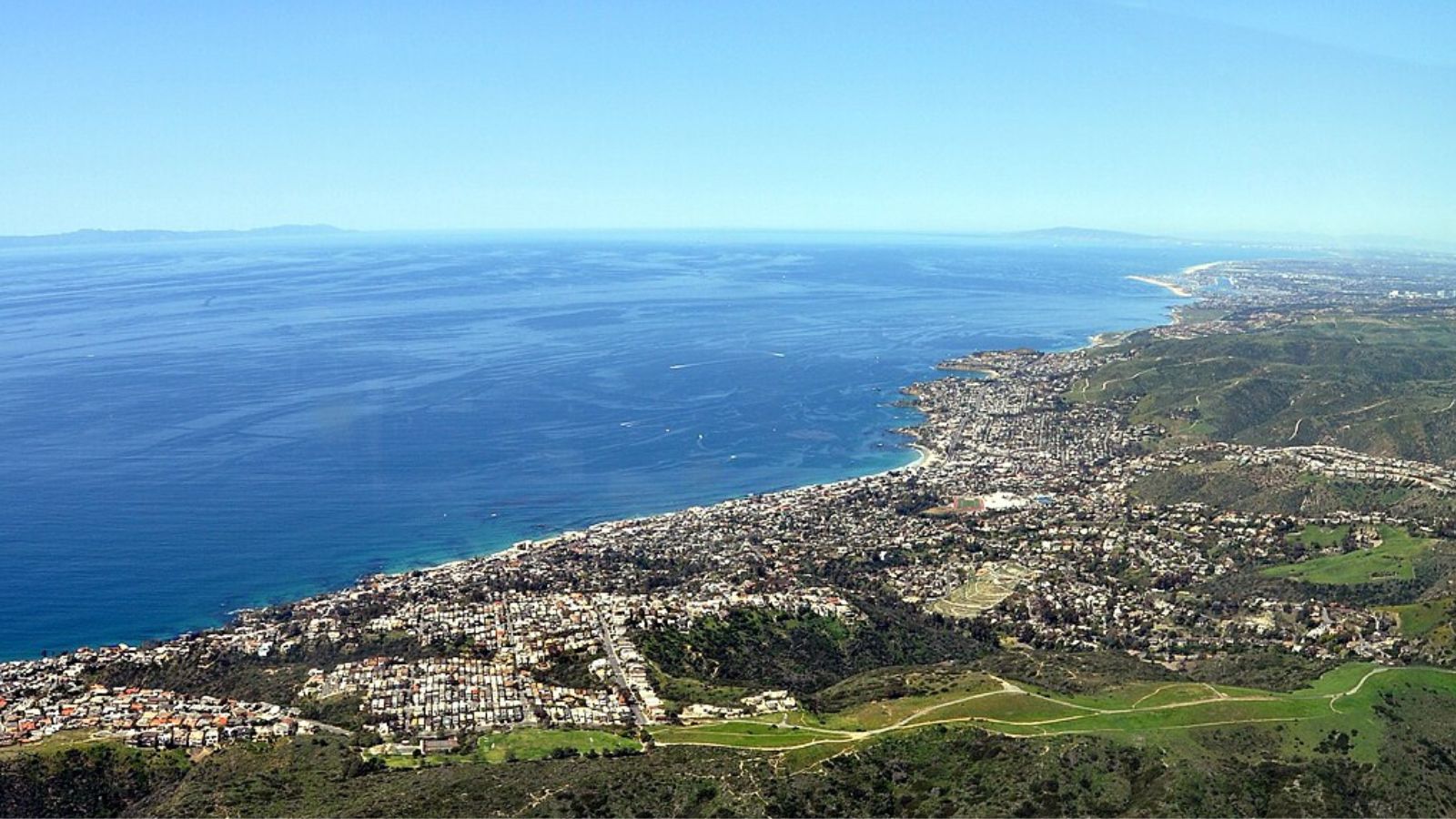
Why are people willing to pay so much to live here? What’s special about it?
Laguna Beach combines spectacular natural beauty with a thriving arts scene, creating a unique coastal community that attracts creative professionals and affluent retirees. The dramatic coastline features numerous beaches, hiking trails, and art galleries that provide both recreation and cultural enrichment. Residents value the walkable downtown area, local restaurants, and regular art festivals that maintain the community’s bohemian character.
The limited developable land along Orange County’s coast creates natural scarcity, while environmental protections ensure that new construction remains carefully controlled. This combination of natural constraints and regulatory oversight helps preserve property values while maintaining the area’s artistic and environmental character.
How Laguna Beach Rose to Prominence
Laguna Beach developed as an artists’ colony in the early 1900s, attracting painters and craftspeople drawn to the dramatic coastal scenery and favorable Mediterranean climate. The community’s reputation as a cultural destination grew throughout the 20th century with the establishment of art galleries, festivals, and schools that created a unique identity distinct from other Orange County beach towns.
The post-war suburban boom brought increased development pressure, but community activism and environmental protection helped preserve Laguna Beach’s character while property values appreciated. The combination of natural beauty, cultural amenities, and limited development opportunities created sustained demand among affluent buyers seeking both primary residences and vacation homes.
3 Interesting Tidbits
1. Pageant of the Masters – The annual summer festival features living reproductions of famous artworks, drawing hundreds of thousands of visitors and reinforcing the community’s artistic identity.
2. Crystal Cove State Park – Adjacent protected parkland provides hiking trails, beaches, and natural habitat that can never be developed, ensuring permanent open space for residents.
3. Trolley System – Free public trolleys help reduce traffic congestion during peak tourist seasons while providing convenient transportation for residents and visitors alike.
24. Cupertino – 226% Home Price Increase Since 2010
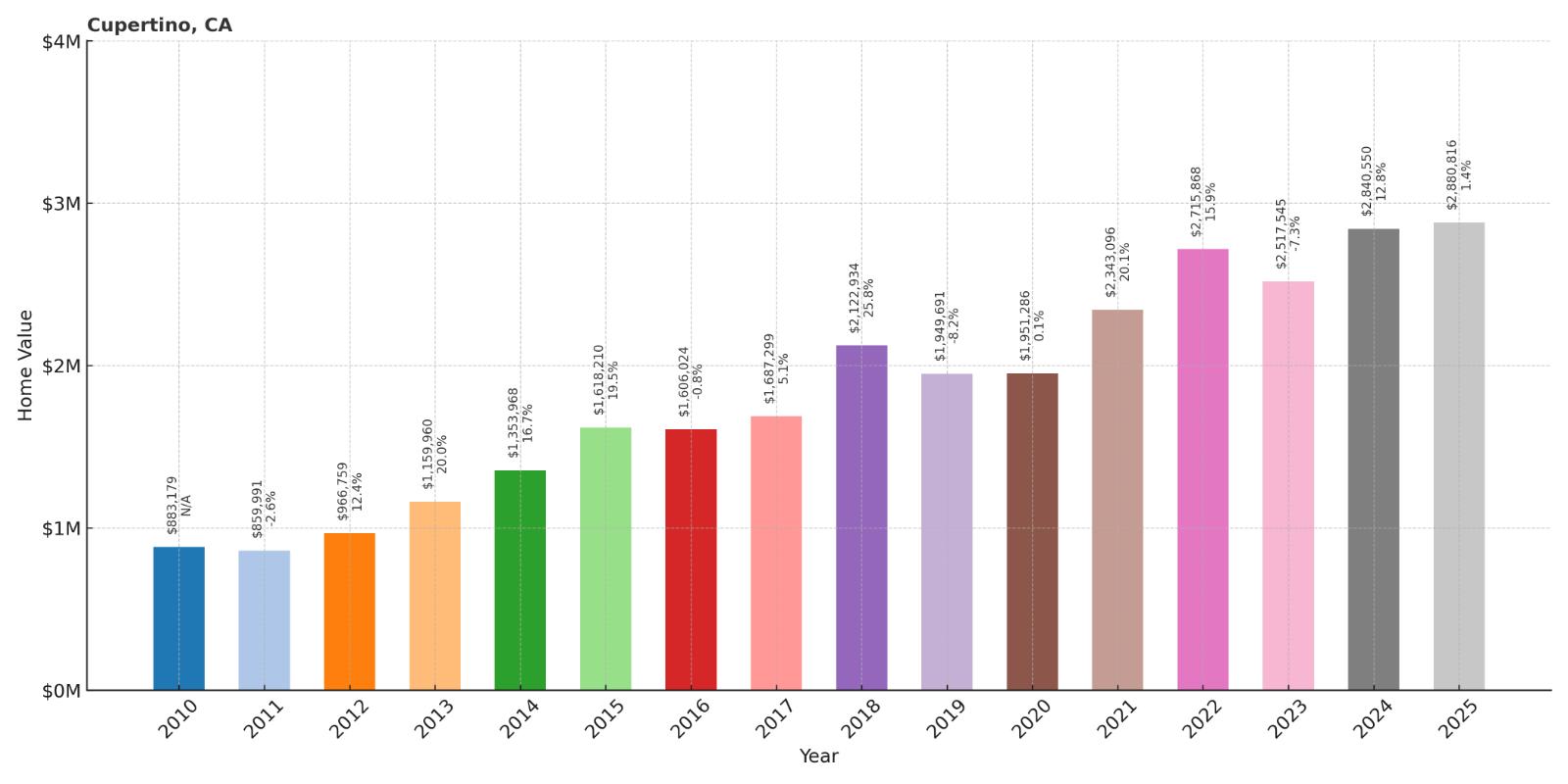
- 2010: $883,179
- 2011: $859,991
- 2012: $966,759
- 2013: $1,159,960
- 2014: $1,353,968
- 2015: $1,618,210
- 2016: $1,606,024
- 2017: $1,687,299
- 2018: $2,122,934
- 2019: $1,949,691
- 2020: $1,951,286
- 2021: $2,343,096
- 2022: $2,715,868
- 2023: $2,517,545
- 2024: $2,840,550
- 2025: $2,880,816
Cupertino has shown the most dramatic appreciation among these communities, with home values more than tripling since 2010. The tech industry epicenter experienced particularly strong growth during 2013-2015 and again in 2021-2022, reaching current median values around $2.88 million. The sustained demand reflects the community’s position at the heart of Silicon Valley innovation.
Why Cupertino?
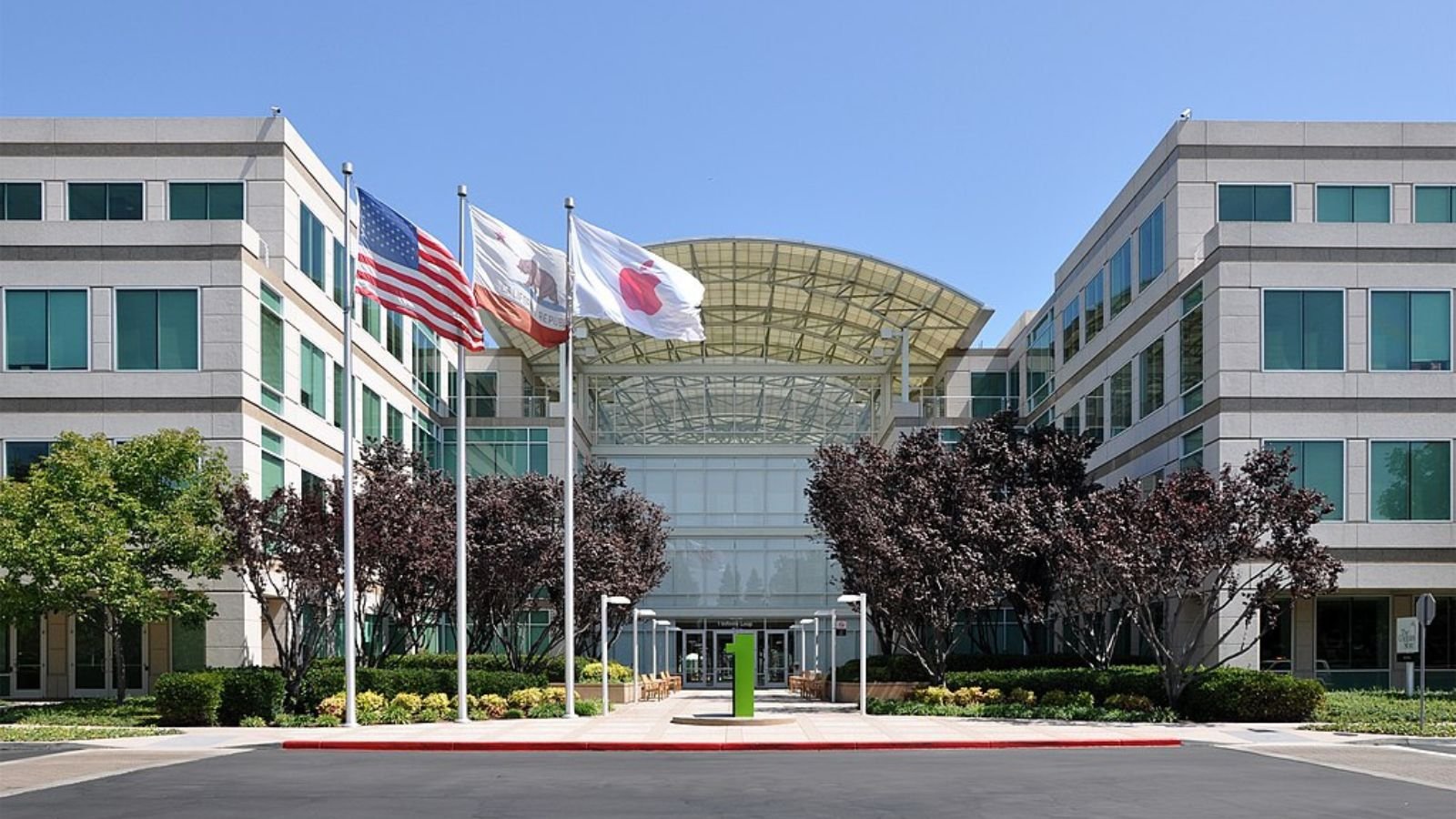
Why are people willing to pay so much to live here? What’s special about it?
Cupertino offers proximity to Apple headquarters and other major tech employers, combined with excellent public schools that consistently rank among California’s finest. Families value the strong educational system, diverse community, and suburban amenities within walking distance of world-class innovation centers. The area features well-planned neighborhoods, parks, and cultural facilities that create an ideal environment for professional families.
Limited housing inventory relative to employment demand creates sustained upward pressure on prices. The combination of high-paying tech jobs, excellent schools, and strategic location ensures continued competition among buyers willing to pay premium prices for this unique combination of benefits.
How Cupertino Rose to Prominence
Cupertino transformed from agricultural community to tech hub following the post-war suburbanization of Santa Clara Valley. The area’s orchards and farmland gave way to planned subdivisions in the 1950s and 1960s as semiconductor companies established operations throughout the region. Early development focused on family-friendly neighborhoods with good schools to attract the engineers and managers of emerging technology companies.
Apple’s founding and growth in Cupertino during the 1980s and 1990s cemented the community’s reputation as a Silicon Valley epicenter. The company’s expansion and the broader tech industry’s success created extraordinary wealth among local professionals, driving sustained demand for housing and pushing property values to unprecedented levels.
3 Interesting Tidbits
1. Apple Park – The 175-acre Apple headquarters features innovative architecture and landscaping that has become a symbol of Silicon Valley’s design excellence.
2. Excellent Schools – Cupertino Union School District consistently ranks among California’s top elementary districts, making the area highly attractive to families.
3. Cultural Diversity – The community features significant Asian American population, creating excellent dining, cultural centers, and educational opportunities that reflect global tech industry demographics.
23. Stinson Beach – 201% Home Price Increase Since 2010
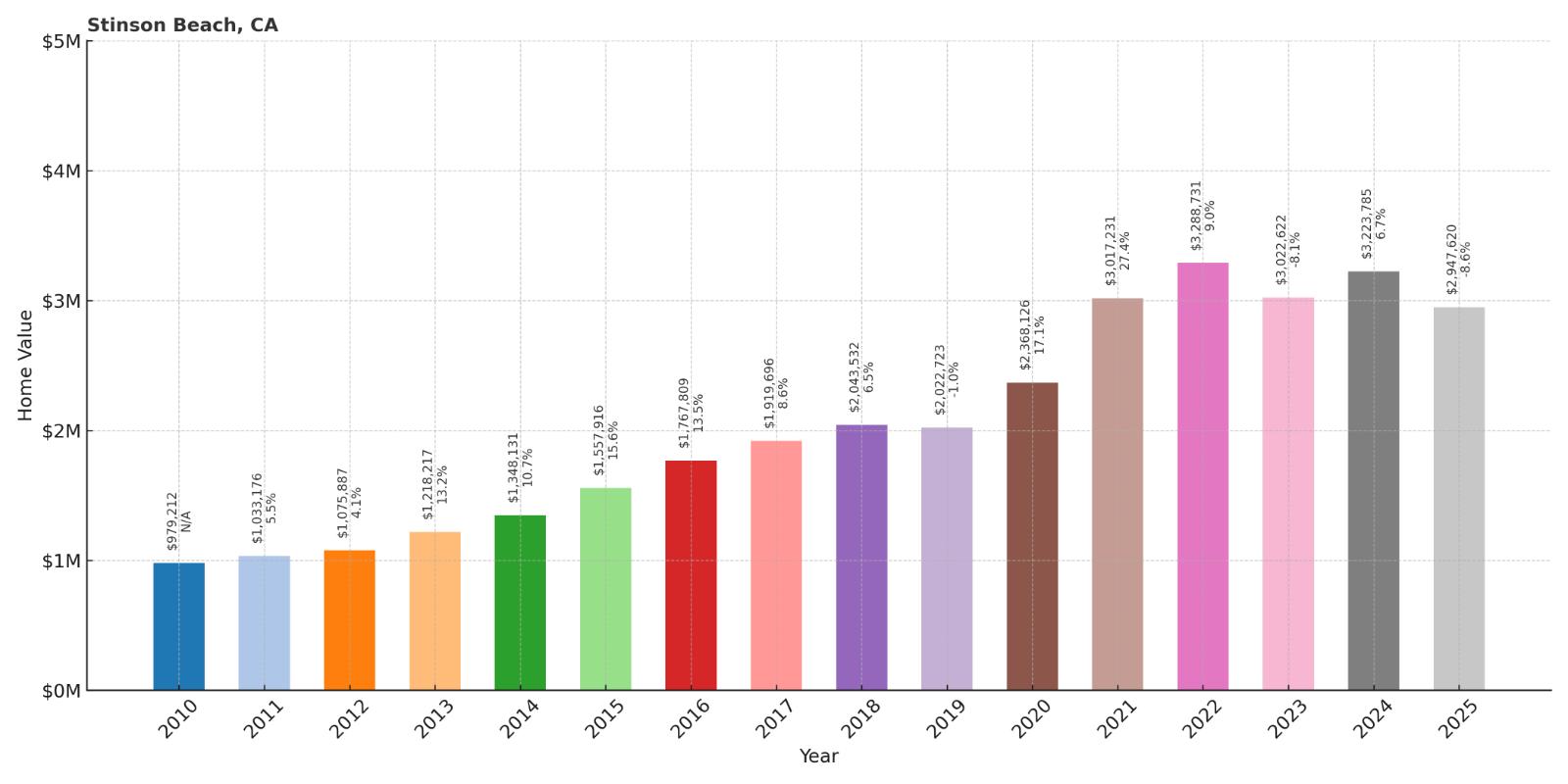
- 2010: $979,212
- 2011: $1,033,176
- 2012: $1,075,887
- 2013: $1,218,217
- 2014: $1,348,131
- 2015: $1,557,916
- 2016: $1,767,809
- 2017: $1,919,696
- 2018: $2,043,532
- 2019: $2,022,723
- 2020: $2,368,126
- 2021: $3,017,231
- 2022: $3,288,731
- 2023: $3,022,622
- 2024: $3,223,785
- 2025: $2,947,620
Stinson Beach has experienced the most dramatic price appreciation among these communities, with home values nearly tripling since 2010. The coastal community saw particularly explosive growth during 2020-2022, when prices surged over 60% in three years, reflecting the premium buyers placed on beachfront living during the pandemic. Current median values around $2.95 million remain well above historical levels despite recent corrections.
Why Stinson Beach?
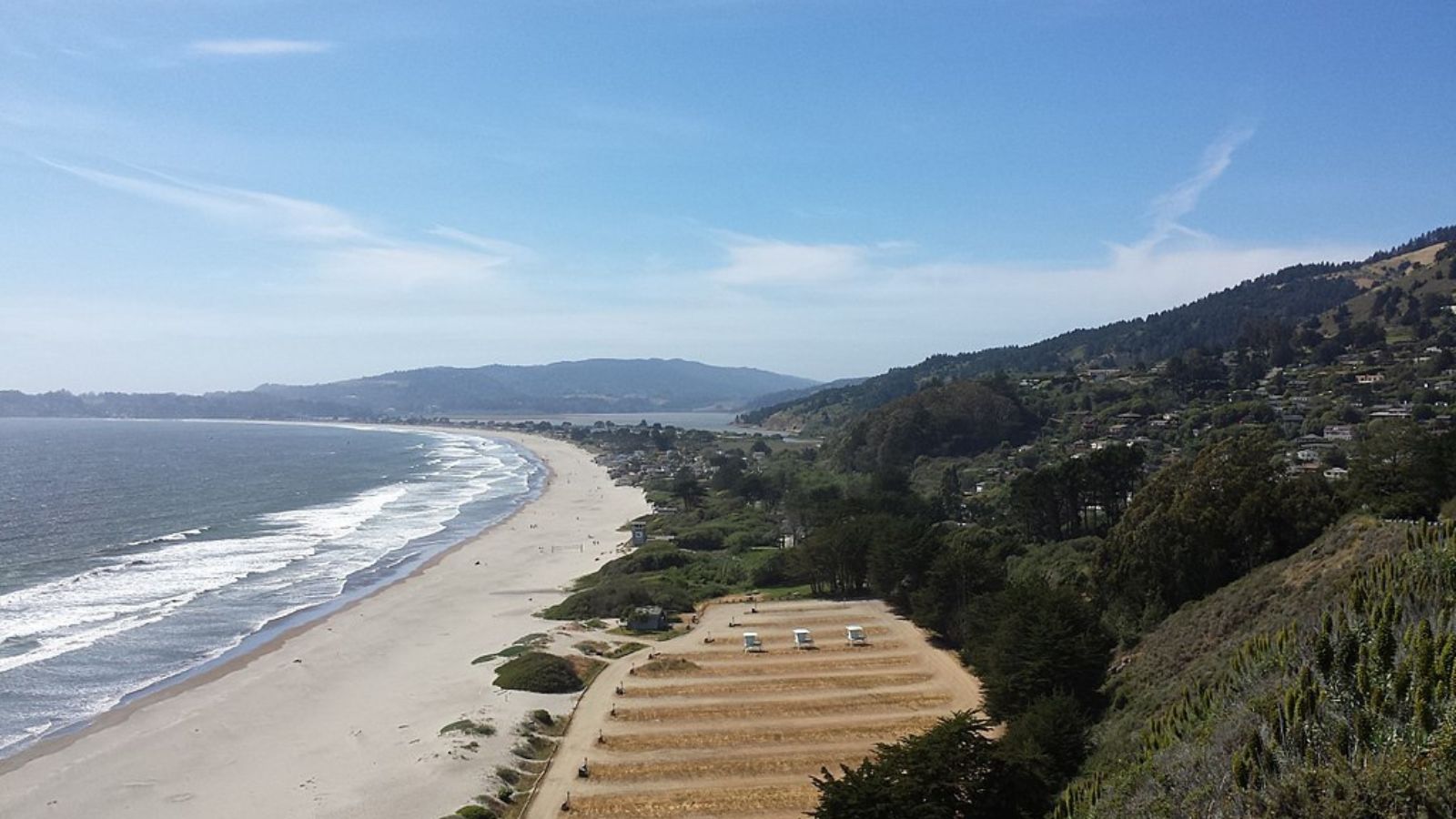
Why are people willing to pay so much to live here? What’s special about it?
Stinson Beach provides direct access to one of Northern California’s most beautiful sandy beaches, combined with small-town charm and proximity to San Francisco. Residents enjoy a relaxed coastal lifestyle with excellent surfing, hiking in adjacent Muir Woods, and a close-knit community atmosphere. The dramatic natural setting between Mount Tamalpais and the Pacific Ocean creates unmatched scenic beauty.
Limited developable land and environmental protections ensure housing scarcity, while the community’s remote feel despite urban accessibility creates exceptional appeal. The combination of natural amenities, recreational opportunities, and limited inventory drives sustained premium pricing.
How Stinson Beach Rose to Prominence
Stinson Beach developed as a summer resort destination in the early 1900s, attracting visitors from San Francisco seeking beach recreation and mountain hiking. The community grew slowly around a small commercial center serving beachgoers and seasonal residents. Early development featured modest cottages and beach homes that reflected the area’s casual, recreational character.
The community’s transformation into a year-round luxury enclave accelerated during the 1970s and 1980s as Bay Area professionals discovered its combination of natural beauty and relative accessibility. Environmental protection efforts helped preserve the area’s character while limited development opportunities created scarcity that drove property values steadily higher over subsequent decades.
3 Interesting Tidbits
1. Muir Woods Access – The community provides easy access to Muir Woods National Monument, featuring some of the world’s tallest coastal redwood trees just minutes from beachfront properties.
2. Surfing Paradise – Consistent waves and relatively uncrowded conditions make Stinson Beach a premier Northern California surfing destination for both locals and visitors.
3. Fire Recovery – The community has repeatedly rebuilt after wildfire disasters, demonstrating resilience while property values continued appreciating despite natural hazard risks.
22. Diablo – 40% Home Price Increase Since 2016
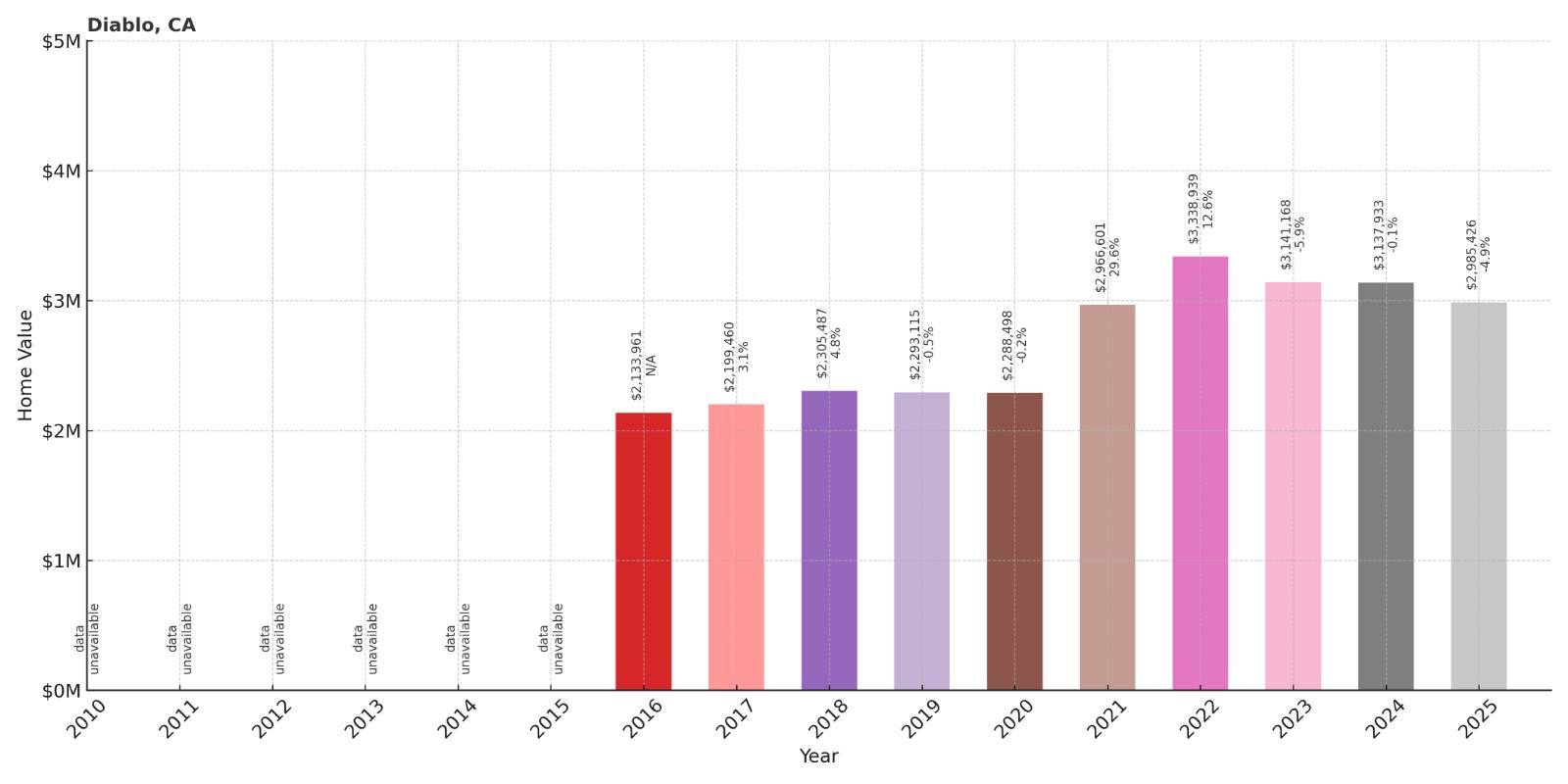
- 2010: N/A
- 2011: N/A
- 2012: N/A
- 2013: N/A
- 2014: N/A
- 2015: N/A
- 2016: $2,133,961
- 2017: $2,199,460
- 2018: $2,305,487
- 2019: $2,293,115
- 2020: $2,288,498
- 2021: $2,966,601
- 2022: $3,338,939
- 2023: $3,141,168
- 2024: $3,137,933
- 2025: $2,985,426
Diablo shows more limited data availability, with values tracked from 2016 showing steady appreciation through 2022. The exclusive gated community experienced significant growth during 2021-2022, with prices jumping over 40% during the pandemic housing boom. Current median values around $2.99 million reflect the premium commanded by this Contra Costa County enclave despite recent market softening.
Why Diablo?
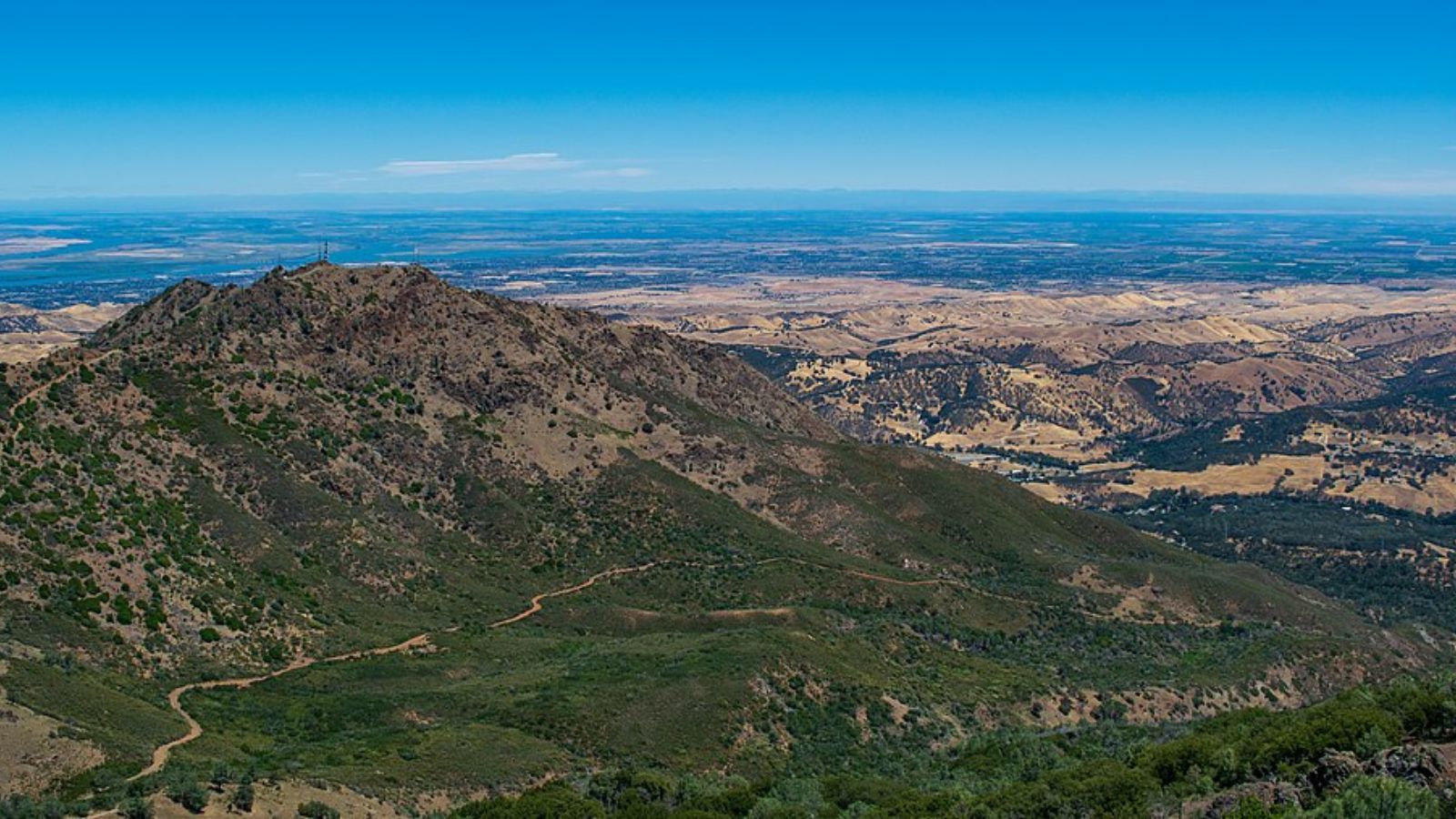
Why are people willing to pay so much to live here? What’s special about it?
Diablo offers exclusive gated living with expansive custom estates on large lots, providing privacy and luxury within easy commuting distance of San Francisco and Silicon Valley. The community features championship golf courses, equestrian facilities, and hiking trails that create a resort-like environment for residents. Families appreciate the security, excellent schools, and country club atmosphere that distinguishes this enclave from typical suburban developments.
The limited number of homesites and strict architectural controls maintain exclusivity while protecting property values. The combination of natural beauty, recreational amenities, and strategic location ensures sustained demand among affluent buyers seeking luxury suburban living.
How Diablo Rose to Prominence
Diablo was developed in the 1910s as an exclusive residential community centered around the Diablo Country Club, one of California’s premier private golf clubs. The area’s rolling hills and oak-studded landscapes attracted wealthy San Francisco families seeking country estates within reasonable distance of the city. Early development focused on large lots and custom homes that established the community’s luxury character.
The post-war suburban boom brought careful expansion while maintaining the area’s exclusive character through deed restrictions and community planning. The development of nearby business centers and improved transportation access increased the community’s appeal among executives and professionals seeking luxury living with urban accessibility.
3 Interesting Tidbits
1. Diablo Country Club – The private club features championship golf courses designed by renowned architects and serves as the social center for many of the area’s most affluent residents.
2. Mount Diablo Views – Many properties offer panoramic views of Mount Diablo State Park, providing residents with protected open space and recreational opportunities.
3. Gated Security – Multiple gated entrances and private security patrols create a secure environment that appeals to high-profile residents seeking privacy and protection.
21. Manhattan Beach – 146% Home Price Increase Since 2010
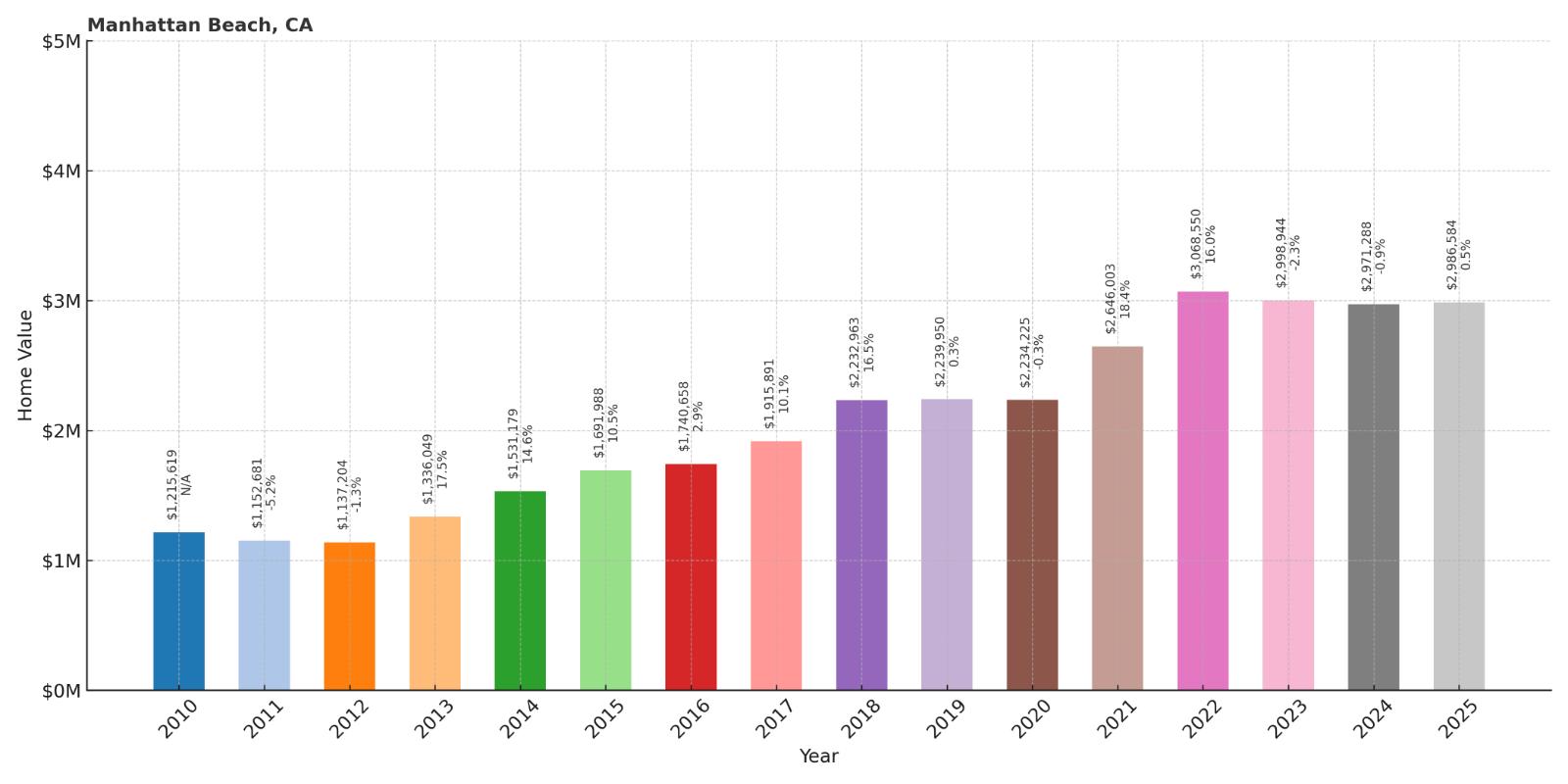
- 2010: $1,215,619
- 2011: $1,152,681
- 2012: $1,137,204
- 2013: $1,336,049
- 2014: $1,531,179
- 2015: $1,691,988
- 2016: $1,740,658
- 2017: $1,915,891
- 2018: $2,232,963
- 2019: $2,239,950
- 2020: $2,234,225
- 2021: $2,646,003
- 2022: $3,068,550
- 2023: $2,998,944
- 2024: $2,971,288
- 2025: $2,986,584
Manhattan Beach has shown consistent appreciation since 2010, with home values more than doubling over the 15-year period. The beachfront community experienced particularly strong growth during 2017-2018 and again in 2021-2022, reaching current median values around $2.99 million. The market has remained relatively stable despite broader luxury market fluctuations, reflecting sustained demand for premium beachfront living.
Why Manhattan Beach?
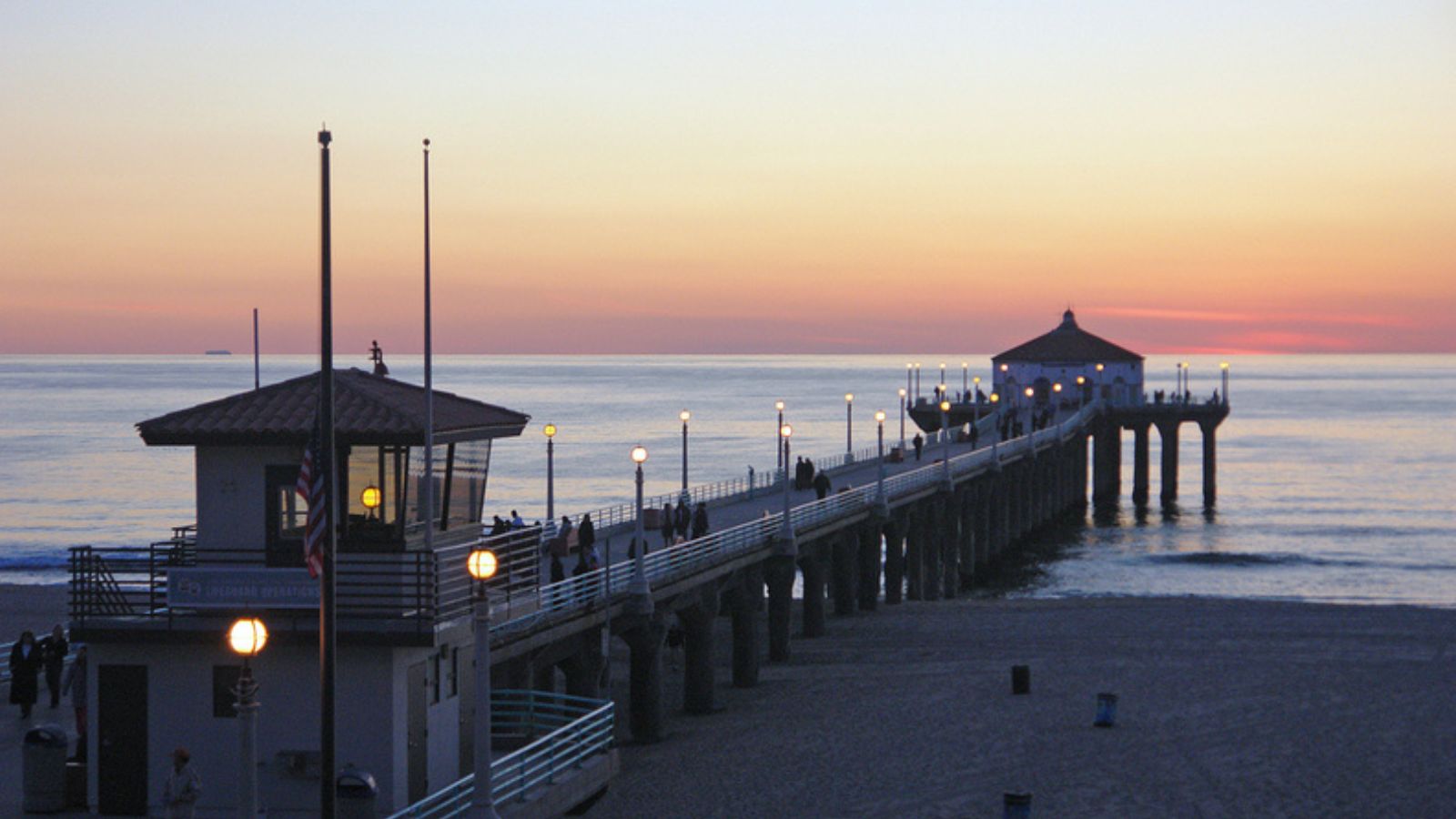
Why are people willing to pay so much to live here? What’s special about it?
Manhattan Beach provides world-class beachfront living with excellent schools, family-friendly neighborhoods, and easy access to Los Angeles employment centers. The community features championship volleyball courts, upscale shopping and dining, and a strong sense of community that attracts affluent families. Residents enjoy year-round outdoor recreation, from beach activities to the famous Manhattan Beach Pier.
Limited beachfront inventory and strict development controls ensure scarcity that supports premium pricing. The combination of coastal lifestyle, educational excellence, and urban accessibility creates exceptional appeal among high-net-worth individuals seeking the ultimate Southern California beach town experience.
How Manhattan Beach Rose to Prominence
Manhattan Beach developed in the early 1900s as a seaside resort community, with the construction of a pleasure pier and hotel that attracted visitors from throughout Southern California. The community’s growth accelerated during the 1920s as automobile access improved and year-round residence became more practical. Early development focused on beach cottages and small hotels that served the growing tourism industry.
The post-World War II suburban boom transformed Manhattan Beach into a premium residential community as aerospace industry professionals and entertainment industry executives discovered its combination of beach living and urban access. Careful planning and community involvement helped preserve the area’s beach town character while property values appreciated consistently over subsequent decades.
3 Interesting Tidbits
1. Beach Volleyball Capital – Manhattan Beach hosts numerous professional volleyball tournaments and is considered the birthplace of beach volleyball as an organized sport.
2. The Strand – The oceanfront bike path stretches for miles along the coast, providing residents with car-free recreation and transportation options.
3. Top Gun Filming – The iconic beach volleyball scenes from the movie Top Gun were filmed at Manhattan Beach, cementing its place in popular culture.
20. Stanford – 175% Home Price Increase Since 2010
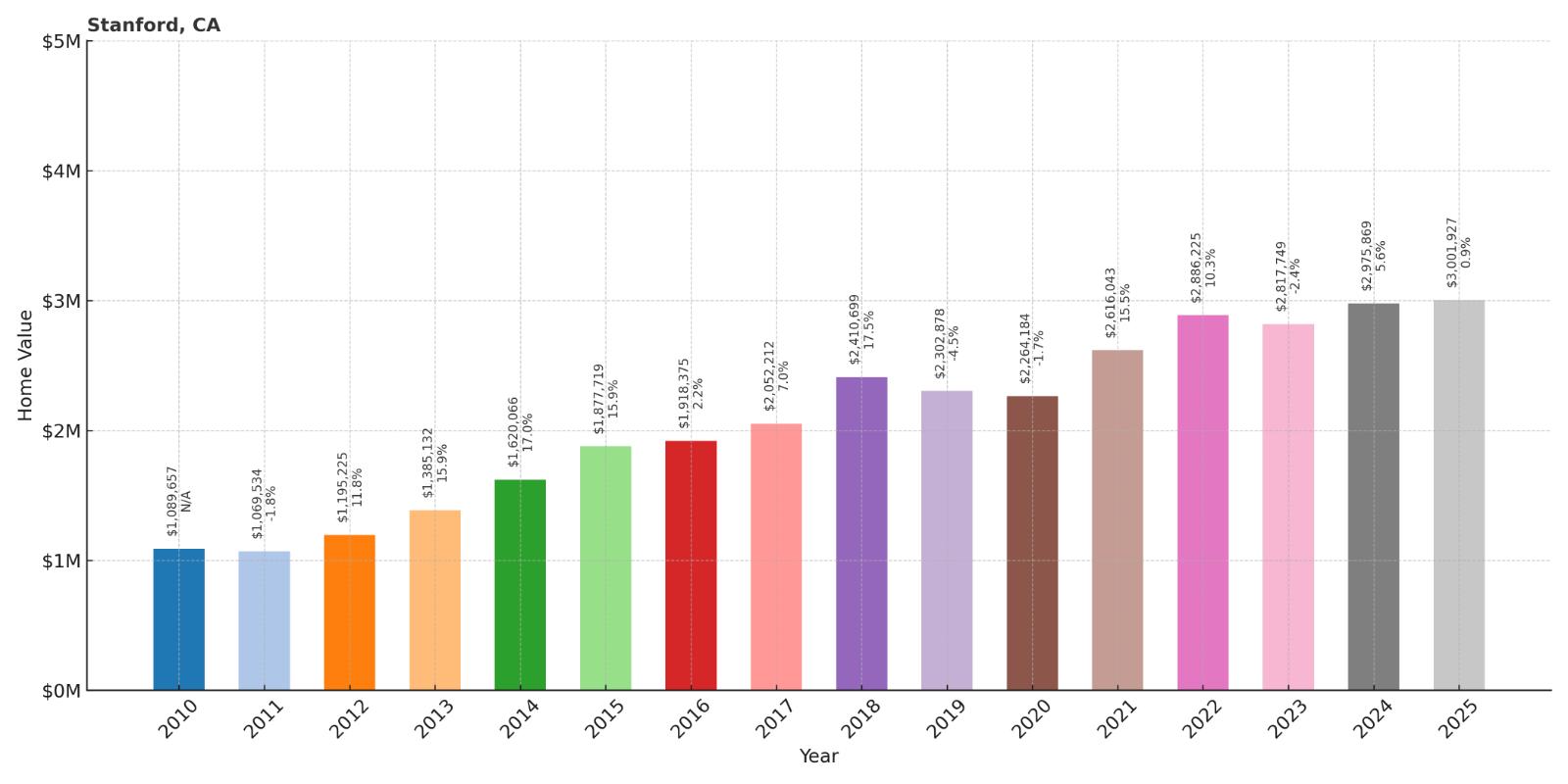
- 2010: $1,089,657
- 2011: $1,069,534
- 2012: $1,195,225
- 2013: $1,385,132
- 2014: $1,620,066
- 2015: $1,877,719
- 2016: $1,918,375
- 2017: $2,052,212
- 2018: $2,410,699
- 2019: $2,302,878
- 2020: $2,264,184
- 2021: $2,616,043
- 2022: $2,886,225
- 2023: $2,817,749
- 2024: $2,975,869
- 2025: $3,001,927
Stanford has seen home values nearly triple since 2010, driven by its location at the heart of Silicon Valley and proximity to Stanford University. The community experienced steady growth with particularly strong gains between 2012-2018, reaching current median values around $3.00 million. The market has shown resilience with continued appreciation despite broader economic uncertainties.
Why Stanford?
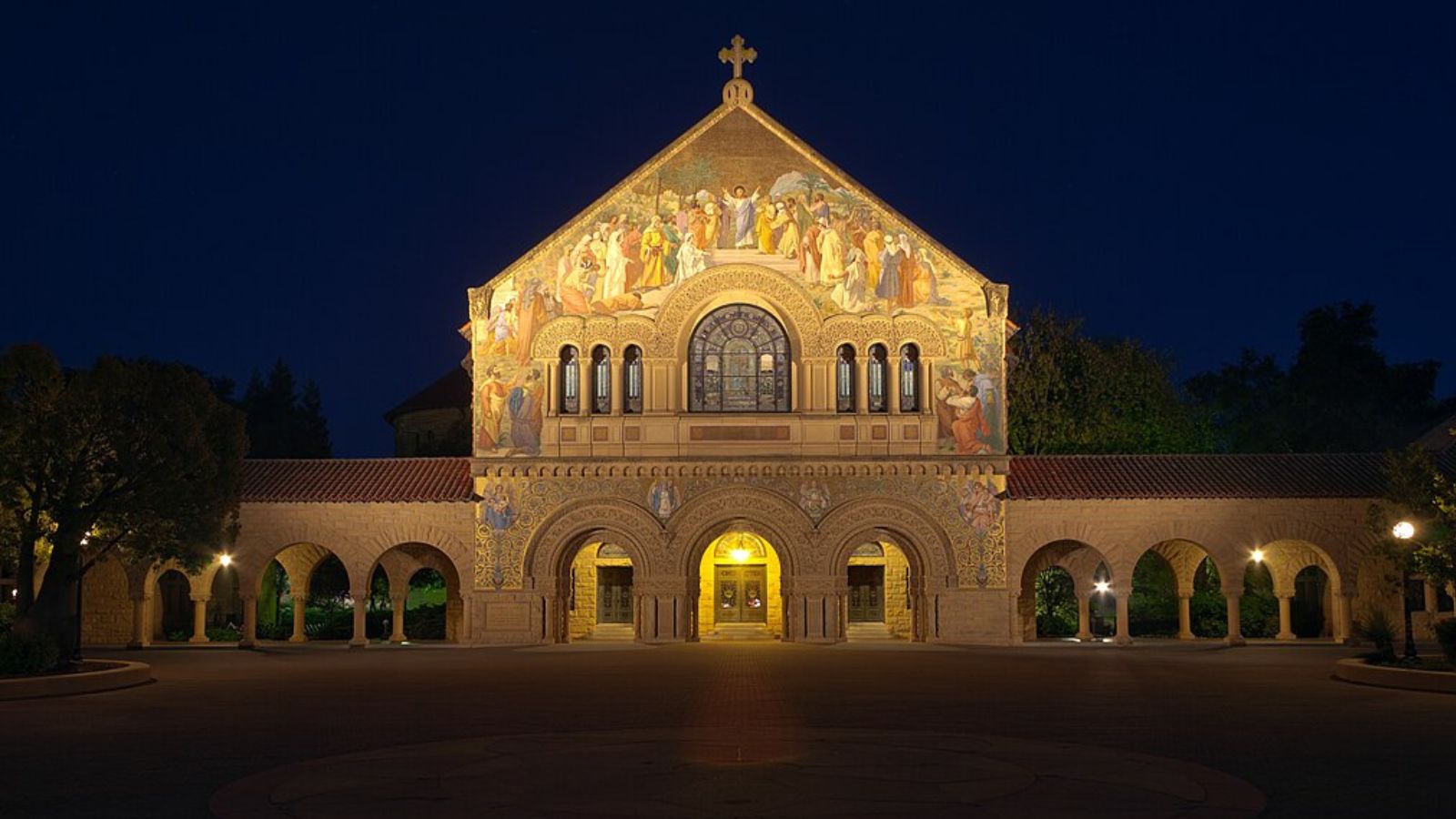
Why are people willing to pay so much to live here? What’s special about it?
Stanford offers unparalleled access to world-class education and research opportunities, combined with proximity to major tech companies and venture capital firms. The community attracts academics, executives, and entrepreneurs who value intellectual stimulation alongside suburban amenities. Beautiful tree-lined streets, historic architecture, and cultural facilities create an environment that balances academic prestige with family-friendly living.
Extremely limited housing inventory, with many properties owned by Stanford University and restricted to faculty, creates exceptional scarcity. This unique market dynamic, combined with sustained demand from the global tech industry, ensures continued premium pricing despite occasional market fluctuations.
How Stanford Rose to Prominence
Stanford developed around the establishment of Stanford University in 1885, founded by railroad magnate Leland Stanford as a memorial to his son. The university’s growth throughout the 20th century created a unique community combining academic excellence with proximity to emerging technology industries. Early development featured faculty housing and support services that established the area’s intellectual character.
The post-war transformation of Stanford Research Park and the broader Silicon Valley tech boom cemented Stanford’s position as an innovation epicenter. The university’s role in founding and nurturing technology companies created extraordinary wealth among faculty, alumni, and industry professionals, driving sustained demand for housing in this exclusive community.
3 Interesting Tidbits
1. University Housing – Much of Stanford’s residential property is owned by the university and available only to faculty and staff, creating a unique restricted market.
2. Silicon Valley Birthplace – Stanford Research Park, established in the 1950s, helped launch numerous technology companies and is considered the birthplace of Silicon Valley innovation.
3. Dish Trail – The popular hiking trail around the Stanford Dish provides residents and visitors with panoramic views of San Francisco Bay and the Peninsula.
19. Rolling Hills – 127% Home Price Increase Since 2010

- 2010: $1,346,597
- 2011: $1,340,679
- 2012: $1,340,723
- 2013: $1,546,173
- 2014: $1,707,510
- 2015: $1,765,227
- 2016: $1,810,762
- 2017: $1,967,767
- 2018: $2,203,280
- 2019: $2,248,281
- 2020: $2,206,962
- 2021: $2,811,696
- 2022: $3,321,974
- 2023: $3,138,563
- 2024: $3,183,763
- 2025: $3,052,105
Rolling Hills has shown steady appreciation since 2010, more than doubling in value over the 15-year period. The exclusive equestrian community experienced its strongest growth during 2021-2022, with prices surging over 35% in two years. Current median values around $3.05 million reflect the premium commanded by this unique gated community on the Palos Verdes Peninsula.
Why Rolling Hills?

Why are people willing to pay so much to live here? What’s special about it?
Rolling Hills offers a rare combination of rural tranquility and urban accessibility, featuring large lots with equestrian facilities just minutes from downtown Los Angeles. The gated community maintains a country atmosphere with riding trails, open space, and custom estates that provide privacy and luxury. Residents enjoy a unique lifestyle that combines suburban amenities with rural recreation opportunities.
Strict development controls and large minimum lot sizes ensure low density and preserve the community’s equestrian character. The combination of exclusivity, natural beauty, and proximity to employment centers creates sustained demand among affluent buyers seeking luxury rural living within an urban region.
How Rolling Hills Rose to Prominence
Rolling Hills was developed in the 1930s as an exclusive equestrian community on the Palos Verdes Peninsula, designed to preserve rural character while providing luxury amenities for wealthy Los Angeles residents. The community’s development emphasized large lots, riding trails, and architectural controls that maintained a consistent rural aesthetic. Early residents included entertainment industry executives and business leaders seeking country estates within commuting distance of the city.
The community’s incorporation in 1957 allowed residents to maintain strict zoning and development standards that preserved the area’s unique character as Los Angeles County urbanized around it. The commitment to equestrian facilities and open space created a distinctive identity that continues to attract affluent buyers seeking rural luxury in an urban region.
3 Interesting Tidbits
1. Horse Trails – The community features over 10 miles of private equestrian trails connecting properties and providing residents with extensive recreational opportunities.
2. Gated Exclusivity – Rolling Hills remains one of Los Angeles County’s few completely gated cities, with controlled access that ensures privacy and security for all residents.
3. Green Belt Preservation – Large portions of the community are dedicated to permanent open space and green belts that preserve the rural character and protect property values.
18. Malibu – 168% Home Price Increase Since 2010
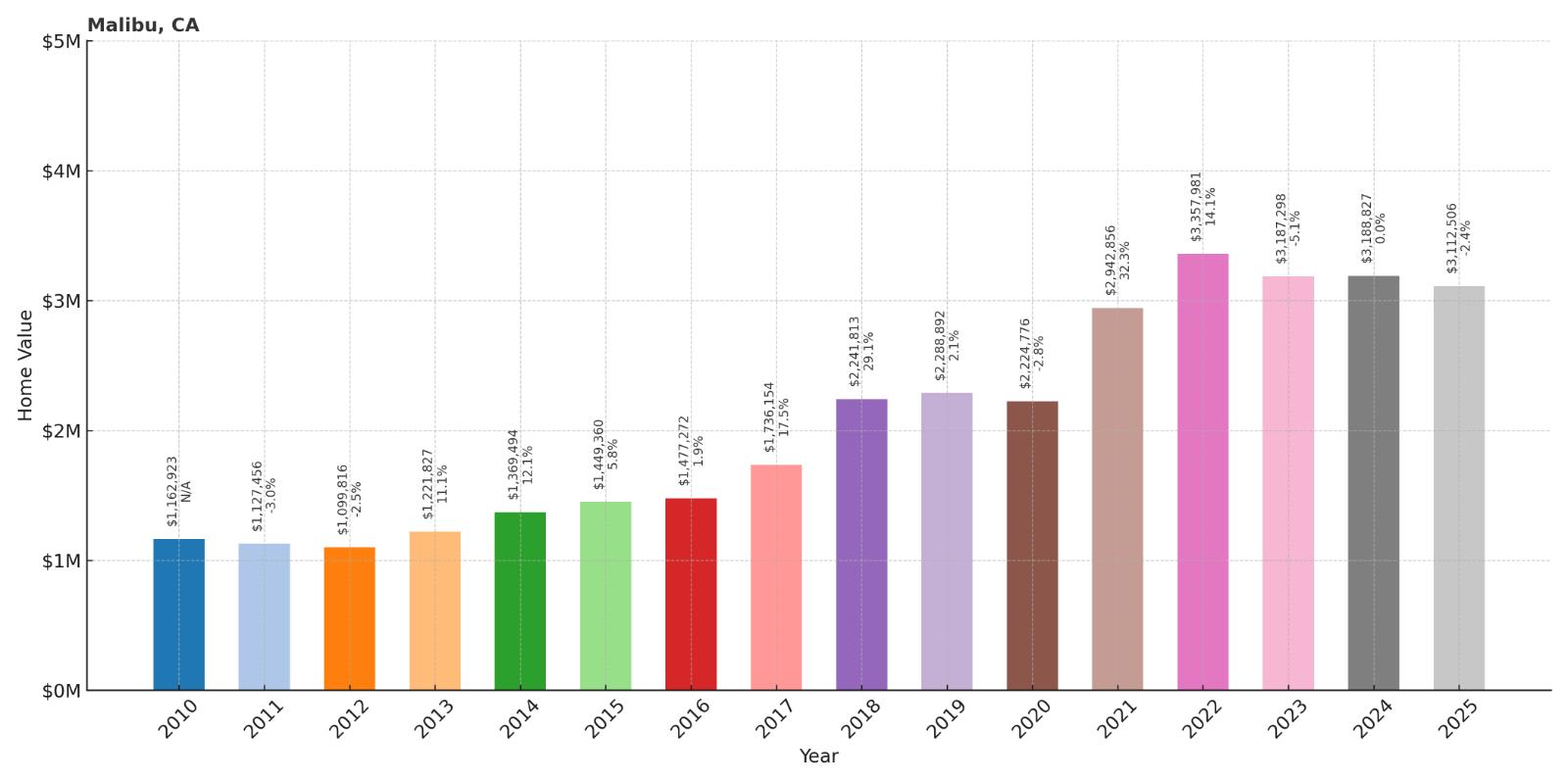
- 2010: $1,162,923
- 2011: $1,127,456
- 2012: $1,099,816
- 2013: $1,221,827
- 2014: $1,369,494
- 2015: $1,449,360
- 2016: $1,477,272
- 2017: $1,736,154
- 2018: $2,241,813
- 2019: $2,288,892
- 2020: $2,224,776
- 2021: $2,942,856
- 2022: $3,357,981
- 2023: $3,187,298
- 2024: $3,188,827
- 2025: $3,112,506
Malibu has shown dramatic appreciation since 2010, with home values nearly tripling over the 15-year period. The iconic coastal community experienced particularly strong growth during 2017-2018 and again in 2021-2022, reflecting the premium placed on beachfront celebrity enclaves. Current median values around $3.11 million demonstrate sustained demand despite wildfire risks and market volatility.
Why Malibu?

Why are people willing to pay so much to live here? What’s special about it?
Malibu provides unmatched coastal living with dramatic Pacific Ocean frontage, celebrity cachet, and proximity to Los Angeles entertainment centers. The community offers world-class beaches, upscale shopping and dining, and recreational opportunities that attract affluent professionals and entertainment industry elites. Residents value the combination of natural beauty, privacy, and sophisticated amenities that define Southern California luxury living.
Limited developable beachfront land and environmental restrictions ensure housing scarcity, while celebrity presence and media attention maintain global recognition. The combination of natural amenities, cultural significance, and investment appeal creates sustained demand despite natural hazard risks.
How Malibu Rose to Prominence
Malibu developed slowly from ranch land into a celebrity retreat beginning in the 1920s and 1930s, as Hollywood stars discovered its combination of coastal beauty and relative privacy. The construction of Pacific Coast Highway improved access while maintaining the area’s secluded character. Early development featured beach cottages and custom homes that established Malibu’s reputation as an exclusive coastal enclave.
The community’s incorporation in 1991 allowed residents to control development and preserve environmental quality while property values appreciated dramatically. The area’s association with entertainment industry wealth and California’s beach culture created global recognition that continues to attract international buyers and maintain premium pricing.
3 Interesting Tidbits
1. Celebrity Haven – Malibu has been home to countless Hollywood stars, from early film legends to contemporary entertainment industry elites, maintaining its reputation as a celebrity enclave.
2. Surf Culture – Malibu’s beaches, particularly Surfrider Beach, are legendary in surf culture and continue to attract wave riders from around the world.
3. Wildfire Resilience – Despite repeated wildfire damage, the community consistently rebuilds with improved fire-resistant construction, demonstrating the enduring appeal of coastal Malibu living.
17. Beverly Hills – 115% Home Price Increase Since 2010
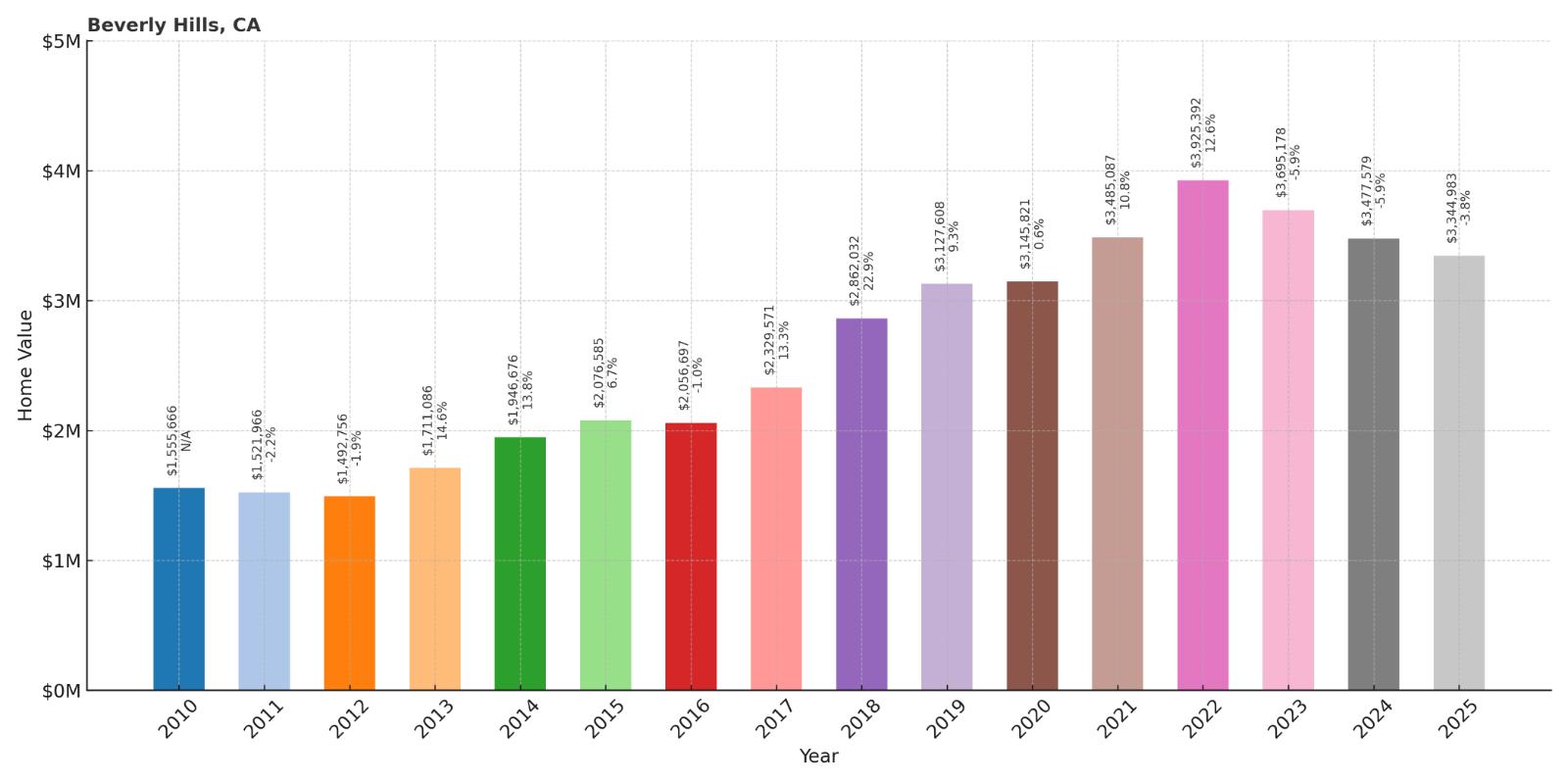
- 2010: $1,555,666
- 2011: $1,521,966
- 2012: $1,492,756
- 2013: $1,711,086
- 2014: $1,946,676
- 2015: $2,076,585
- 2016: $2,056,697
- 2017: $2,329,571
- 2018: $2,862,032
- 2019: $3,127,608
- 2020: $3,145,821
- 2021: $3,485,087
- 2022: $3,925,392
- 2023: $3,695,178
- 2024: $3,477,579
- 2025: $3,344,983
Beverly Hills has more than doubled in value since 2010, with steady appreciation punctuated by particularly strong growth during 2017-2019 and again in 2021-2022. Current median values around $3.34 million reflect some recent cooling but maintain the community’s position as one of America’s most prestigious addresses. The market has shown resilience despite luxury segment volatility, supported by sustained international demand.
Why Beverly Hills?
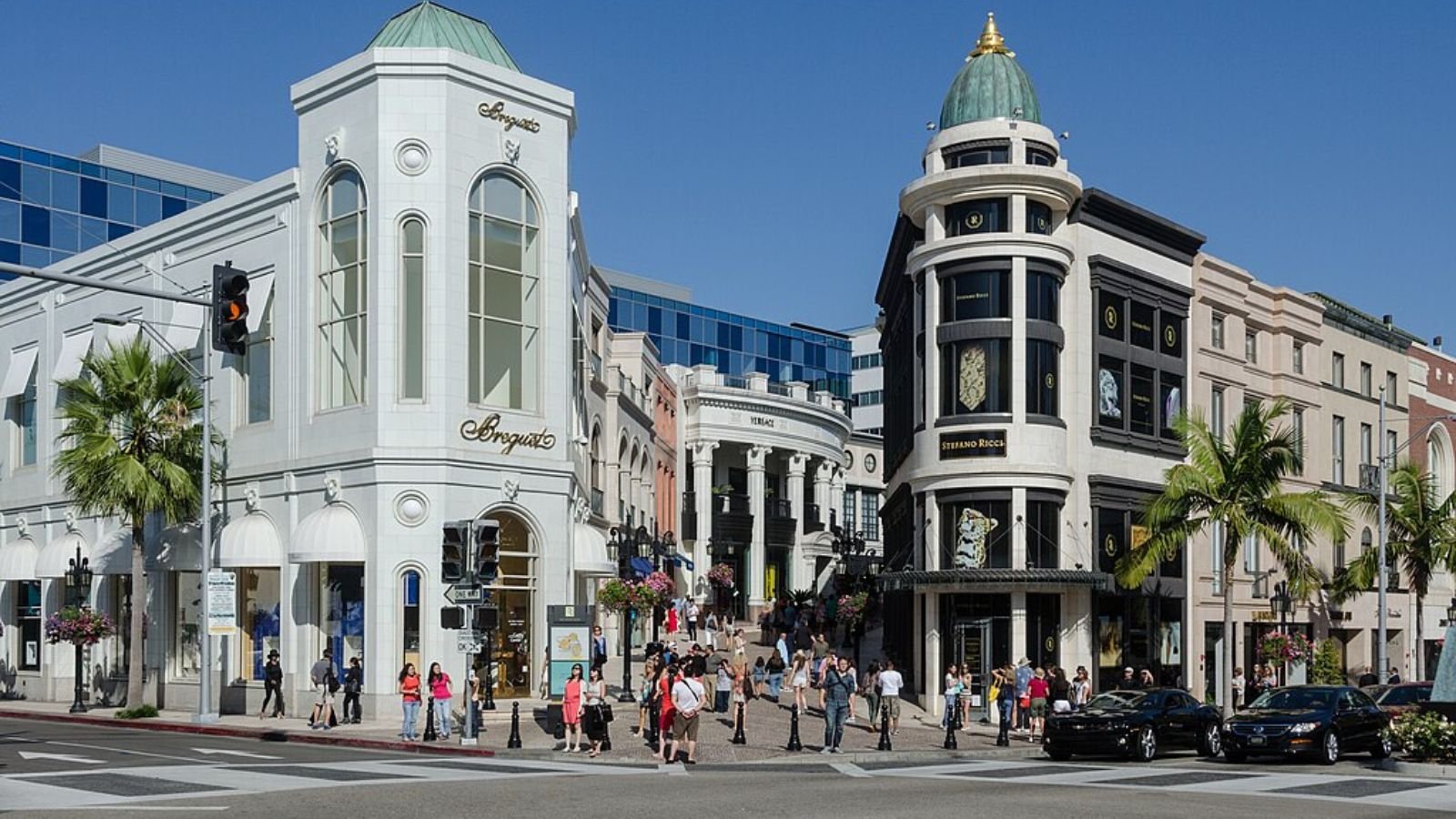
Why are people willing to pay so much to live here? What’s special about it?
Beverly Hills represents the pinnacle of luxury living, combining world-famous shopping on Rodeo Drive with prestigious residential neighborhoods and proximity to entertainment industry centers. The community offers exceptional dining, cultural amenities, and services that cater to affluent international clientele. Residents value the security, status, and sophisticated urban amenities that define this globally recognized luxury destination.
Limited residential inventory within the city’s small boundaries creates natural scarcity, while international recognition ensures sustained demand from global wealth. The combination of cultural significance, luxury amenities, and investment appeal maintains premium pricing despite market fluctuations.
How Beverly Hills Rose to Prominence
Beverly Hills was developed in the 1910s as a luxury residential community by Burton Green and other investors who recognized the area’s potential for upscale development. The construction of the Beverly Hills Hotel in 1912 established the community as a destination for wealthy visitors and residents. Early development featured large estates and luxury amenities that attracted Hollywood stars and business executives.
The community’s association with entertainment industry wealth grew throughout the 20th century as film studios and talent agencies established nearby operations. The development of Rodeo Drive as a luxury shopping destination and the area’s frequent appearance in popular media created global recognition that continues to attract international buyers and maintain premium property values.
3 Interesting Tidbits
1. Rodeo Drive – The world-famous luxury shopping street features flagship stores for the most prestigious fashion and jewelry brands, drawing visitors from around the globe.
2. Golden Triangle – The prime commercial district bounded by Wilshire Boulevard, Santa Monica Boulevard, and Canon Drive represents one of the world’s most valuable retail districts.
3. City Services – Beverly Hills maintains its own police and fire departments, providing exceptional public services that contribute to the community’s appeal and property values.
16. Palo Alto – 182% Home Price Increase Since 2010
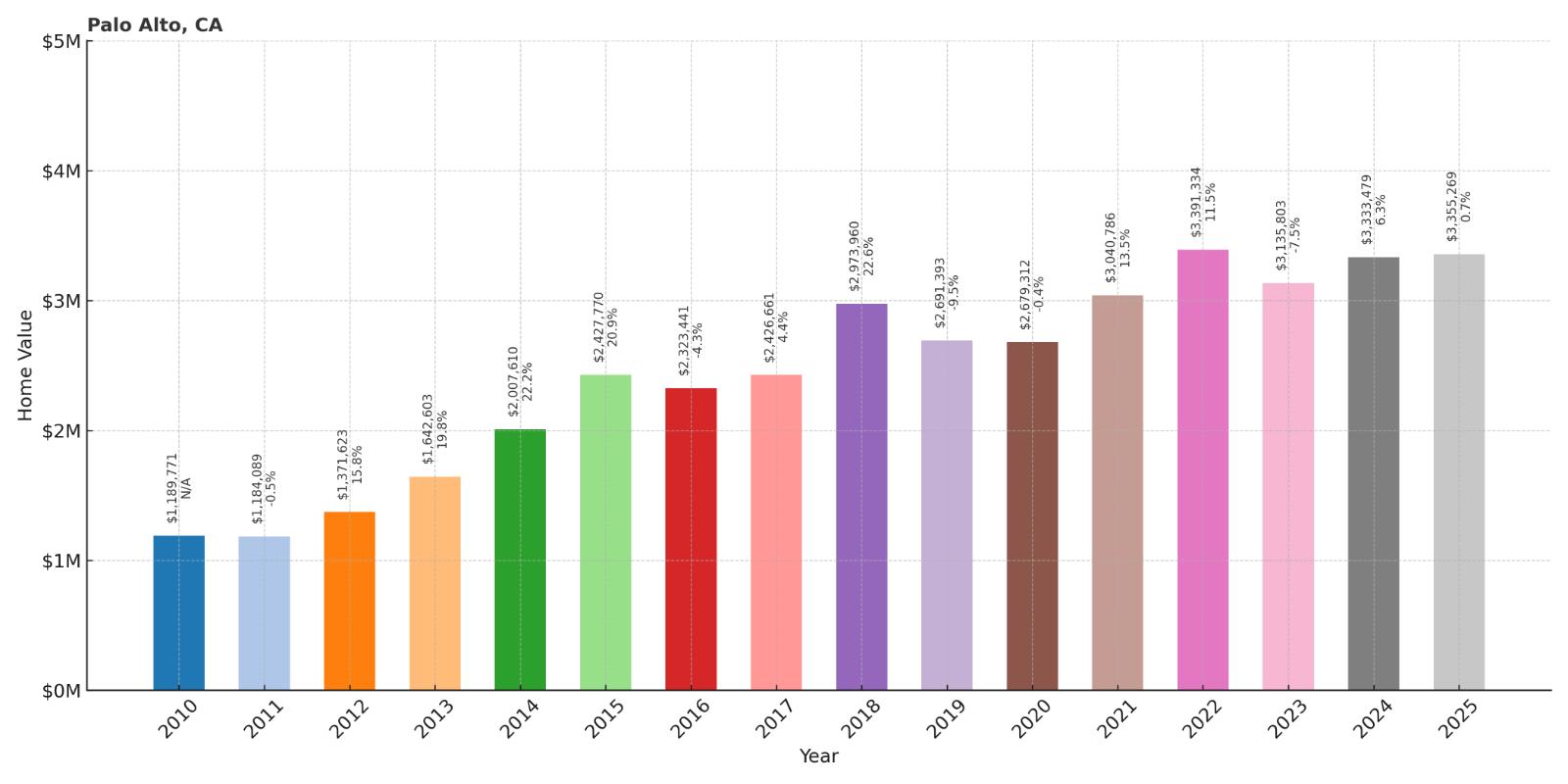
- 2010: $1,189,771
- 2011: $1,184,089
- 2012: $1,371,623
- 2013: $1,642,603
- 2014: $2,007,610
- 2015: $2,427,770
- 2016: $2,323,441
- 2017: $2,426,661
- 2018: $2,973,960
- 2019: $2,691,393
- 2020: $2,679,312
- 2021: $3,040,786
- 2022: $3,391,334
- 2023: $3,135,803
- 2024: $3,333,479
- 2025: $3,355,269
Palo Alto has shown remarkable appreciation since 2010, with home values nearly tripling over the 15-year period. The Silicon Valley epicenter experienced particularly strong growth during 2013-2015 and again in 2017-2018, driven by tech industry expansion. Current median values around $3.36 million reflect sustained demand from technology professionals and venture capital firms concentrated in this innovation hub.
Why Palo Alto?
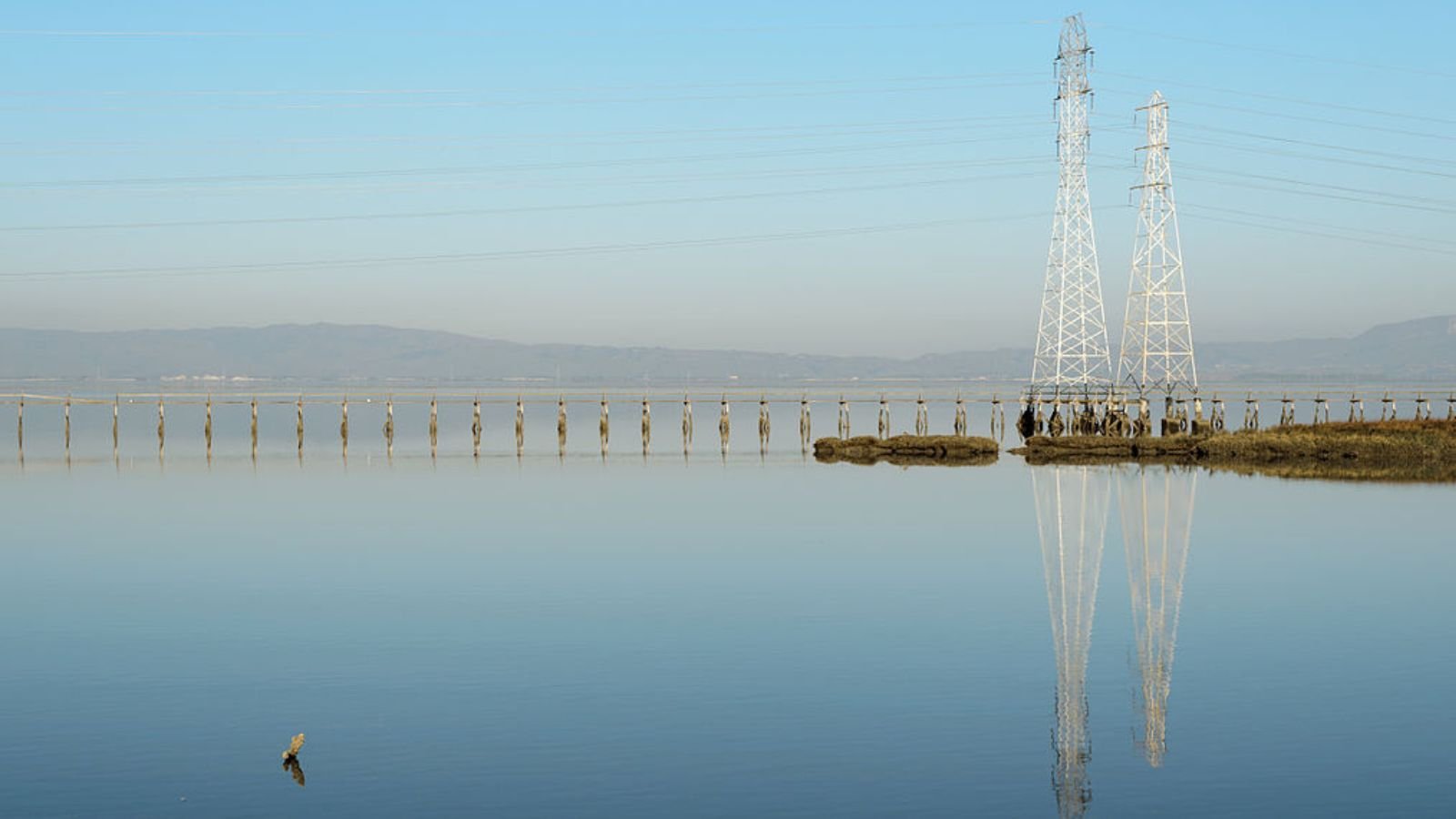
Why are people willing to pay so much to live here? What’s special about it?
Palo Alto serves as Silicon Valley’s intellectual and commercial center, offering proximity to Stanford University, major tech companies, and venture capital firms. The community features tree-lined streets, excellent schools, and cultural amenities that attract entrepreneurs, executives, and academics. Residents value the combination of innovation ecosystem access, educational excellence, and suburban quality of life that defines this unique technology hub.
Extremely limited housing supply relative to employment demand creates sustained upward pressure on prices. The concentration of high-paying technology jobs, world-class university resources, and venture capital ensures continued competition among buyers willing to pay premium prices for strategic location and lifestyle benefits.
How Palo Alto Rose to Prominence
Palo Alto was founded in 1894 around Stanford University, established by railroad magnate Leland Stanford as both an educational institution and planned community. The city’s early development emphasized tree-lined streets, parks, and quality housing that created an attractive environment for faculty and professionals. The presence of Stanford Research Institute and early technology companies established the area’s innovation character.
The post-war emergence of Silicon Valley transformed Palo Alto into the heart of global technology innovation. Companies like Hewlett-Packard, founded in a local garage, grew alongside venture capital firms and research institutions that created extraordinary wealth concentration. This unique ecosystem of talent, capital, and innovation continues to drive exceptional demand for residential property.
3 Interesting Tidbits
1. Stanford Shopping Center – The upscale outdoor mall serves as a regional shopping destination and community gathering place, reflecting the area’s affluent demographics.
2. Venture Capital Hub – Sand Hill Road houses many of the world’s most prestigious venture capital firms, making Palo Alto the global center of startup funding.
3. Garage Innovation – The legendary Hewlett-Packard garage, considered the birthplace of Silicon Valley, is now a California Historical Landmark located in the heart of Palo Alto.
15. Newport Beach – 160% Home Price Increase Since 2010
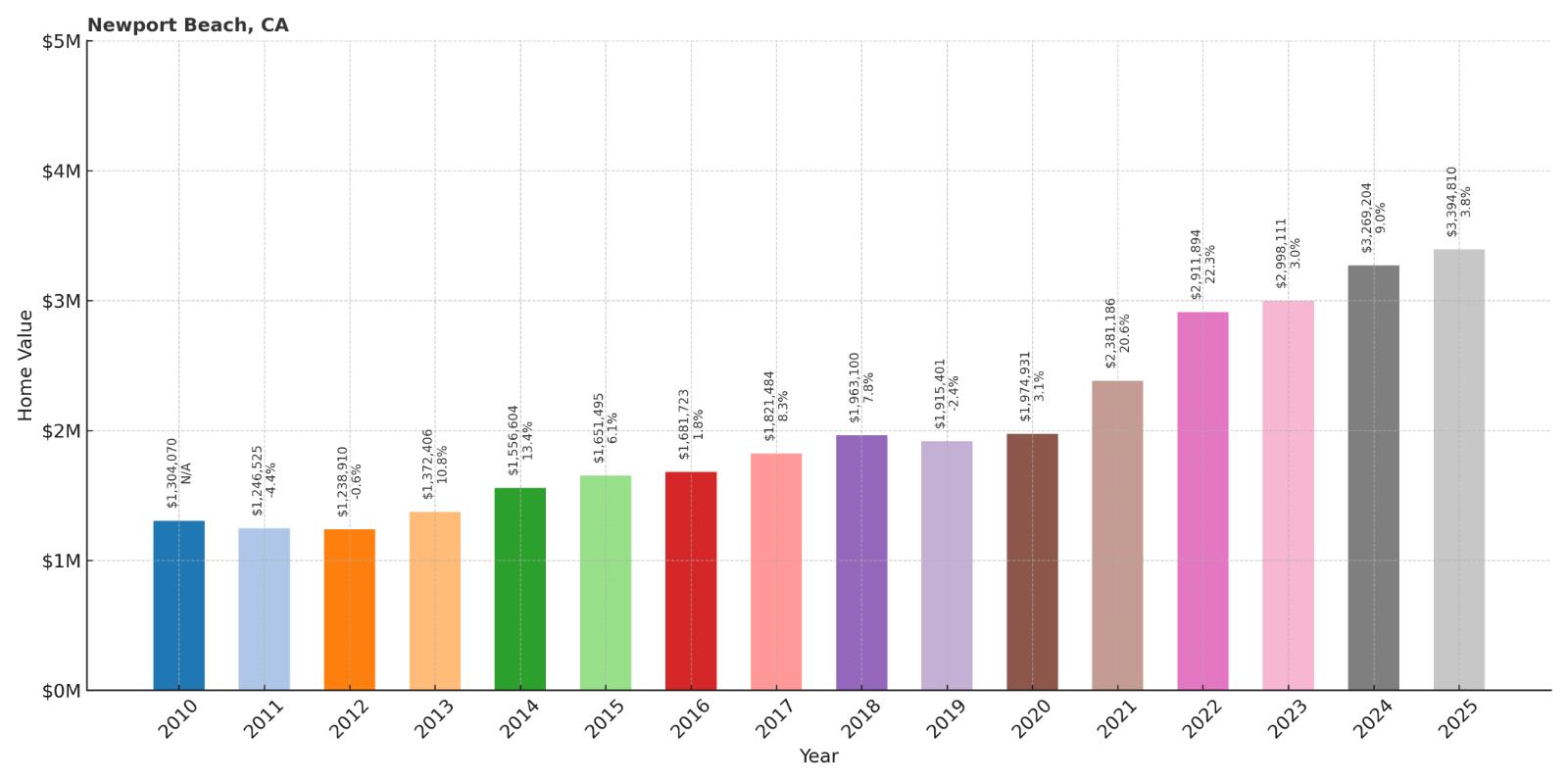
- 2010: $1,304,070
- 2011: $1,246,525
- 2012: $1,238,910
- 2013: $1,372,406
- 2014: $1,556,604
- 2015: $1,651,495
- 2016: $1,681,723
- 2017: $1,821,484
- 2018: $1,963,100
- 2019: $1,915,401
- 2020: $1,974,931
- 2021: $2,381,186
- 2022: $2,911,894
- 2023: $2,998,111
- 2024: $3,269,204
- 2025: $3,394,810
Newport Beach has shown consistent appreciation since 2010, with home values more than doubling over the 15-year period. The coastal Orange County community experienced particularly strong growth during 2021-2022 and continued rising through 2024-2025, reaching current median values around $3.39 million. The sustained demand reflects the community’s appeal as a luxury coastal destination with urban amenities.
Why Newport Beach?

Why are people willing to pay so much to live here? What’s special about it?
Newport Beach offers world-class waterfront living with excellent boating facilities, upscale shopping and dining, and proximity to Orange County business centers. The community features pristine beaches, championship golf courses, and luxury amenities that attract affluent professionals and retirees. Residents enjoy year-round outdoor recreation, from sailing and fishing to beach activities and water sports.
Limited beachfront inventory and controlled development ensure scarcity that supports premium pricing. The combination of coastal lifestyle, recreational amenities, and business proximity creates exceptional appeal among high-net-worth individuals seeking sophisticated beach living with urban convenience.
How Newport Beach Rose to Prominence
Newport Beach developed in the early 1900s around its natural harbor, which became a center for recreational boating and waterfront development. The construction of Balboa Island and the Balboa Peninsula created unique residential opportunities that attracted wealthy Southern California families seeking coastal retreats. Early development emphasized boating, fishing, and beach recreation that established the area’s maritime character.
The post-war suburban boom brought planned communities and luxury developments that transformed Newport Beach into a premier residential destination. The development of Fashion Island shopping center and nearby business districts created employment opportunities while maintaining the community’s resort-like atmosphere and recreational focus.
3 Interesting Tidbits
1. Balboa Island – The man-made island community features charming waterfront homes, pedestrian-friendly streets, and the famous Balboa Island Ferry that connects to the mainland.
2. Harbor Activities – Newport Harbor hosts numerous yacht clubs, marinas, and boat shows that make it one of the West Coast’s premier recreational boating destinations.
3. Fashion Island – The upscale outdoor shopping center serves as Orange County’s premier retail destination, featuring luxury brands and fine dining options.
14. Del Mar – 175% Home Price Increase Since 2010
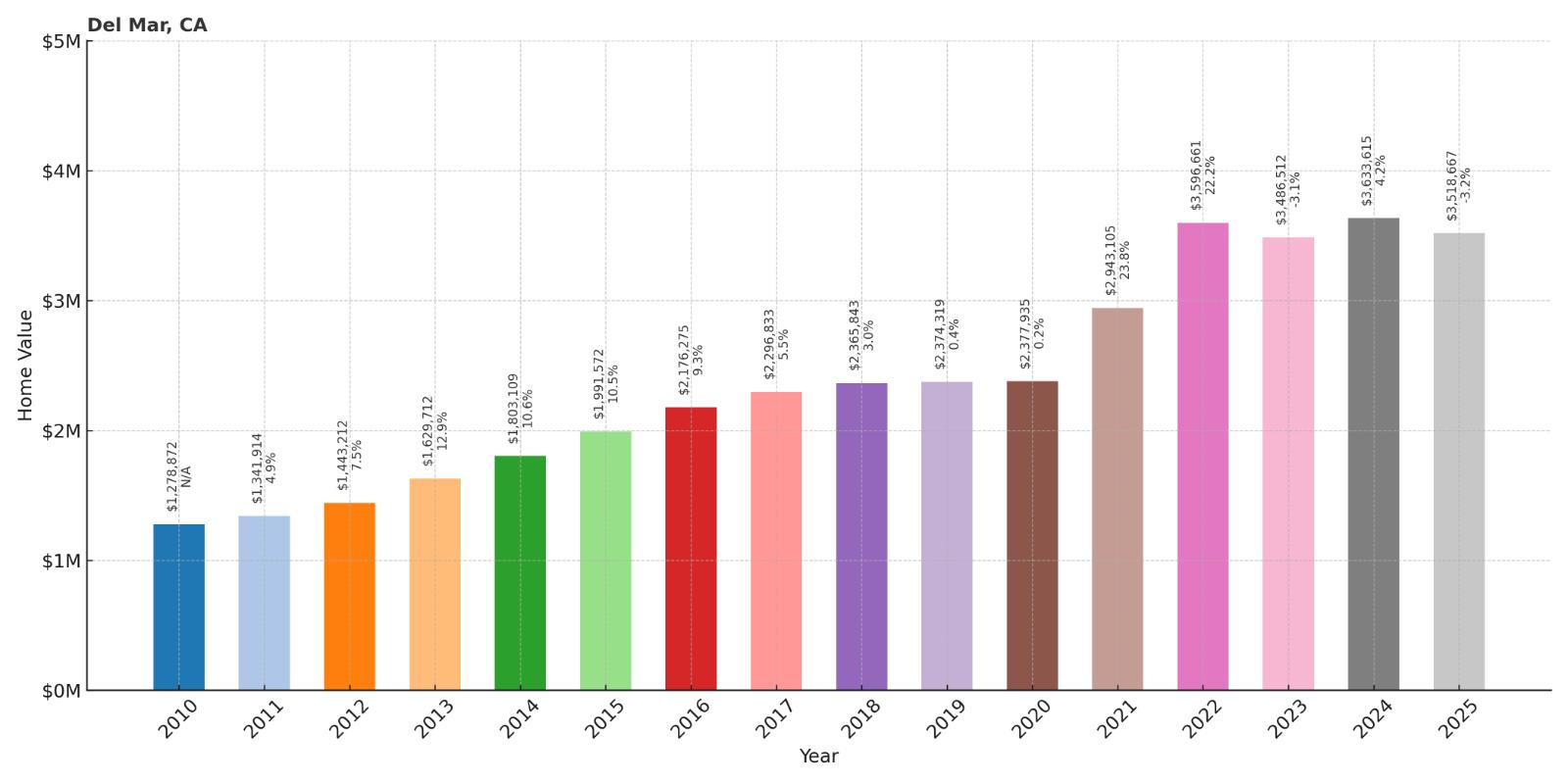
- 2010: $1,278,872
- 2011: $1,341,914
- 2012: $1,443,212
- 2013: $1,629,712
- 2014: $1,803,109
- 2015: $1,991,572
- 2016: $2,176,275
- 2017: $2,296,833
- 2018: $2,365,843
- 2019: $2,374,319
- 2020: $2,377,935
- 2021: $2,943,105
- 2022: $3,596,661
- 2023: $3,486,512
- 2024: $3,633,615
- 2025: $3,518,667
Del Mar has shown remarkable appreciation since 2010, with home values nearly tripling over the 15-year period. The coastal San Diego County community experienced steady growth with particularly dramatic increases during 2021-2022 when prices surged over 50% in two years. Current median values around $3.52 million reflect some recent moderation but maintain the community’s position as one of Southern California’s premier coastal destinations.
Why Del Mar?
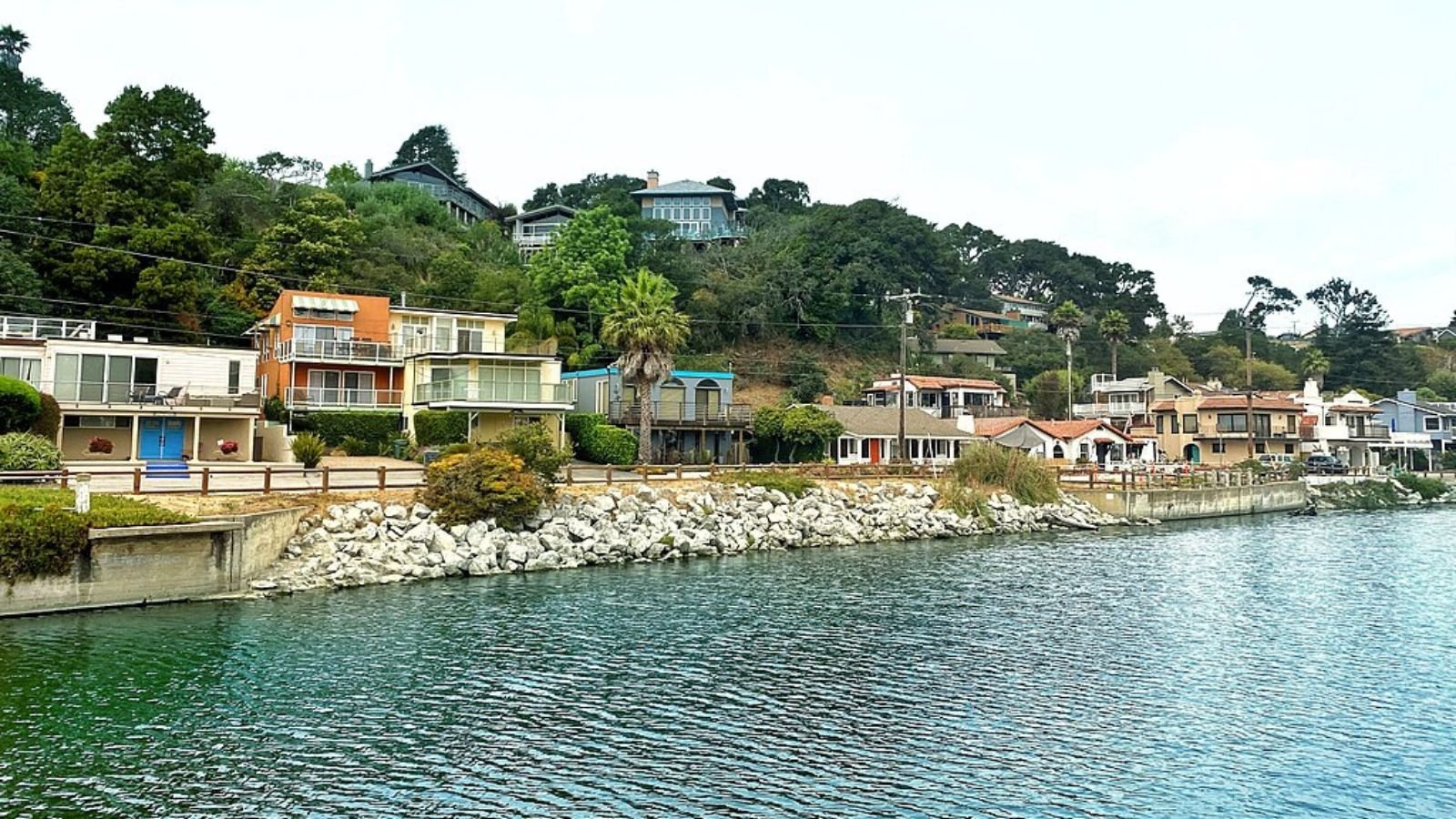
Why are people willing to pay so much to live here? What’s special about it?
Del Mar combines pristine coastal living with excellent dining, shopping, and recreational amenities that create a sophisticated beach town atmosphere. The community features beautiful beaches, the famous Del Mar Racetrack, and upscale neighborhoods that attract affluent professionals and retirees. Residents enjoy year-round outdoor activities, from beach recreation to horse racing and golf at nearby courses.
Limited developable beachfront land and environmental protections ensure housing scarcity, while the community’s reputation for luxury and recreation maintains sustained demand. The combination of natural beauty, cultural amenities, and proximity to San Diego creates exceptional appeal among high-net-worth individuals seeking coastal elegance.
How Del Mar Rose to Prominence
Del Mar was founded in the 1880s as a seaside resort destination, with early development centered around a hotel and railroad connection that brought visitors from throughout Southern California. The community’s reputation grew significantly with the establishment of Del Mar Racetrack in 1937, which attracted celebrities and wealthy visitors who began purchasing vacation homes in the area.
The post-war development boom brought careful residential expansion while preserving the community’s resort character and coastal access. The combination of racing prestige, beach recreation, and proximity to San Diego’s growing economy created sustained demand that drove property values steadily higher over subsequent decades.
3 Interesting Tidbits
1. Del Mar Racetrack – The “Where the Turf Meets the Surf” slogan captures the unique combination of horse racing and beach lifestyle that defines the community’s character.
2. Powerhouse Park – The clifftop park provides panoramic ocean views and serves as a venue for concerts and community events throughout the year.
3. Architectural Review – Strict design guidelines help maintain the community’s cohesive Mediterranean and coastal architectural character while protecting property values.
13. Ross – 79% Home Price Increase Since 2010

- 2010: $1,998,657
- 2011: $1,802,499
- 2012: $1,888,762
- 2013: $2,102,673
- 2014: $2,224,617
- 2015: $2,550,896
- 2016: $2,645,617
- 2017: $2,713,823
- 2018: $2,784,101
- 2019: $2,772,211
- 2020: $2,847,176
- 2021: $3,514,289
- 2022: $4,068,716
- 2023: $3,686,066
- 2024: $3,603,860
- 2025: $3,587,292
Ross has shown more modest but steady appreciation compared to other luxury markets, with values increasing around 79% since 2010. The exclusive Marin County community experienced its peak during 2022, reaching over $4 million, before moderating to current levels around $3.59 million. The market demonstrates stability with less volatility than flashier luxury destinations, reflecting the community’s established character and limited inventory.
Why Ross?
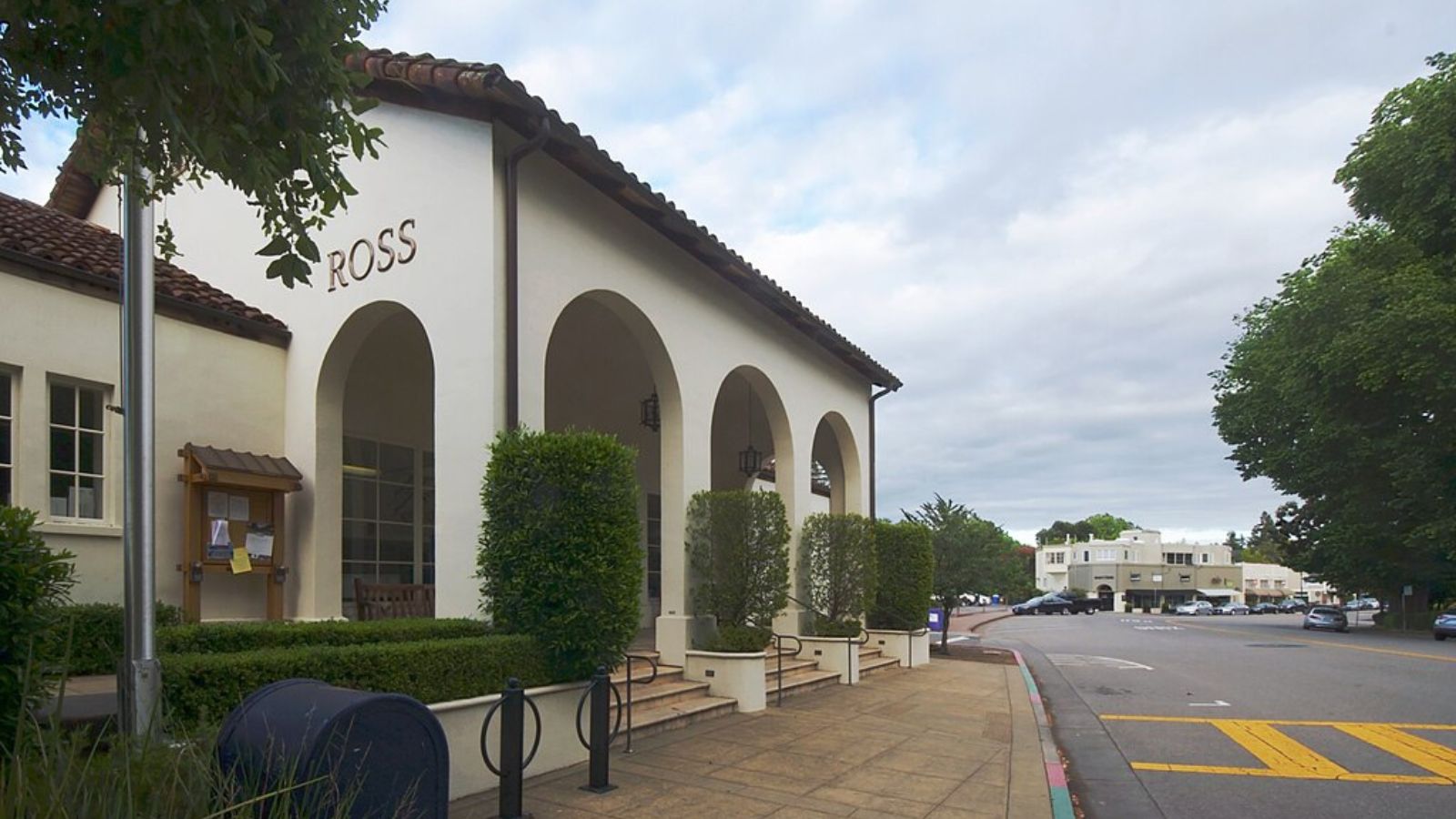
Why are people willing to pay so much to live here? What’s special about it?
Ross provides exceptional privacy and tranquility in a small, tight-knit community nestled beneath Mount Tamalpais, just 18 miles from San Francisco. The town features excellent public schools, beautiful tree-lined streets, and a strong sense of community that attracts high-income professionals seeking suburban quality of life. Residents value the rural atmosphere, large lots, and minimal commercial development that preserve the area’s residential character.
Strict zoning regulations and minimal new construction ensure low density and preserve property values. The combination of natural beauty, educational excellence, and proximity to urban employment centers creates sustained demand among affluent buyers seeking luxury suburban living with easy city access.
How Ross Rose to Prominence
Ross was established in the 1850s around the estate of James Ross, a Scottish immigrant who developed one of Marin County’s first large residential properties. The community grew slowly as a rural retreat for wealthy San Francisco families seeking country estates within reasonable commuting distance. Early development emphasized large lots, mature landscaping, and architectural quality that established the town’s exclusive character.
The community’s incorporation in 1908 allowed residents to maintain strict development controls that preserved the rural atmosphere as surrounding areas urbanized. The commitment to low density, excellent schools, and environmental protection created a unique residential environment that continues to attract affluent professionals and families.
3 Interesting Tidbits
1. No Sidewalks – The community maintains its rural character by avoiding sidewalks and street lights, preserving the natural landscape and country atmosphere.
2. Ross School – The highly rated elementary school serves as a community focal point and contributes significantly to the area’s appeal among families.
3. Phoenix Lake – The nearby reservoir and surrounding trails provide residents with recreational opportunities and natural open space that enhance property values.
12. Woodside – 132% Home Price Increase Since 2010
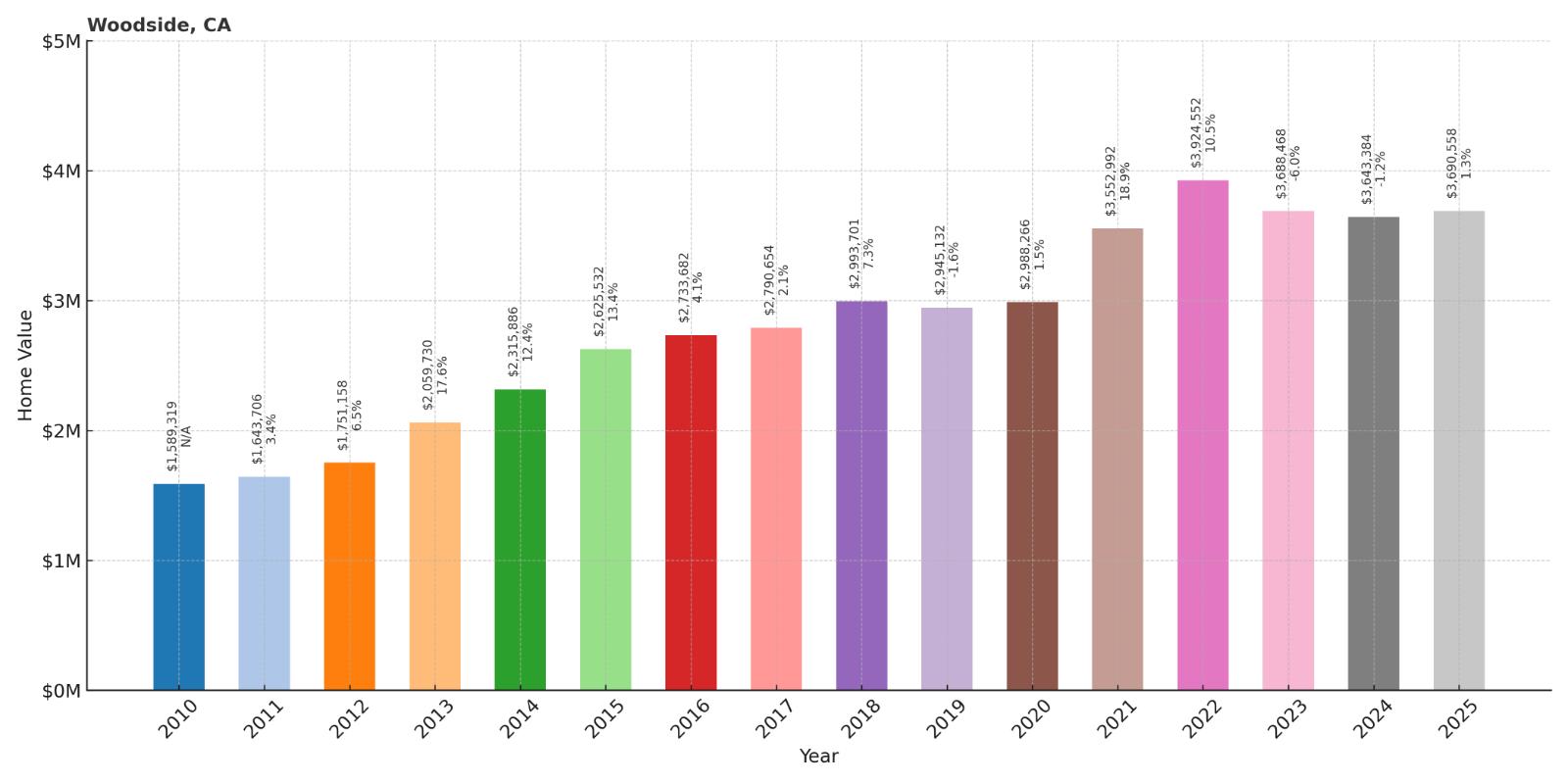
- 2010: $1,589,319
- 2011: $1,643,706
- 2012: $1,751,158
- 2013: $2,059,730
- 2014: $2,315,886
- 2015: $2,625,532
- 2016: $2,733,682
- 2017: $2,790,654
- 2018: $2,993,701
- 2019: $2,945,132
- 2020: $2,988,266
- 2021: $3,552,992
- 2022: $3,924,552
- 2023: $3,688,468
- 2024: $3,643,384
- 2025: $3,690,558
Woodside has shown consistent appreciation since 2010, more than doubling in value over the 15-year period. The San Mateo County community experienced steady growth with particularly strong gains during 2013-2016 and again in 2021-2022, reaching current median values around $3.69 million. The market has demonstrated resilience with continued appreciation despite broader luxury market adjustments.
Why Woodside?
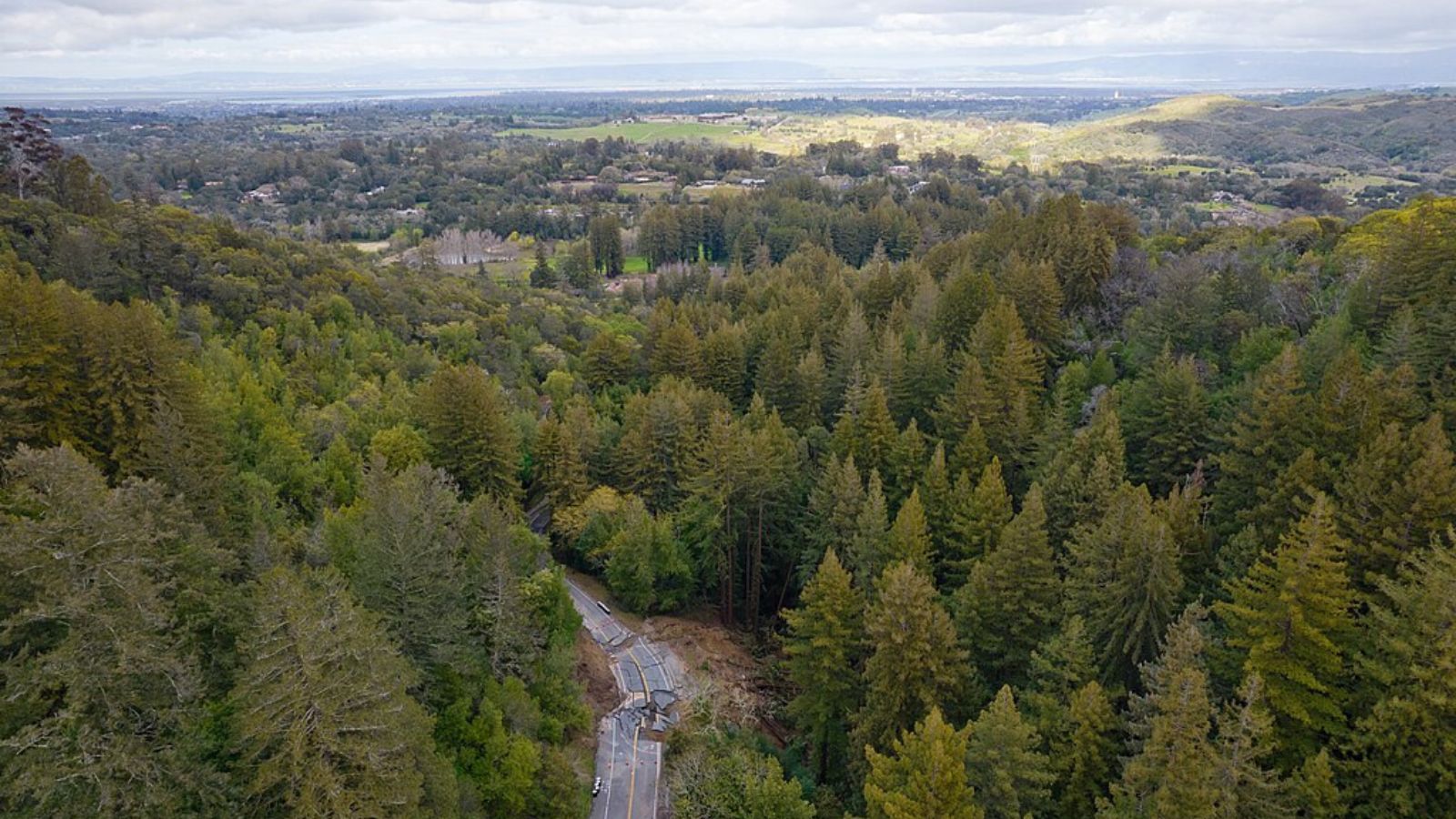
Why are people willing to pay so much to live here? What’s special about it?
Woodside offers expansive estate-style living on heavily forested lots that provide exceptional privacy while maintaining easy access to Silicon Valley employment centers. The community features equestrian facilities, hiking trails, and custom homes that create a rural retreat atmosphere. Residents value the combination of natural beauty, large lot sizes, and proximity to both San Francisco and major tech companies.
Limited development opportunities due to environmental constraints and large minimum lot requirements ensure housing scarcity. The concentration of technology industry wealth and the community’s reputation for discretion create sustained demand among high-net-worth individuals seeking luxury rural living.
How Woodside Rose to Prominence
Woodside developed in the late 1800s as a logging and lumber community, taking advantage of the area’s dense redwood forests. The completion of logging operations left large tracts of cleared land suitable for estates and residential development. Wealthy San Francisco families began establishing country retreats in the early 1900s, attracted by the natural beauty and relative accessibility.
The post-war technology boom transformed Woodside into a preferred residential location for Silicon Valley executives and entrepreneurs seeking privacy and natural beauty. The community’s commitment to preserving open space and limiting development created a unique residential environment that continues to attract affluent professionals from nearby tech centers.
3 Interesting Tidbits
1. Redwood Groves – Many properties feature preserved stands of ancient redwood trees that survived the area’s logging era and now provide natural privacy screens.
2. Equestrian Heritage – The community maintains numerous horse properties and riding trails that reflect its rural character and appeal to equestrian enthusiasts.
3. Filoli Estate – The historic mansion and gardens, now a National Trust property, exemplify the grand estate lifestyle that defines Woodside’s character.
11. Saratoga – 200% Home Price Increase Since 2010
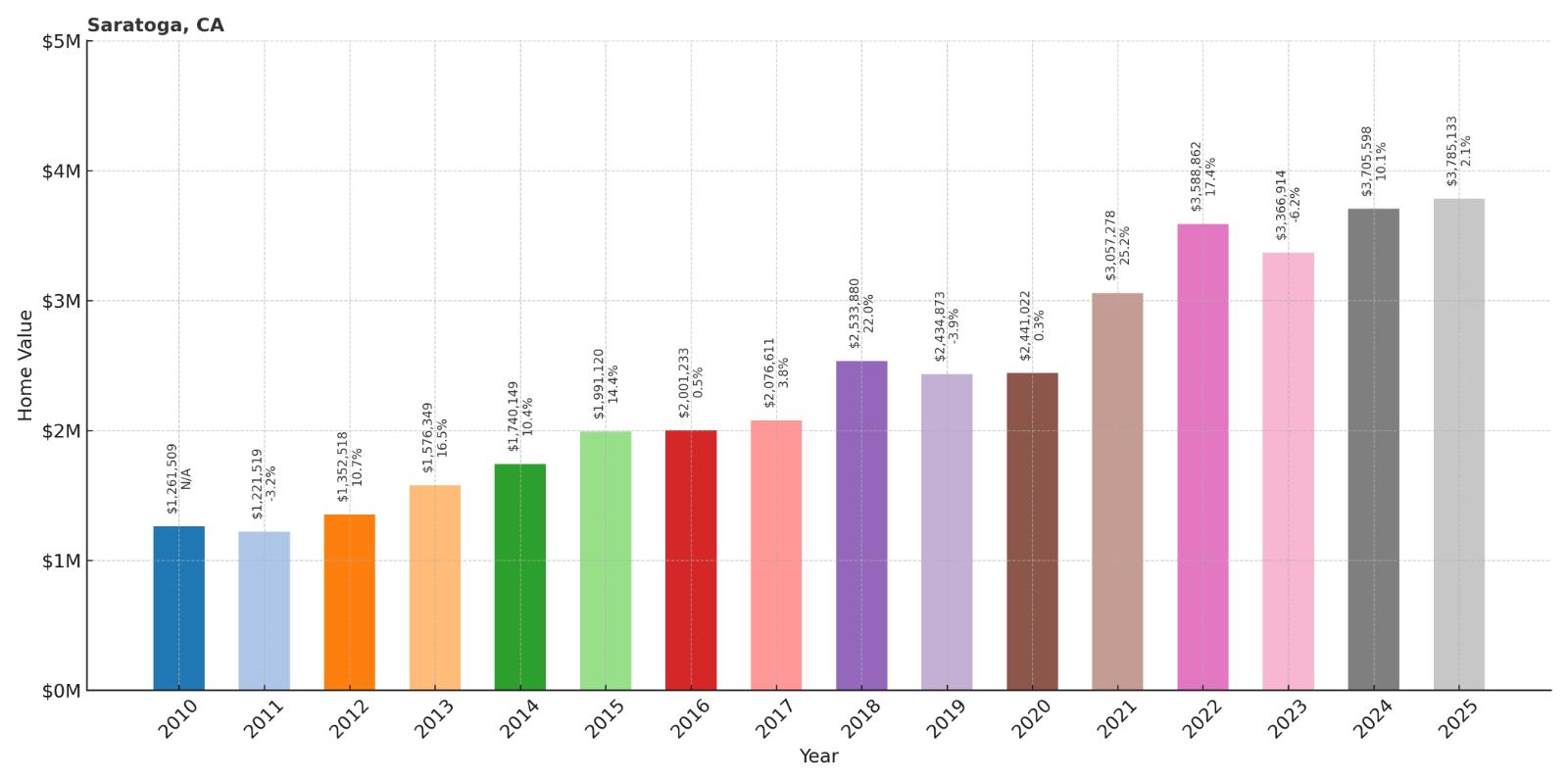
- 2010: $1,261,509
- 2011: $1,221,519
- 2012: $1,352,518
- 2013: $1,576,349
- 2014: $1,740,149
- 2015: $1,991,120
- 2016: $2,001,233
- 2017: $2,076,611
- 2018: $2,533,880
- 2019: $2,434,873
- 2020: $2,441,022
- 2021: $3,057,278
- 2022: $3,588,862
- 2023: $3,366,914
- 2024: $3,705,598
- 2025: $3,785,133
Saratoga has shown exceptional appreciation since 2010, with home values tripling over the 15-year period. The Santa Clara County community experienced particularly strong growth during 2017-2018 and again in 2021-2022, with continued increases through 2024-2025 reaching current median values around $3.79 million. The sustained demand reflects the community’s position as a premier Silicon Valley residential destination.
Why Saratoga?
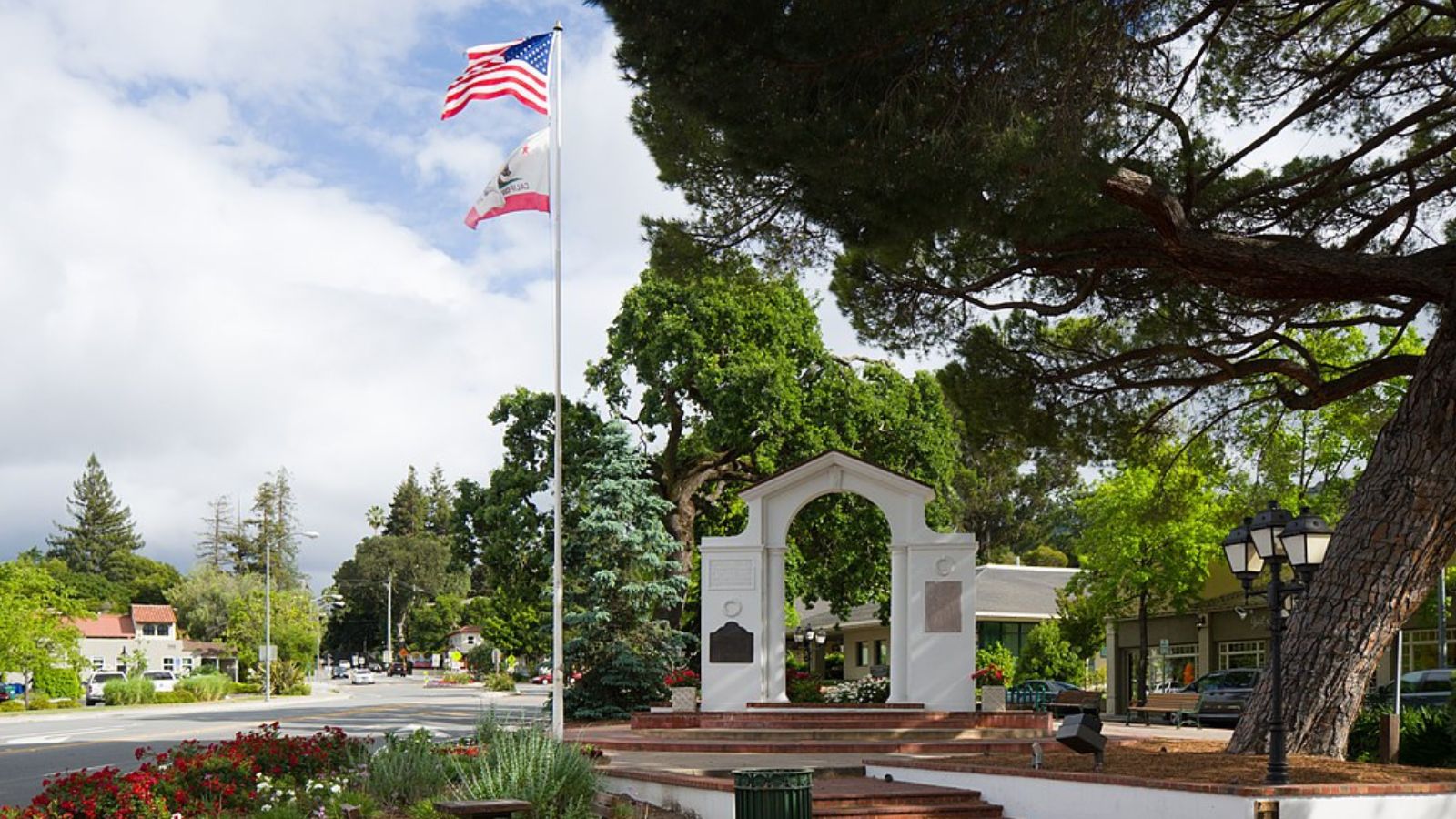
Why are people willing to pay so much to live here? What’s special about it?
Saratoga combines excellent schools with hillside locations that offer privacy and natural beauty while maintaining proximity to major Silicon Valley employers. The community features tree-lined streets, upscale neighborhoods, and recreational amenities that attract affluent families and technology professionals. Residents value the suburban quality of life, cultural facilities, and easy access to both urban employment and outdoor recreation.
Limited hillside development opportunities and excellent school districts create sustained demand that supports premium pricing. The combination of educational excellence, natural beauty, and strategic location ensures continued competition among buyers willing to pay top dollar for this unique residential environment.
How Saratoga Rose to Prominence
Saratoga began as a rural community centered around natural mineral springs that attracted visitors seeking health benefits in the late 1800s. The area’s transformation accelerated with improved transportation access and the post-war suburban development that brought planned neighborhoods and excellent schools. Early development emphasized quality construction and natural preservation that established the community’s upscale character.
The emergence of Silicon Valley as a global technology center transformed Saratoga into a preferred residential location for industry executives and professionals. The community’s commitment to educational excellence, environmental quality, and controlled development created a unique residential environment that continues to attract affluent tech industry families.
3 Interesting Tidbits
1. Hakone Gardens – The authentic Japanese garden provides residents and visitors with cultural enrichment and natural beauty that enhances the community’s appeal.
2. Saratoga High School – The highly rated public high school consistently ranks among California’s finest, making the area extremely attractive to families with school-age children.
3. Mountain Winery – The historic venue hosts concerts and events while offering panoramic views of Silicon Valley that showcase the area’s natural setting.
10. Portola Valley – 104% Home Price Increase Since 2010
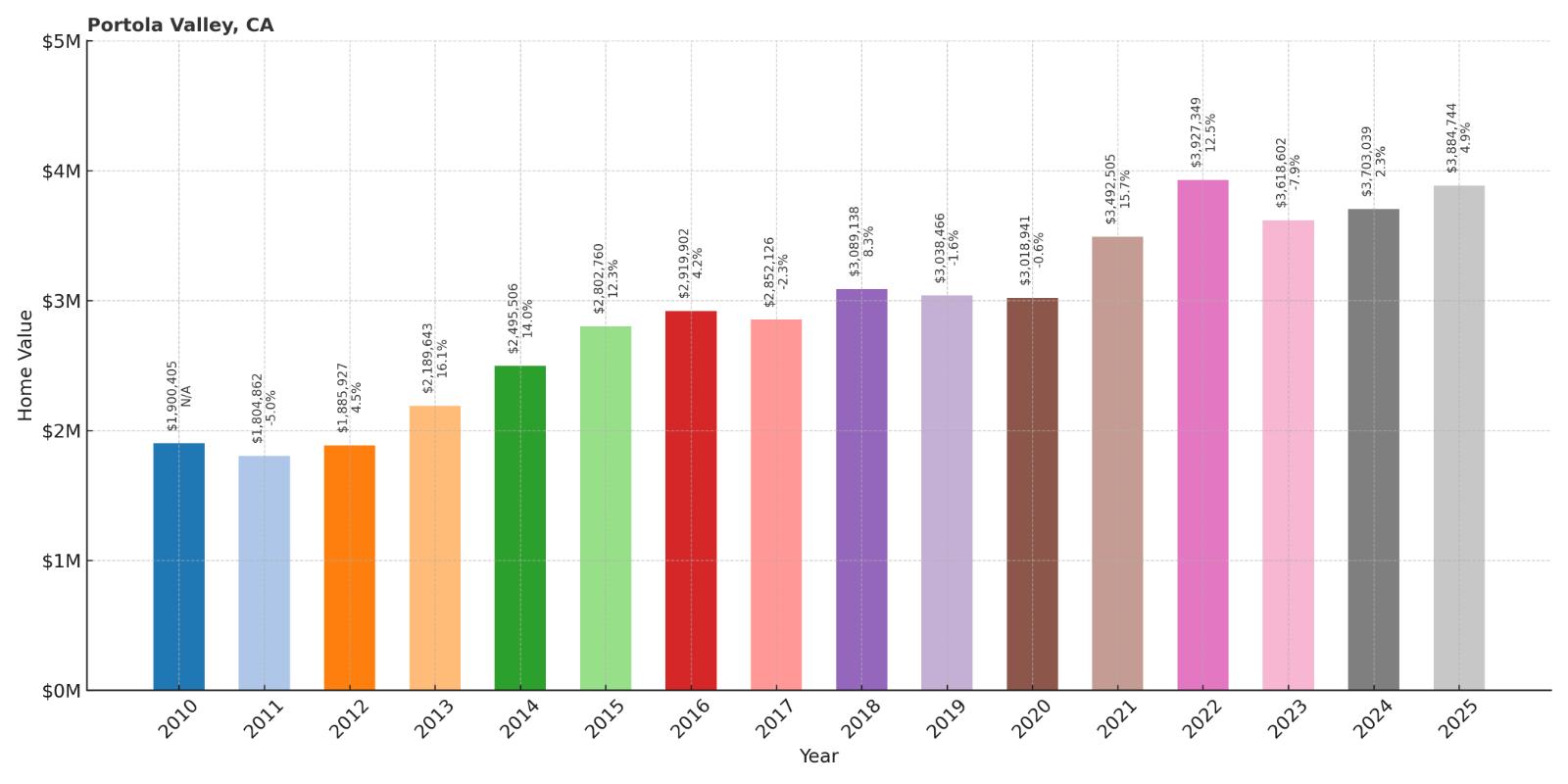
- 2010: $1,900,405
- 2011: $1,804,862
- 2012: $1,885,927
- 2013: $2,189,643
- 2014: $2,495,506
- 2015: $2,802,760
- 2016: $2,919,902
- 2017: $2,852,126
- 2018: $3,089,138
- 2019: $3,038,466
- 2020: $3,018,941
- 2021: $3,492,505
- 2022: $3,927,349
- 2023: $3,618,602
- 2024: $3,703,039
- 2025: $3,884,744
Portola Valley has shown steady appreciation since 2010, more than doubling in value over the 15-year period. The San Mateo County community experienced consistent growth with particularly strong gains during 2014-2016 and again in 2021-2022, reaching current median values around $3.88 million. The market demonstrates stability with continued recent appreciation despite broader luxury market volatility.
Why Portola Valley?
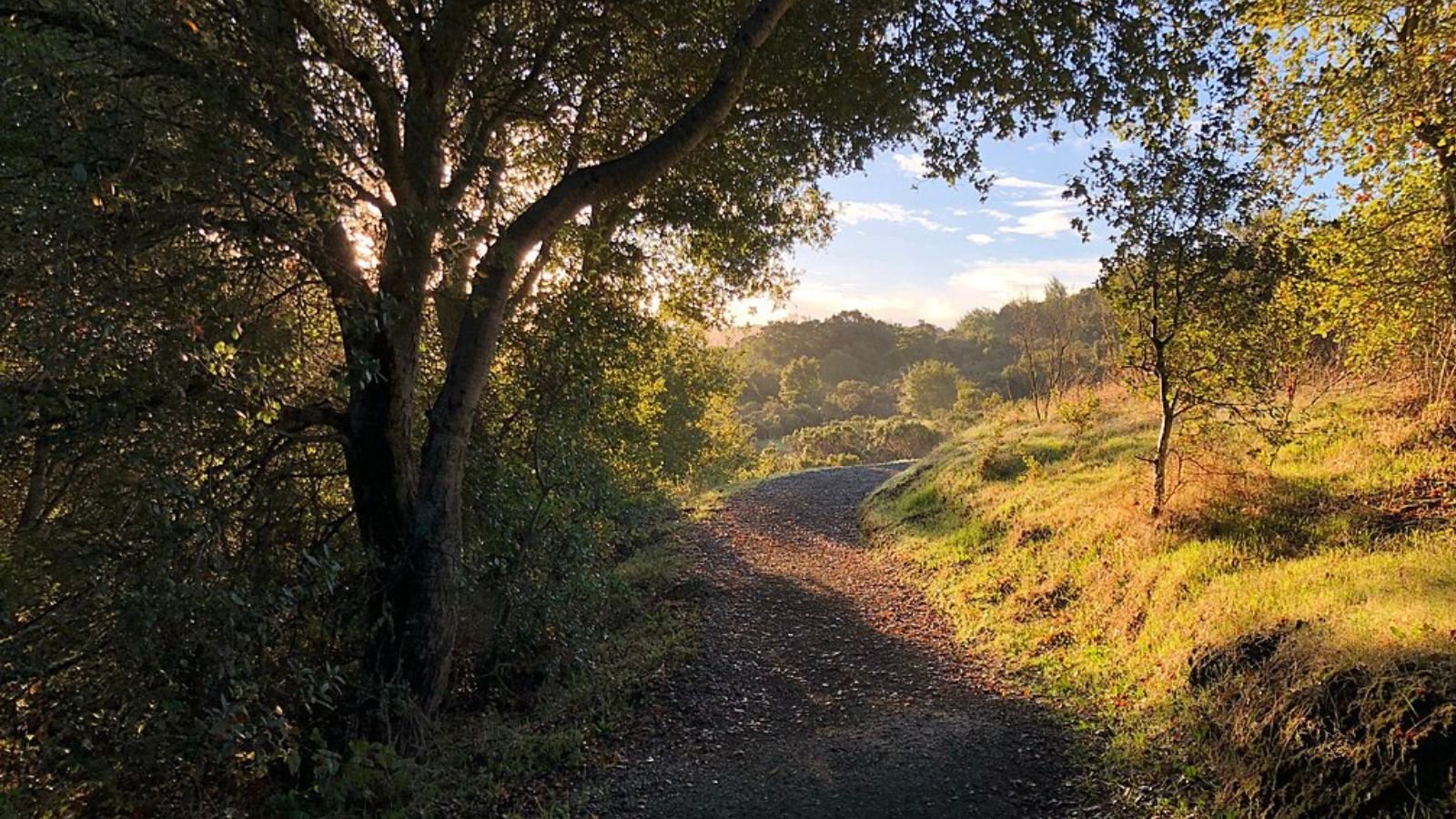
Why are people willing to pay so much to live here? What’s special about it?
Portola Valley provides expansive rural living with large lots, equestrian facilities, and natural beauty while maintaining convenient access to Silicon Valley employment centers. The community features hiking trails, open space preservation, and custom homes that create a country estate atmosphere. Residents value the privacy, environmental quality, and recreational opportunities that distinguish this enclave from typical suburban developments.
Strict development controls and large minimum lot sizes ensure low density and preserve the rural character. The combination of natural amenities, proximity to tech employment, and limited housing inventory creates sustained demand among affluent buyers seeking luxury country living with urban accessibility.
How Portola Valley Rose to Prominence
Portola Valley developed as ranch and agricultural land in the 1800s, with large properties supporting cattle and farming operations. The area’s transformation into an exclusive residential community began in the mid-20th century as wealthy professionals discovered its combination of natural beauty and proximity to urban employment centers. Early development emphasized large lots and environmental preservation that established the community’s rural luxury character.
The post-war technology boom brought Silicon Valley executives and entrepreneurs seeking country estates within commuting distance of major employers. The community’s incorporation in 1964 allowed residents to maintain strict zoning and environmental controls that preserved the area’s unique character while property values appreciated consistently.
3 Interesting Tidbits
1. Open Space Network – The community features extensive preserved open space and hiking trails that connect to regional parks and provide residents with exceptional recreational access.
2. Equestrian Community – Many properties maintain horse facilities and the area features numerous riding trails that reflect its rural heritage and current lifestyle preferences.
9. Monte Sereno – 166% Home Price Increase Since 2010
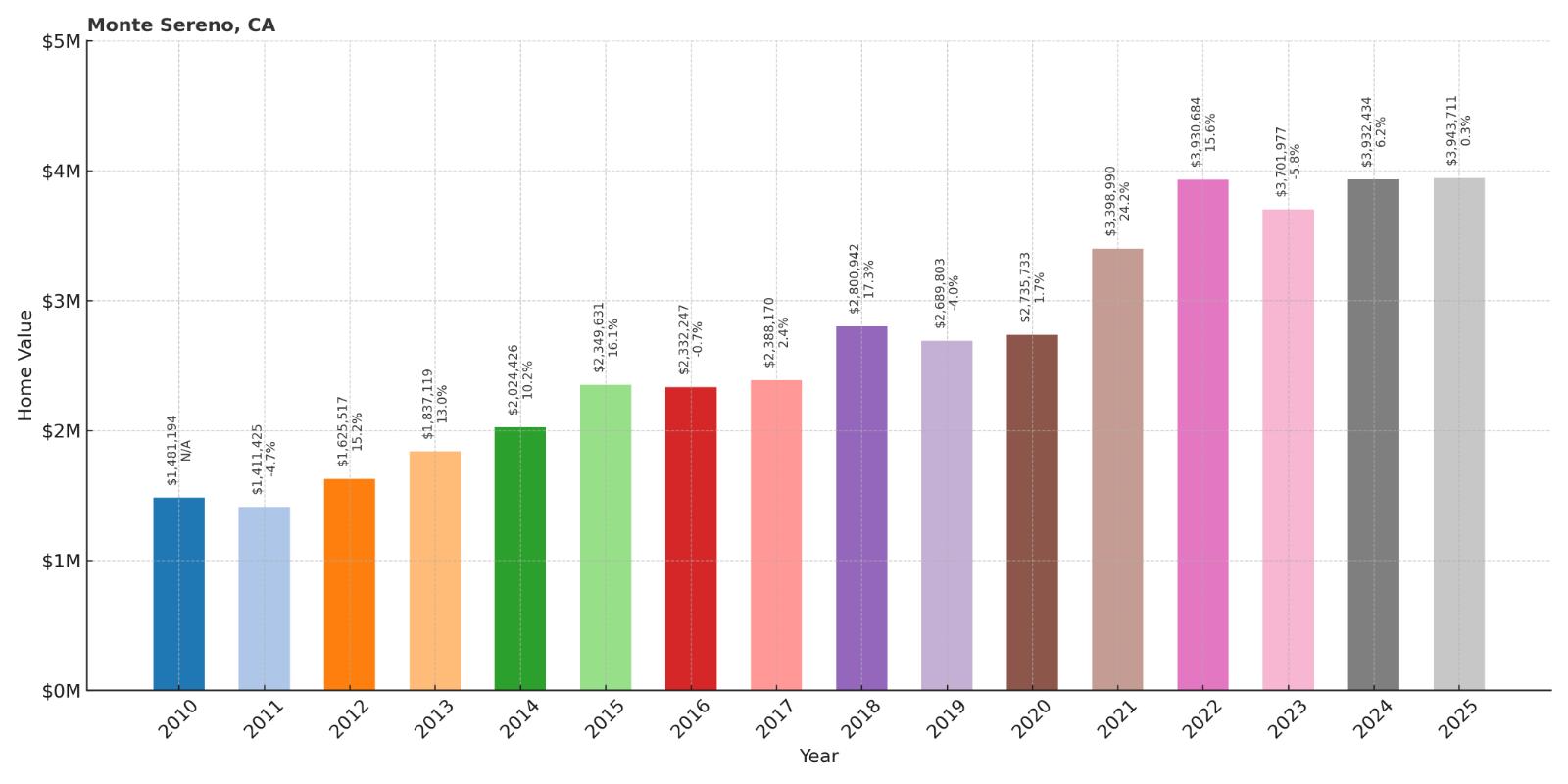
- 2010: $1,481,194
- 2011: $1,411,425
- 2012: $1,625,517
- 2013: $1,837,119
- 2014: $2,024,426
- 2015: $2,349,631
- 2016: $2,332,247
- 2017: $2,388,170
- 2018: $2,800,942
- 2019: $2,689,803
- 2020: $2,735,733
- 2021: $3,398,990
- 2022: $3,930,684
- 2023: $3,701,977
- 2024: $3,932,434
- 2025: $3,943,711
Monte Sereno has shown remarkable appreciation since 2010, with home values more than doubling over the 15-year period. The small Santa Clara County community experienced particularly dramatic growth during 2017-2018 and again in 2021-2022, with continued increases reaching current median values around $3.94 million. The sustained demand reflects the community’s exclusivity and strategic Silicon Valley location.
Why Monte Sereno?
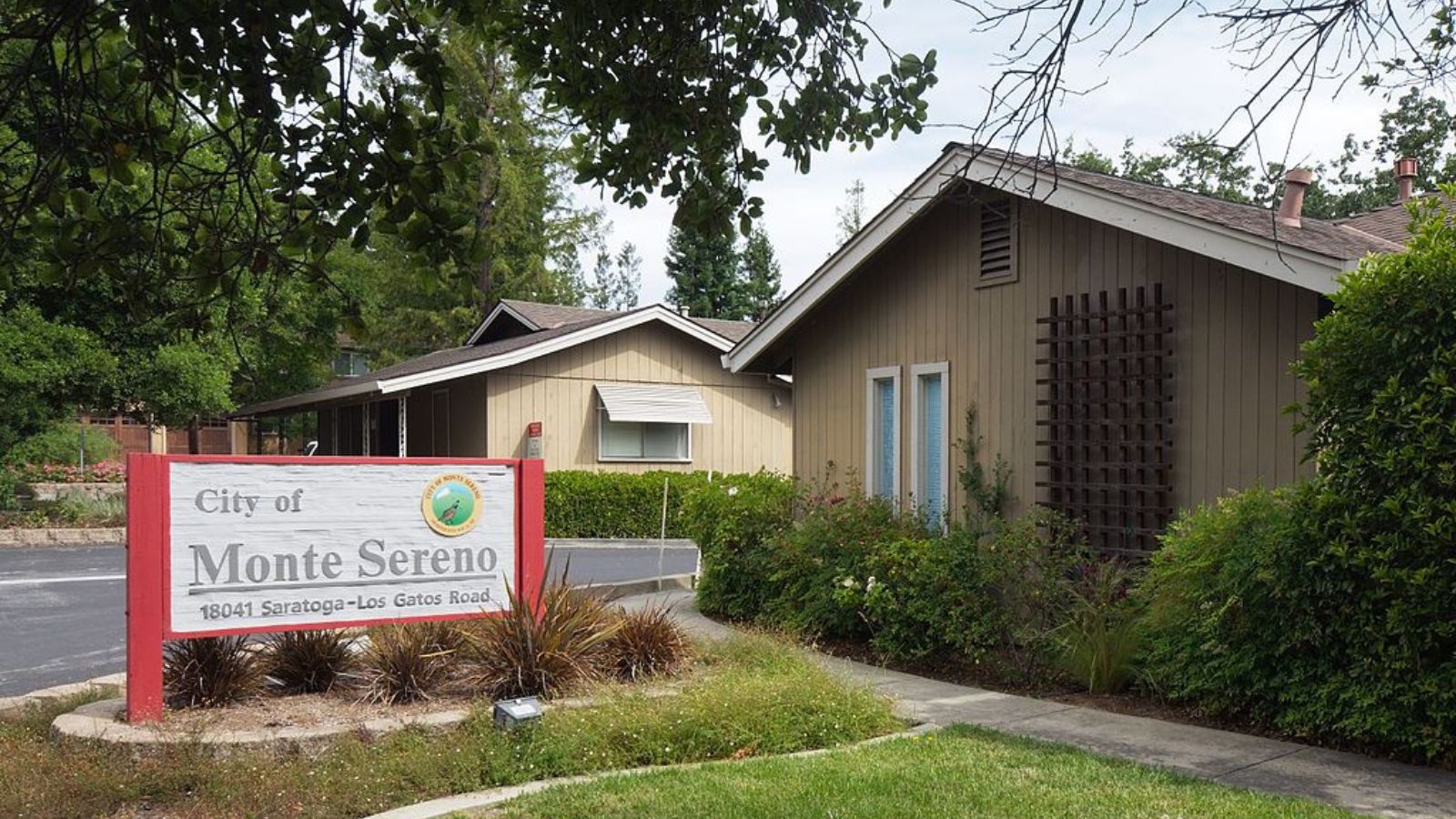
Why are people willing to pay so much to live here? What’s special about it?
Monte Sereno offers an intimate residential community with large lots, custom homes, and hillside locations that provide privacy while maintaining proximity to major Silicon Valley employers. The small city features tree-lined streets, excellent schools, and a rural atmosphere that attracts affluent families seeking suburban luxury. Residents value the combination of exclusivity, natural beauty, and easy access to technology industry centers.
Limited residential development opportunities and the community’s small size create natural scarcity that supports premium pricing. The concentration of technology wealth and the area’s reputation for quality construction ensure sustained demand among high-net-worth buyers seeking luxury suburban living.
How Monte Sereno Rose to Prominence
Monte Sereno was incorporated in 1957 as a small residential community designed to preserve rural character while providing luxury housing for Silicon Valley professionals. The community’s development emphasized large lots, quality construction, and environmental preservation that distinguished it from typical post-war suburban developments. Early residents included business executives and professionals who valued privacy and natural beauty.
The emergence of Silicon Valley as a global technology center transformed Monte Sereno into a preferred location for industry leaders and entrepreneurs. The community’s commitment to low density, excellent schools, and controlled development created a unique residential environment that continues to attract affluent tech industry families willing to pay premium prices.
3 Interesting Tidbits
1. Small Scale – Monte Sereno is one of California’s smallest incorporated cities, with just over 3,000 residents maintaining an intimate community atmosphere.
2. Los Gatos Creek – The creek running through the community provides natural amenities and recreational opportunities that enhance property values and quality of life.
3. Custom Homes – The majority of properties feature custom-built homes on large lots, creating architectural diversity while maintaining consistent luxury standards.
8. Rancho Santa Fe – 132% Home Price Increase Since 2010
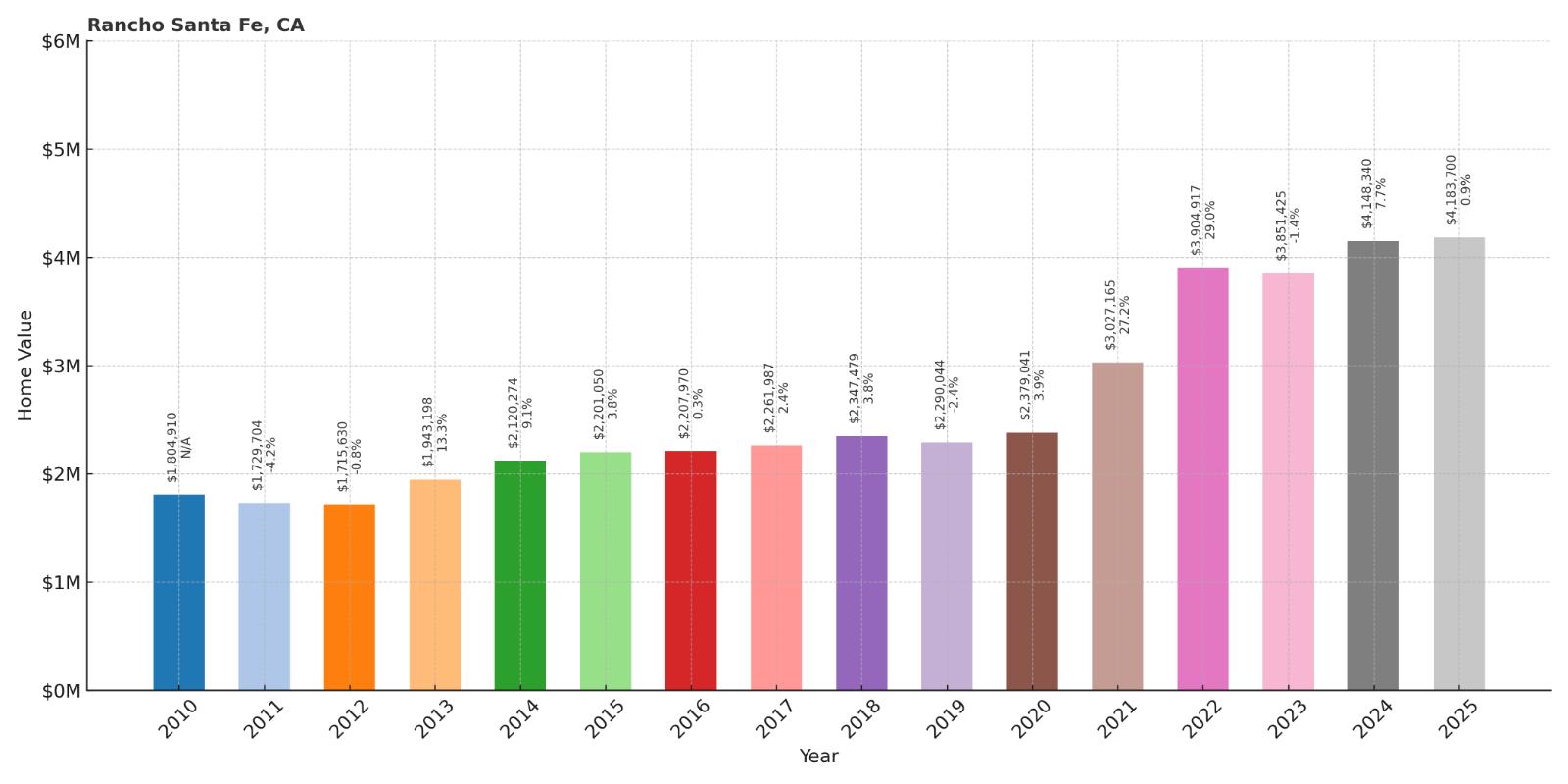
- 2010: $1,804,910
- 2011: $1,729,704
- 2012: $1,715,630
- 2013: $1,943,198
- 2014: $2,120,274
- 2015: $2,201,050
- 2016: $2,207,970
- 2017: $2,261,987
- 2018: $2,347,479
- 2019: $2,290,044
- 2020: $2,379,041
- 2021: $3,027,165
- 2022: $3,904,917
- 2023: $3,851,425
- 2024: $4,148,340
- 2025: $4,183,700
Rancho Santa Fe has shown steady appreciation since 2010, more than doubling in value over the 15-year period. The exclusive San Diego County community experienced explosive growth during 2021-2022 when prices surged over 60% in two years, with continued increases reaching current median values around $4.18 million. The market demonstrates the premium commanded by this legendary luxury enclave.
Why Rancho Santa Fe?

Why are people willing to pay so much to live here? What’s special about it?
Rancho Santa Fe provides exclusive estate living with large lots, championship golf courses, and equestrian facilities that create a luxury resort atmosphere. The community features Spanish Colonial architecture, mature landscaping, and recreational amenities that attract affluent retirees and business leaders. Residents enjoy privacy, security, and sophisticated amenities while maintaining reasonable access to San Diego’s business and cultural centers.
Strict architectural controls and large minimum lot requirements ensure consistency and exclusivity that support premium pricing. The combination of natural beauty, recreational facilities, and limited development opportunities creates sustained demand among wealthy buyers seeking luxury country club living.
How Rancho Santa Fe Rose to Prominence
Rancho Santa Fe was developed in the 1920s by the Santa Fe Railway as an exclusive residential community featuring Spanish Colonial architecture and extensive landscaping. The original development emphasized large estates, golf courses, and equestrian facilities that attracted wealthy families from throughout Southern California. Early residents included business leaders and celebrities who established the community’s reputation for luxury and exclusivity.
The post-war development boom brought careful expansion while maintaining the community’s architectural character and recreational focus. The establishment of multiple golf clubs and continued commitment to large-lot development created a unique luxury environment that continues to attract affluent buyers seeking resort-style living with urban accessibility.
3 Interesting Tidbits
1. Covenant Controls – The Rancho Santa Fe Association maintains strict architectural and landscaping requirements that ensure visual consistency and protect property values.
2. Golf Paradise – The community features multiple championship golf courses, including Rancho Santa Fe Golf Club, one of California’s most prestigious private clubs.
3. Eucalyptus Groves – The distinctive eucalyptus trees planted throughout the community create a unique landscape character that has become synonymous with Rancho Santa Fe luxury.
7. Los Altos – 212% Home Price Increase Since 2010
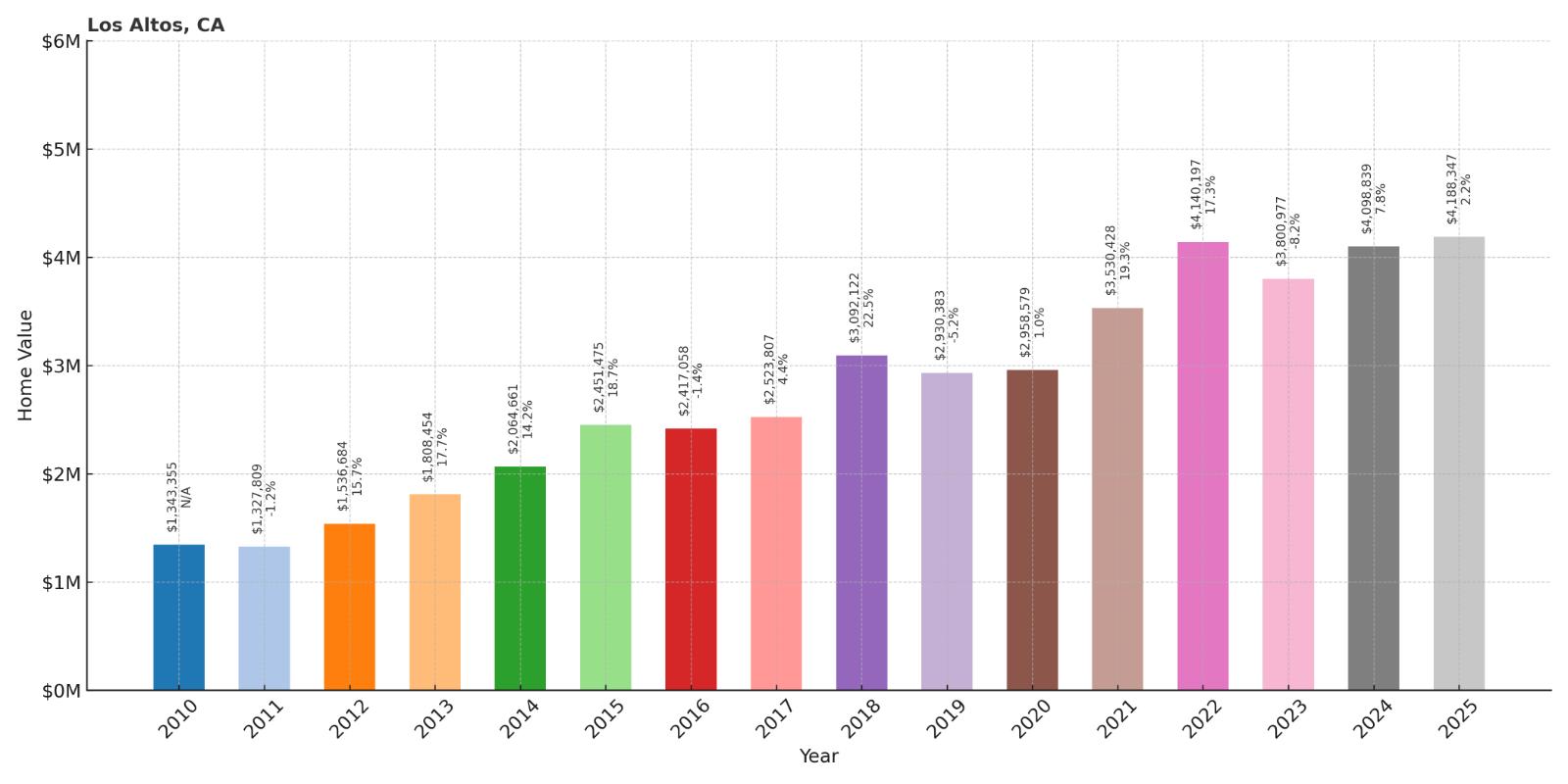
- 2010: $1,343,355
- 2011: $1,327,809
- 2012: $1,536,684
- 2013: $1,808,454
- 2014: $2,064,661
- 2015: $2,451,475
- 2016: $2,417,058
- 2017: $2,523,807
- 2018: $3,092,122
- 2019: $2,930,383
- 2020: $2,958,579
- 2021: $3,530,428
- 2022: $4,140,197
- 2023: $3,800,977
- 2024: $4,098,839
- 2025: $4,188,347
Los Altos has shown exceptional appreciation since 2010, with home values more than tripling over the 15-year period. The Santa Clara County community experienced particularly strong growth during 2014-2015, 2017-2018, and again in 2021-2022, reaching current median values around $4.19 million. The sustained demand reflects the community’s position as a premier Silicon Valley residential destination with exceptional schools and amenities.
Why Los Altos?
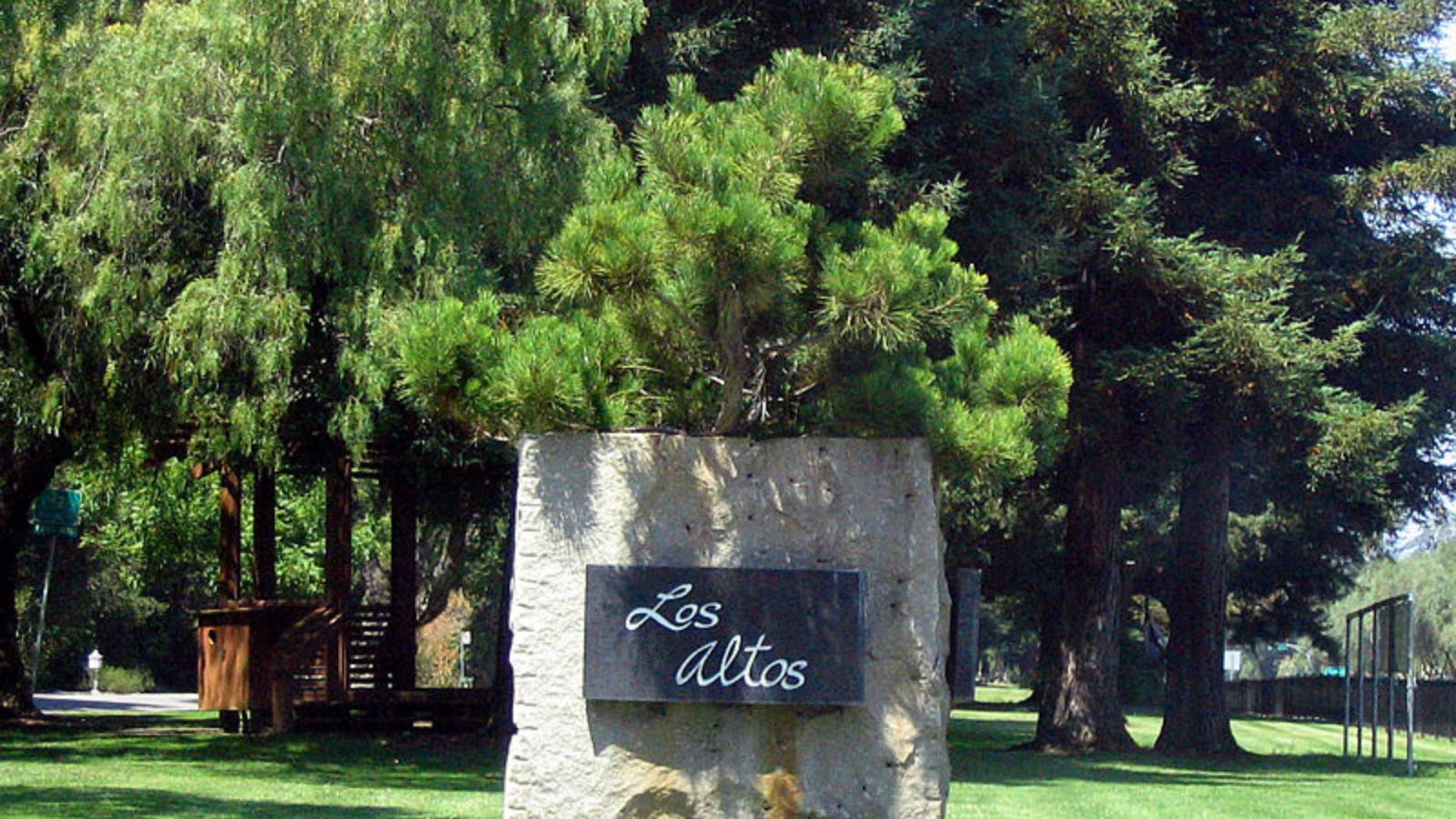
Why are people willing to pay so much to live here? What’s special about it?
Los Altos combines excellent public schools with tree-lined neighborhoods and proximity to major Silicon Valley employers, creating an ideal environment for affluent families. The community features large lots, quality construction, and cultural amenities that attract technology professionals and business executives. Residents value the suburban quality of life, educational excellence, and easy access to both urban employment and recreational opportunities.
Limited residential inventory and outstanding school districts create exceptional demand that drives premium pricing. The concentration of high-paying technology jobs and the community’s reputation for family-friendly living ensure continued competition among buyers willing to pay top dollar for this unique combination of benefits.
How Los Altos Rose to Prominence
Los Altos developed in the early 1900s as an agricultural community centered around fruit orchards and farming operations. The area’s transformation accelerated with post-war suburban development that brought planned neighborhoods and excellent schools designed to attract professional families. Early development emphasized quality construction and tree preservation that established the community’s upscale suburban character.
The emergence of Silicon Valley as a global technology center transformed Los Altos into a preferred residential location for industry executives and professionals. The community’s commitment to educational excellence, environmental quality, and controlled development created a unique family-oriented environment that continues to attract affluent tech industry families.
3 Interesting Tidbits
1. Los Altos School District – The highly rated public school system consistently ranks among California’s finest, making the area extremely attractive to families with children.
2. History Museum – The Los Altos History Museum preserves the community’s agricultural heritage while showcasing its transformation into a premier residential destination.
3. Tree City USA – Los Altos has been designated a Tree City USA for over 30 years, reflecting the community’s commitment to preserving its distinctive tree-lined character.
6. Belvedere – 91% Home Price Increase Since 2010
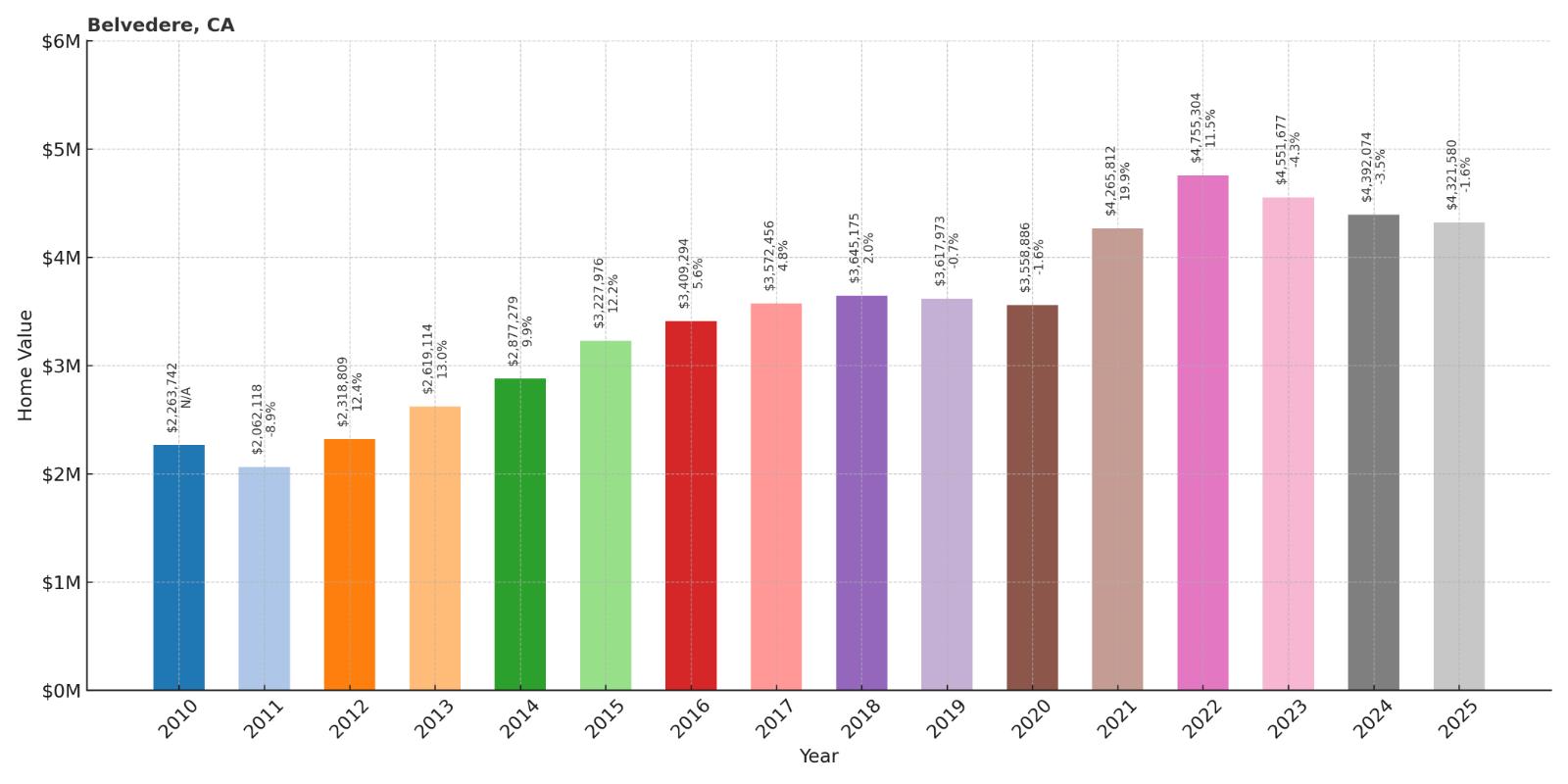
- 2010: $2,263,742
- 2011: $2,062,118
- 2012: $2,318,809
- 2013: $2,619,114
- 2014: $2,877,279
- 2015: $3,227,976
- 2016: $3,409,294
- 2017: $3,572,456
- 2018: $3,645,175
- 2019: $3,617,973
- 2020: $3,558,886
- 2021: $4,265,812
- 2022: $4,755,304
- 2023: $4,551,677
- 2024: $4,392,074
- 2025: $4,321,580
Belvedere has shown steady appreciation since 2010, nearly doubling in value over the 15-year period despite starting from a higher baseline than most communities. The exclusive Marin County island community experienced consistent growth with particularly strong gains during 2021-2022, reaching current median values around $4.32 million. The market demonstrates the premium commanded by this unique waterfront enclave.
Why Belvedere?
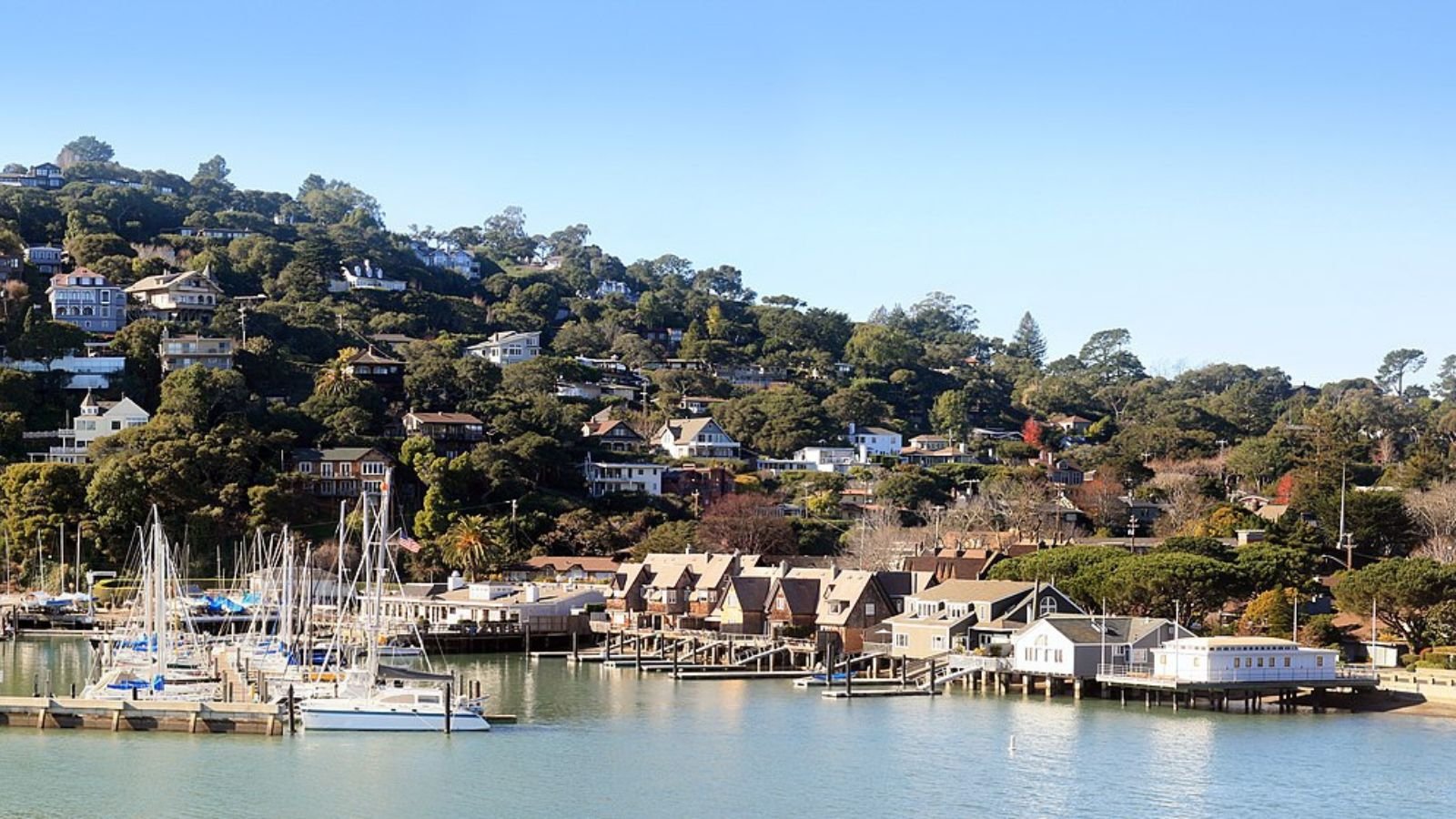
Why are people willing to pay so much to live here? What’s special about it?
Belvedere offers exclusive island living with panoramic San Francisco Bay views and immediate water access while maintaining easy ferry connections to urban employment centers. The community features waterfront properties, yacht clubs, and sophisticated amenities that attract affluent professionals and executives. Residents enjoy exceptional privacy, recreational boating opportunities, and sophisticated community atmosphere that defines luxury waterfront living.
Limited developable waterfront land and the community’s island location create natural scarcity that supports premium pricing. The combination of water access, privacy, and urban proximity ensures sustained demand among wealthy buyers seeking the ultimate Bay Area waterfront lifestyle.
How Belvedere Rose to Prominence
Belvedere developed as an exclusive residential community in the early 1900s, taking advantage of its island location and panoramic bay views to attract wealthy San Francisco families seeking waterfront retreats. The community’s development emphasized large lots, quality architecture, and recreational boating facilities that established its reputation as a luxury destination.
The post-war suburban boom brought additional development while maintaining the island’s exclusive character and environmental quality. The establishment of yacht clubs and marina facilities created a unique waterfront community that continues to attract affluent buyers seeking luxury island living with urban accessibility.
3 Interesting Tidbits
1. Island Community – Belvedere is one of California’s few incorporated island communities, providing residents with exceptional privacy and water access.
2. Yacht Clubs – Multiple private yacht clubs serve the community, making it a premier destination for recreational boating enthusiasts throughout the Bay Area.
3. Ferry Access – Regular ferry service to San Francisco provides residents with scenic commuting options while avoiding bridge traffic entirely.
5. Hidden Hills – 195% Home Price Increase Since 2010

- 2010: $1,650,468
- 2011: $1,586,581
- 2012: $1,543,434
- 2013: $1,700,018
- 2014: $1,921,586
- 2015: $2,007,445
- 2016: $2,066,878
- 2017: $2,391,656
- 2018: $2,961,350
- 2019: $3,034,534
- 2020: $3,123,583
- 2021: $3,972,961
- 2022: $4,812,869
- 2023: $4,600,559
- 2024: $4,712,568
- 2025: $4,868,785
Hidden Hills has shown exceptional appreciation since 2010, with home values nearly tripling over the 15-year period. The exclusive Los Angeles County community experienced particularly dramatic growth during 2017-2020 and again in 2021-2022, with continued increases reaching current median values around $4.87 million. The sustained demand reflects the community’s appeal as a celebrity enclave with ultimate privacy and luxury amenities.
Why Hidden Hills?

Why are people willing to pay so much to live here? What’s special about it?
Hidden Hills provides complete privacy and security within a gated community that attracts celebrities, athletes, and business executives seeking maximum discretion. The community features large equestrian properties, custom estates, and recreational facilities that create a country club atmosphere just minutes from Los Angeles entertainment centers. Residents enjoy exclusive amenities including riding trails, tennis facilities, and community centers while maintaining easy access to urban employment.
The completely gated community with controlled access ensures exceptional security and privacy that commands premium pricing. The combination of celebrity cachet, luxury amenities, and strategic location creates sustained demand among high-profile buyers willing to pay top dollar for ultimate exclusivity.
How Hidden Hills Rose to Prominence
Hidden Hills was developed in the 1950s as an exclusive equestrian community designed to provide country living within the Los Angeles metropolitan area. The community’s development emphasized large lots, horse facilities, and recreational amenities that attracted wealthy families seeking rural luxury with urban accessibility. Early residents included business executives and entertainment industry professionals who established the area’s upscale character.
The community’s association with celebrity residents grew throughout the following decades as entertainment industry success created demand for private, secure residential environments. The commitment to gated security, large lots, and recreational facilities created a unique luxury enclave that continues to attract high-profile residents seeking ultimate privacy and exclusivity.
3 Interesting Tidbits
1. Celebrity Central – Hidden Hills has been home to numerous A-list celebrities including members of the Kardashian family, Drake, and many other entertainment industry stars.
2. Equestrian Paradise – The community features extensive bridle trails and equestrian facilities that allow residents to enjoy horseback riding throughout the gated enclave.
3. No Sidewalks Policy – The community maintains its rural character by avoiding sidewalks and street lights, preserving the country atmosphere despite its proximity to Los Angeles.
4. Hillsborough – 140% Home Price Increase Since 2010
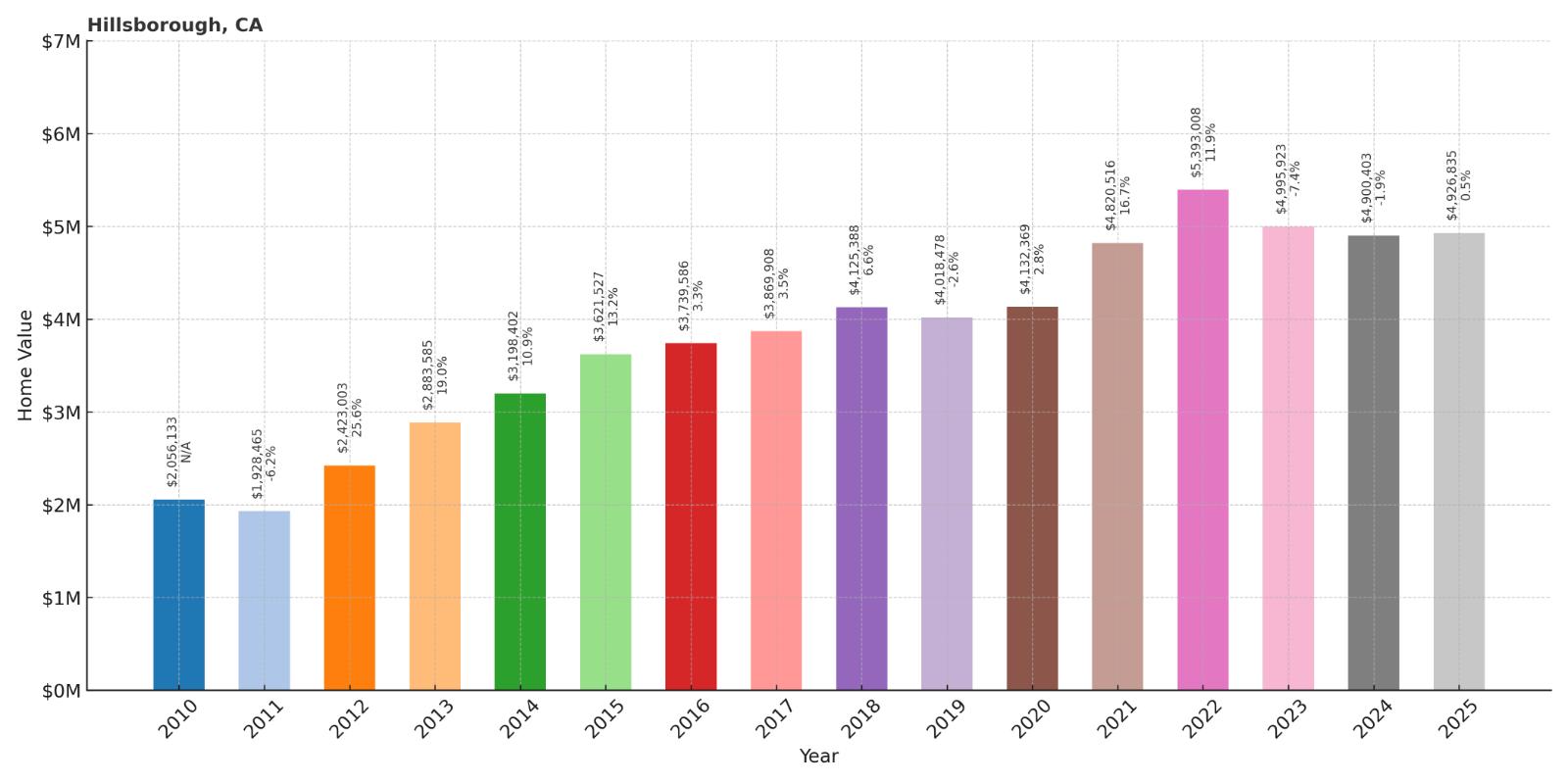
- 2010: $2,056,133
- 2011: $1,928,465
- 2012: $2,423,003
- 2013: $2,883,585
- 2014: $3,198,402
- 2015: $3,621,527
- 2016: $3,739,586
- 2017: $3,869,908
- 2018: $4,125,388
- 2019: $4,018,478
- 2020: $4,132,369
- 2021: $4,820,516
- 2022: $5,393,008
- 2023: $4,995,923
- 2024: $4,900,403
- 2025: $4,926,835
Hillsborough has shown consistent appreciation since 2010, more than doubling in value over the 15-year period despite starting from an already premium baseline. The San Mateo County community experienced steady growth with particularly strong gains during 2021-2022, reaching current median values around $4.93 million. The market demonstrates the sustained appeal of this established luxury enclave among Bay Area’s most affluent buyers.
Why Hillsborough?
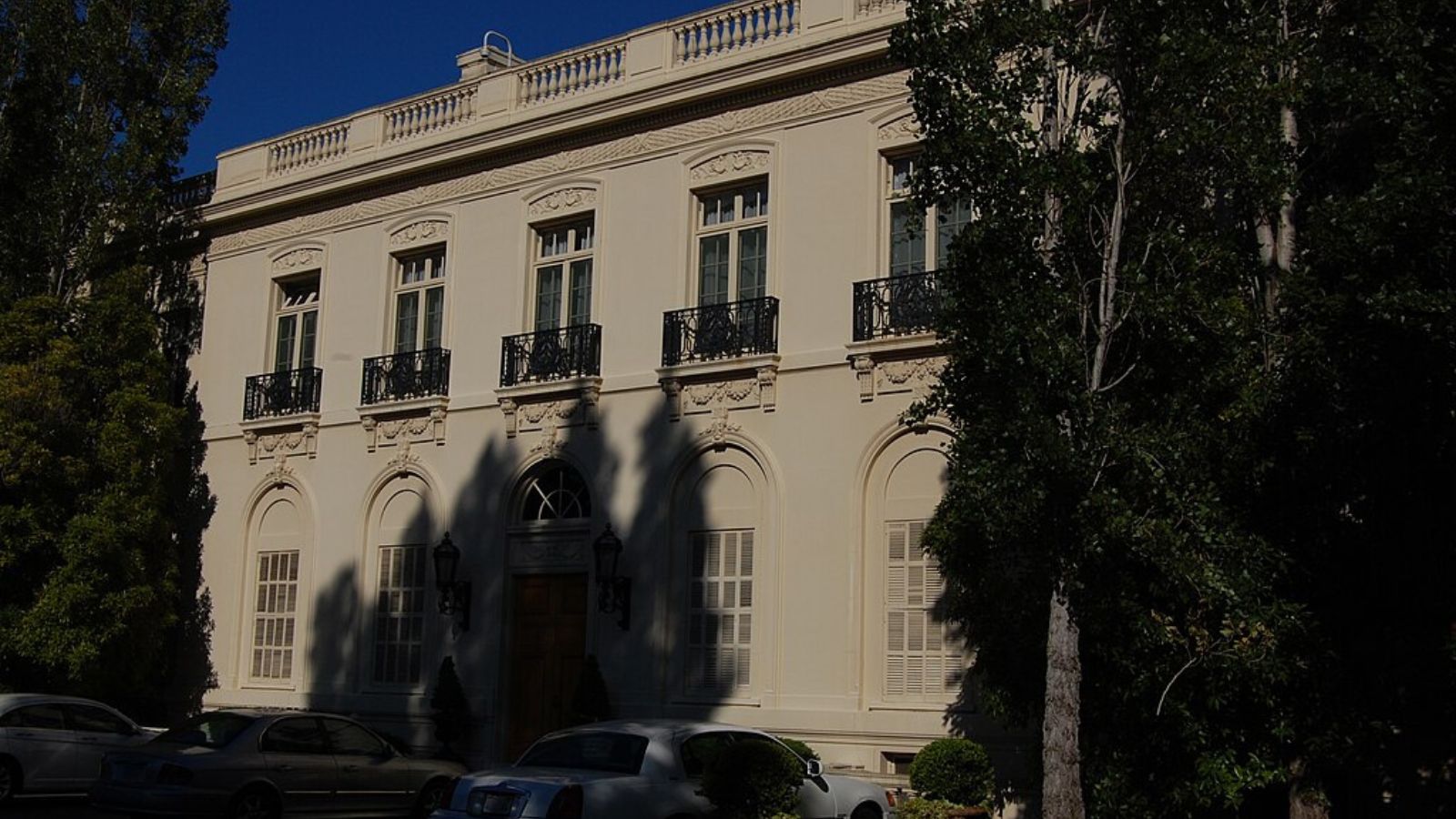
Why are people willing to pay so much to live here? What’s special about it?
Hillsborough offers estate-style living on large lots with historic mansions and custom homes that provide exceptional privacy while maintaining proximity to San Francisco and Silicon Valley employment centers. The community features tree-lined streets, architectural diversity, and recreational amenities that attract old money families and successful entrepreneurs. Residents value the combination of established prestige, natural beauty, and convenient access to major business districts.
Strict zoning requirements with large minimum lot sizes ensure low density and preserve the community’s estate character. The combination of historical significance, architectural quality, and strategic location creates sustained demand among wealthy buyers seeking established luxury suburban living with urban accessibility.
How Hillsborough Rose to Prominence
Hillsborough was incorporated in 1910 as an exclusive residential community for wealthy San Francisco families seeking country estates within commuting distance of the city. The community’s development emphasized large lots, quality architecture, and natural preservation that established its reputation as one of California’s premier residential destinations. Early residents included prominent business leaders and socialites who built grand estates that remain community landmarks.
The post-war technology boom brought Silicon Valley executives and entrepreneurs who appreciated the community’s combination of established prestige and proximity to emerging tech centers. The commitment to maintaining large lots, architectural quality, and environmental preservation created a unique residential environment that continues to attract affluent professionals and established wealth.
3 Interesting Tidbits
1. Mansion Heritage – The community features numerous historic estates and architecturally significant homes that reflect diverse periods and styles of luxury residential construction.
2. Minimum Lot Size – Hillsborough requires minimum one-acre lots for new construction, ensuring that the community maintains its estate-style character and low density.
3. Crystal Springs – The community borders Crystal Springs Reservoir, providing residents with protected open space and recreational opportunities that enhance property values.
3. Montecito – 136% Home Price Increase Since 2010
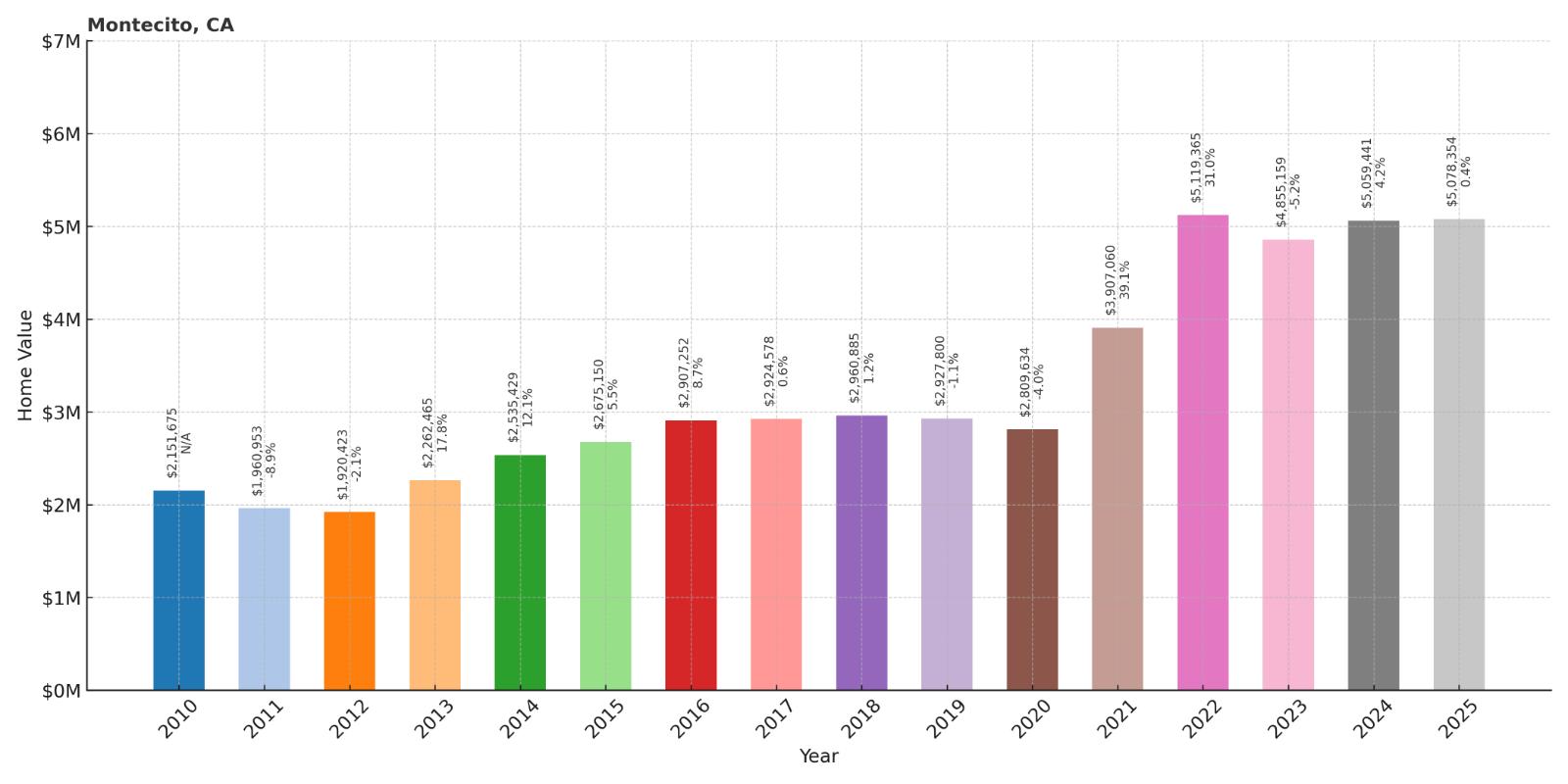
- 2010: $2,151,675
- 2011: $1,960,953
- 2012: $1,920,423
- 2013: $2,262,465
- 2014: $2,535,429
- 2015: $2,675,150
- 2016: $2,907,252
- 2017: $2,924,578
- 2018: $2,960,885
- 2019: $2,927,800
- 2020: $2,809,634
- 2021: $3,907,060
- 2022: $5,119,365
- 2023: $4,855,159
- 2024: $5,059,441
- 2025: $5,078,354
Montecito has shown remarkable appreciation since 2010, more than doubling in value over the 15-year period. The exclusive Santa Barbara County community experienced explosive growth during 2021-2022 when prices surged over 75% in two years, reaching current median values around $5.08 million. The sustained demand reflects the community’s appeal as a celebrity retreat with exceptional natural beauty and luxury amenities.
Why Montecito?

Why are people willing to pay so much to live here? What’s special about it?
Montecito combines stunning coastal and mountain scenery with large estate properties that provide ultimate privacy while maintaining proximity to Santa Barbara’s cultural amenities. The community attracts celebrities, business leaders, and affluent retirees seeking sophisticated country living with Mediterranean climate year-round. Residents enjoy world-class dining, shopping, and recreational opportunities while living on expansive properties with custom homes and extensive landscaping.
Limited developable land between mountains and ocean creates natural scarcity that supports premium pricing. The combination of celebrity cachet, natural beauty, and luxury amenities ensures sustained demand among wealthy buyers seeking the ultimate California retreat experience.
How Montecito Rose to Prominence
Montecito developed in the late 1800s as a resort destination for wealthy families seeking Mediterranean climate and scenic beauty. The arrival of railroad service brought increased accessibility while large estate development attracted prominent families who built grand homes and extensive gardens. Early residents included industrialists and socialites who established the community’s reputation for luxury and exclusivity.
The post-war entertainment industry boom brought Hollywood celebrities and media personalities who discovered Montecito’s combination of privacy, beauty, and sophistication. The community’s association with celebrity residents and its frequent appearance in popular media created global recognition that continues to attract affluent buyers and maintain premium property values.
3 Interesting Tidbits
1. Oprah’s Estate – Media mogul Oprah Winfrey’s famous “Promised Land” estate exemplifies the grand scale and luxury that defines Montecito living.
2. Lotusland – The spectacular botanical garden created by Madame Ganna Walska showcases the community’s commitment to horticulture and natural beauty.
3. Royal Connection – Prince Harry and Meghan Markle’s residence in Montecito has reinforced the community’s status as a global celebrity destination.
2. Los Altos Hills – 136% Home Price Increase Since 2010
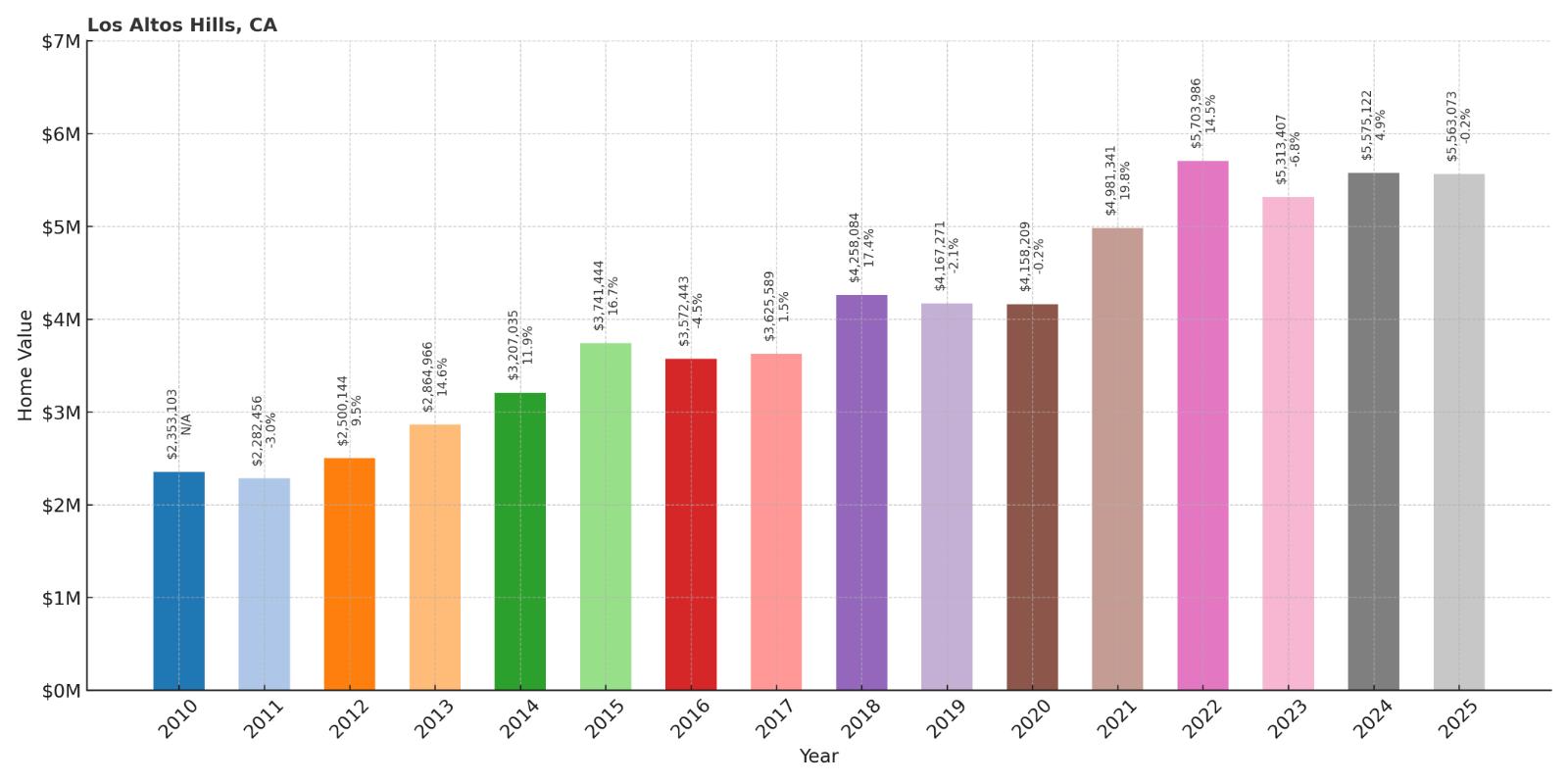
- 2010: $2,353,103
- 2011: $2,282,456
- 2012: $2,500,144
- 2013: $2,864,966
- 2014: $3,207,035
- 2015: $3,741,444
- 2016: $3,572,443
- 2017: $3,625,589
- 2018: $4,258,084
- 2019: $4,167,271
- 2020: $4,158,209
- 2021: $4,981,341
- 2022: $5,703,986
- 2023: $5,313,407
- 2024: $5,575,122
- 2025: $5,563,073
Los Altos Hills has shown steady appreciation since 2010, more than doubling in value over the 15-year period despite starting from a premium baseline. The Santa Clara County community experienced consistent growth with particularly strong gains during 2014-2015, 2017-2018, and 2021-2022, reaching current median values around $5.56 million. The market demonstrates exceptional stability and sustained demand among Silicon Valley’s most affluent residents.
Why Los Altos Hills?

Why are people willing to pay so much to live here? What’s special about it?
Los Altos Hills provides expansive hillside estates with panoramic valley views while maintaining proximity to major Silicon Valley employers and excellent schools. The community features large lots, custom homes, and equestrian facilities that create a rural luxury environment for affluent families. Residents enjoy exceptional privacy, recreational opportunities, and easy access to both technology industry centers and cultural amenities throughout the Bay Area.
Strict development controls with large minimum lot requirements ensure low density and preserve the community’s rural character. The concentration of technology industry wealth and the area’s reputation for quality construction create sustained demand among high-net-worth buyers seeking luxury country living with urban accessibility.
How Los Altos Hills Rose to Prominence
Los Altos Hills was incorporated in 1956 as an exclusive residential community designed to preserve rural character while providing luxury housing for Silicon Valley professionals. The community’s development emphasized large lots, environmental preservation, and quality construction that distinguished it from typical suburban developments. Early residents included technology industry pioneers and business executives who valued privacy and natural beauty.
The emergence of Silicon Valley as a global technology center transformed Los Altos Hills into a preferred location for industry leaders and successful entrepreneurs. The community’s commitment to low density, excellent schools, and environmental protection created a unique residential environment that continues to attract affluent tech industry families and established wealth.
3 Interesting Tidbits
1. Rural Zoning – The community maintains rural zoning with large minimum lot sizes that preserve open space and country atmosphere despite urban proximity.
2. Foothill College – The nearby community college provides educational and cultural resources while maintaining the area’s commitment to learning and development.
3. Valley Views – Many properties offer spectacular views of Silicon Valley and San Francisco Bay, showcasing the area’s strategic hillside location.
1. Atherton – 147% Home Price Increase Since 2010
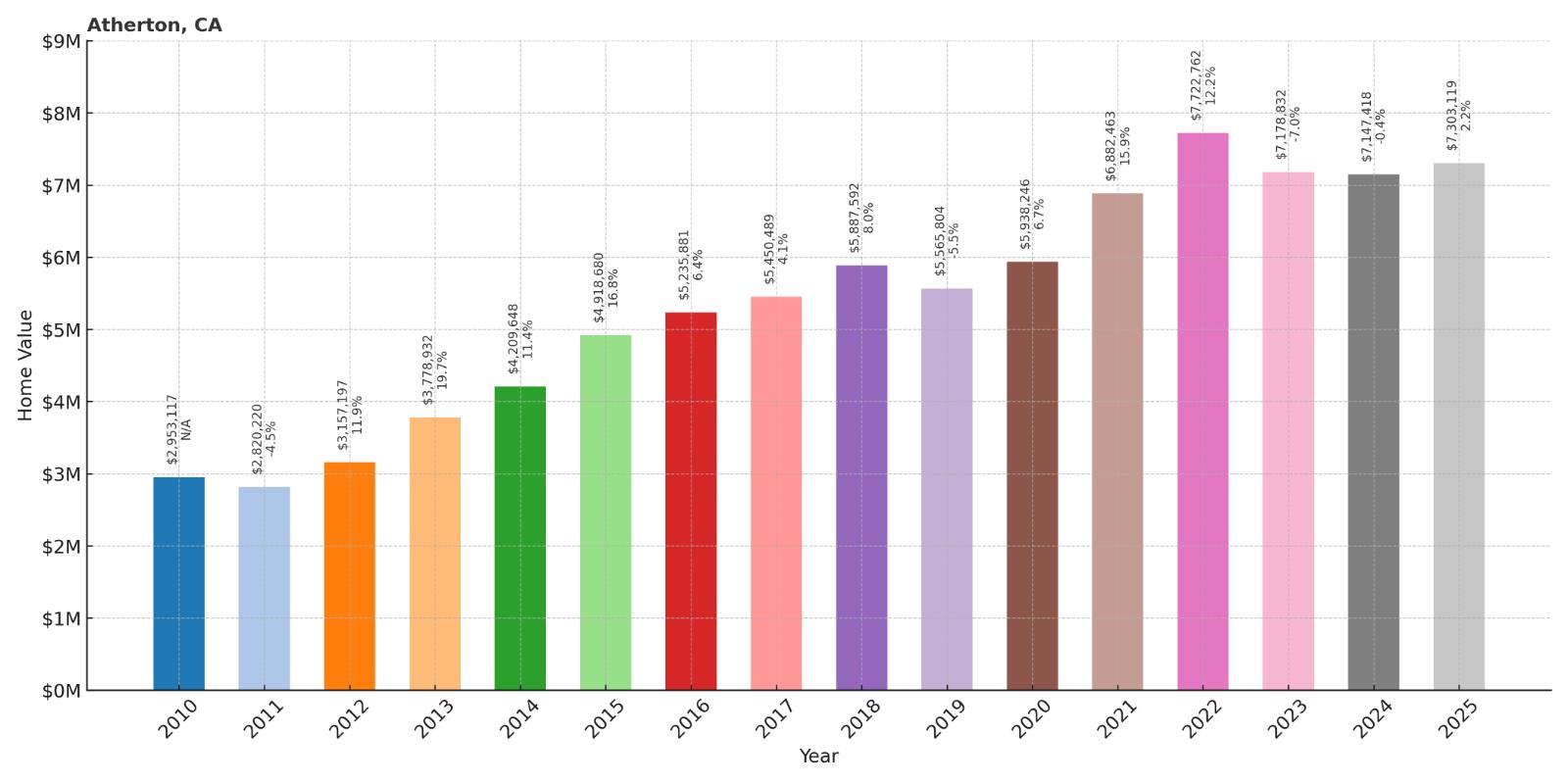
- 2010: $2,953,117
- 2011: $2,820,220
- 2012: $3,157,197
- 2013: $3,778,932
- 2014: $4,209,648
- 2015: $4,918,680
- 2016: $5,235,881
- 2017: $5,450,489
- 2018: $5,887,592
- 2019: $5,565,804
- 2020: $5,938,246
- 2021: $6,882,463
- 2022: $7,722,762
- 2023: $7,178,832
- 2024: $7,147,418
- 2025: $7,303,119
Atherton stands alone at the pinnacle of California real estate, with home values more than doubling since 2010 despite starting from the highest baseline. The San Mateo County community has maintained consistent growth with particularly strong appreciation during 2014-2016 and 2021-2022, reaching current median values around $7.30 million. The market demonstrates exceptional resilience and sustained demand among America’s wealthiest technology industry leaders and established affluent families.
Why Atherton?
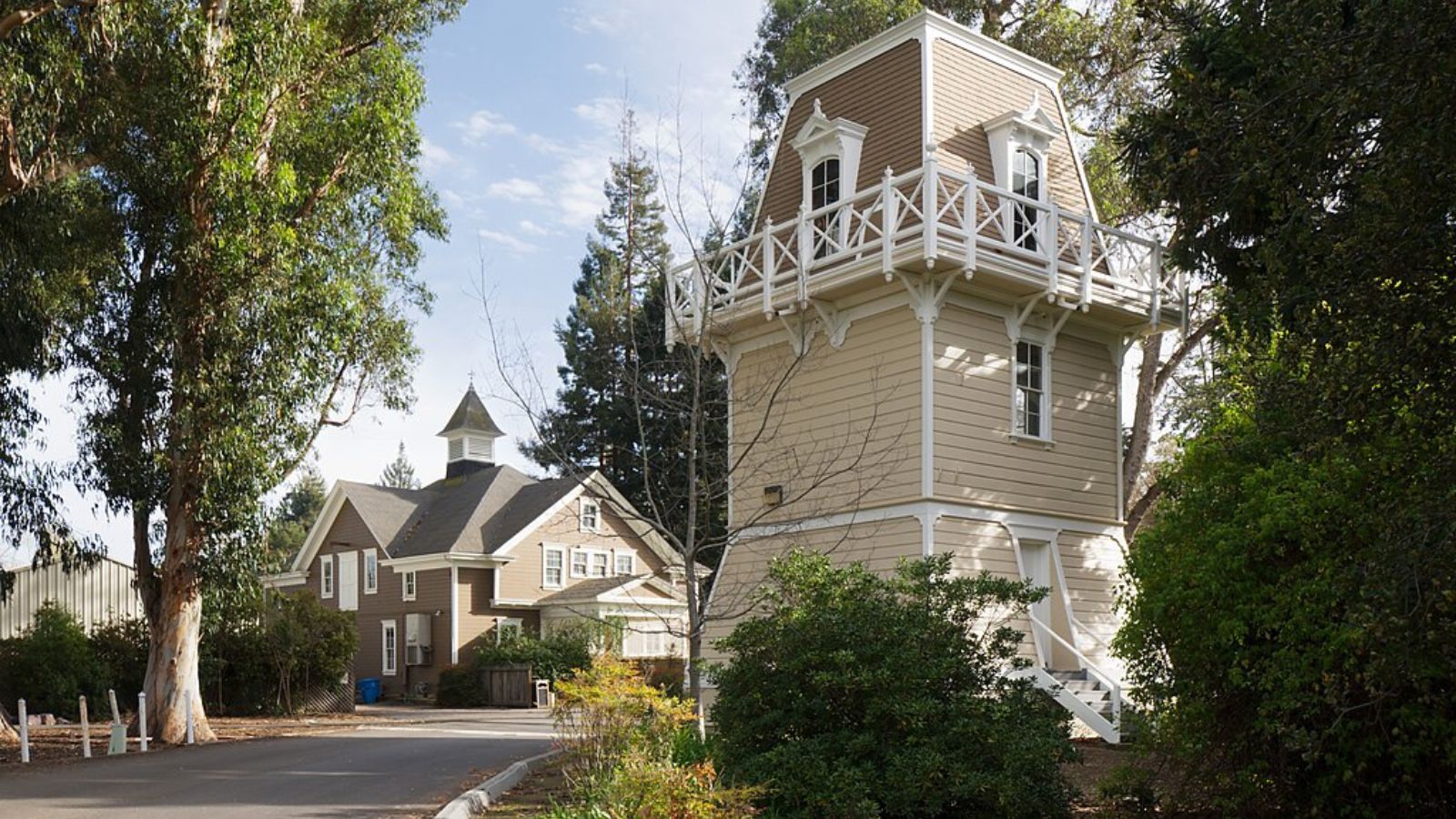
Why are people willing to pay so much to live here? What’s special about it?
Atherton represents the absolute pinnacle of luxury suburban living, combining massive estate properties with ultimate privacy while maintaining proximity to Silicon Valley’s major employers and San Francisco’s cultural amenities. The community features tree-lined streets, architectural diversity, and recreational facilities that attract technology billionaires, venture capitalists, and established wealthy families. Residents enjoy exceptional security, educational excellence, and sophisticated amenities that define America’s most exclusive residential destination.
Extremely limited housing inventory with large minimum lot requirements creates exceptional scarcity among the nation’s wealthiest buyers. The concentration of technology industry wealth, venture capital, and established family fortunes ensures sustained competition for properties that represent the ultimate status symbol in American residential real estate.
How Atherton Rose to Prominence
Atherton was established in the 1860s as an exclusive residential community for wealthy San Francisco families seeking country estates within reasonable commuting distance of the city. The area’s development emphasized large lots, quality architecture, and natural preservation that attracted prominent business leaders and socialites. Early residents included railroad magnates and industrial pioneers who built grand estates that established the community’s luxury reputation.
The transformation of Silicon Valley into the global technology epicenter cemented Atherton’s position as America’s most expensive residential community. Technology entrepreneurs, venture capitalists, and industry executives who created extraordinary wealth chose Atherton for its combination of privacy, prestige, and proximity to innovation centers. This concentration of global technology wealth continues to drive unprecedented property values and maintain Atherton’s status as the ultimate luxury address.
3 Interesting Tidbits
1. Wealthiest Zip Code – Atherton consistently ranks as one of America’s wealthiest zip codes, with residents including technology billionaires and global business leaders.
2. Estate Scale – The community requires minimum one-acre lots, ensuring that properties maintain estate-scale development and exceptional privacy for residents.
3. Tech Royalty – Residents have included Google founders, Facebook executives, and other technology industry pioneers who shaped the global digital economy.




